Paul van Yperen's Blog, page 91
April 5, 2023
Ice Age - The Meltdown (2006)
The American computer-animated adventure comedy Ice Age: The Meltdown (Carlos Saldanha, 2006) is the sequel to Ice Age (Chris Wedge, Carlos Saldanha, 2002), both produced by Blue Sky Studios and distributed by 20th Century Fox. Manny, Sid and Diego discover that the ice age is coming to an end, and join everybody for a journey to higher ground. On the trip, they discover that Manny is not in fact the last of the woolly mammoths. Ice Age: The Meltdown was the third highest-grossing film of 2006 and the highest-grossing animated film of that year.

French postcard by Sonis, no. C. 1702. Photo: Twentieth Century Fox Film Corporation. Scrat in Ice Age: The Meltdown (Carlos Saldanha, 2006). Caption: Ice Age is coming.
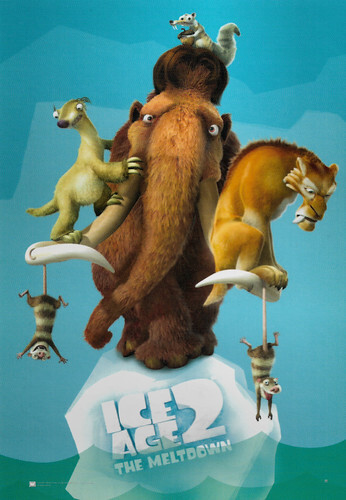
French postcard by Sonis, no. C 1701. Photo: Twentieth Century Fox Film Corporation. Publicity image for Ice Age: The Meltdown (Carlos Saldanha, 2006).
The gang is back
In Ice Age: The Meltdown (Carlos Saldanha, 2006), the gang is back. Manny the woolly mammoth, Sid the sloth, Diego the sabre-toothed tiger, and the acorn-loving squirrel Scrat are still together and enjoying the perks of their now melting world.
Manny may be ready to start a family, but nobody has seen another mammoth for a long time; Manny thinks he may be the last one. That is until he miraculously finds Ellie, the only female mammoth left in the world.
Their only problems: They can't stand each other - and Ellie somehow thinks she's a possum! Ellie comes with some excess baggage in the form of her two possums "brothers" - Crash and Eddie, a couple of daredevil pranksters and cocky, loud-mouthed troublemakers.
Manny, Sid and Diego quickly learn that the warming climate has one major drawback: A huge glacial dam holding off oceans of water is about to break, threatening the entire valley. The only chance of survival lies at the other end of the valley.
So our three heroes, along with Ellie, Crash and Eddie, form the most unlikely family - in any "Age" - as they embark on a mission across an ever-changing, increasingly dangerous landscape towards their salvation.

German postcard by ZigZag posters, no. IA2 07. Photo: Twentieth Century Fox Film Corporation. Publicity image for Ice Age: The Meltdown (Carlos Saldanha, 2006).
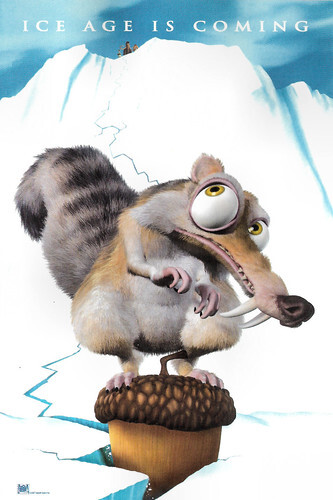
German postcard by Zigzag Posters, no. IA2 01. Photo: Twentieth Century Fox Film Corporation. Scrat in Ice Age: The Meltdown (Carlos Saldanha, 2006). Caption: Ice Age is coming.

German postcard by ZigZag posters, no. IA2 07. Photo: Twentieth Century Fox Film Corporation. Publicity image for Ice Age: The Meltdown (Carlos Saldanha, 2006).
Scrat steals most of the scenes
Ice Age: The Meltdown (Carlos Saldanha, 2006) is the funny sequel to Ice Age, with many hilarious situations. Again, the squirrel Scrat steals most of the scenes, recalling the MGM animated theatrical shorts cartoons of Tom & Jerry.
The Possums and their big "sister" are excellent new characters, providing their own share of the laughs. Sid is brilliant, his mini adventure a definite highlight. Diego's role is reduced, but still vital.
The film received mixed reviews from critics. Roger Ebert: "The movie is nice to look at, the colors and details are elegant, the animals engaging, the action fast-moving, but I don't think older viewers will like it as much as the kids. The first Ice Age movie more or less exhausted these characters and their world, and the meltdown doesn't add much.
Most of the conflict involves personalities: Can these species co-exist? Well, of course, they can, in a cartoon. And if global warming simply means they don't have to freeze their butts off all the time and there are more acorns for Scrat, then what's the problem?"
The film grossed $660.9 million worldwide, marking it the third highest-grossing film of 2006 and the highest-grossing animated film of 2006. It was followed by another sequel, Ice Age: Dawn of the Dinosaurs in 2009.
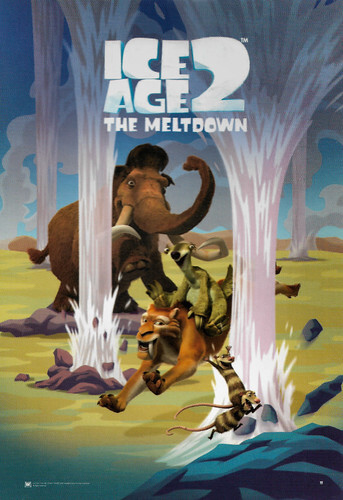
French postcard by Sonis, no. C. 1704. Photo: Twentieth Century Fox Film Corporation. Publicity image for Ice Age: The Meltdown (Carlos Saldanha, 2006).
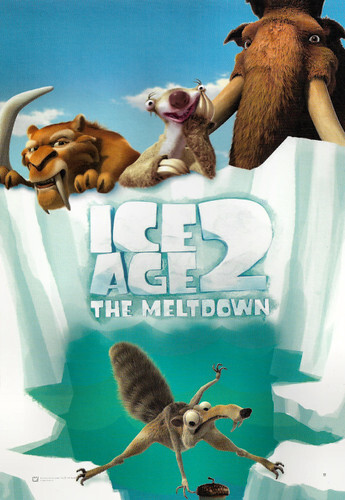
French postcard by Sonis, no. C.1703. Photo: Twentieth Century Fox Film Corporation. Publicity image for Ice Age: The Meltdown (Carlos Saldanha, 2006).
Sources: Roger Ebert (RogerEbert.com), Wikipedia and IMDb.

French postcard by Sonis, no. C. 1702. Photo: Twentieth Century Fox Film Corporation. Scrat in Ice Age: The Meltdown (Carlos Saldanha, 2006). Caption: Ice Age is coming.

French postcard by Sonis, no. C 1701. Photo: Twentieth Century Fox Film Corporation. Publicity image for Ice Age: The Meltdown (Carlos Saldanha, 2006).
The gang is back
In Ice Age: The Meltdown (Carlos Saldanha, 2006), the gang is back. Manny the woolly mammoth, Sid the sloth, Diego the sabre-toothed tiger, and the acorn-loving squirrel Scrat are still together and enjoying the perks of their now melting world.
Manny may be ready to start a family, but nobody has seen another mammoth for a long time; Manny thinks he may be the last one. That is until he miraculously finds Ellie, the only female mammoth left in the world.
Their only problems: They can't stand each other - and Ellie somehow thinks she's a possum! Ellie comes with some excess baggage in the form of her two possums "brothers" - Crash and Eddie, a couple of daredevil pranksters and cocky, loud-mouthed troublemakers.
Manny, Sid and Diego quickly learn that the warming climate has one major drawback: A huge glacial dam holding off oceans of water is about to break, threatening the entire valley. The only chance of survival lies at the other end of the valley.
So our three heroes, along with Ellie, Crash and Eddie, form the most unlikely family - in any "Age" - as they embark on a mission across an ever-changing, increasingly dangerous landscape towards their salvation.

German postcard by ZigZag posters, no. IA2 07. Photo: Twentieth Century Fox Film Corporation. Publicity image for Ice Age: The Meltdown (Carlos Saldanha, 2006).

German postcard by Zigzag Posters, no. IA2 01. Photo: Twentieth Century Fox Film Corporation. Scrat in Ice Age: The Meltdown (Carlos Saldanha, 2006). Caption: Ice Age is coming.

German postcard by ZigZag posters, no. IA2 07. Photo: Twentieth Century Fox Film Corporation. Publicity image for Ice Age: The Meltdown (Carlos Saldanha, 2006).
Scrat steals most of the scenes
Ice Age: The Meltdown (Carlos Saldanha, 2006) is the funny sequel to Ice Age, with many hilarious situations. Again, the squirrel Scrat steals most of the scenes, recalling the MGM animated theatrical shorts cartoons of Tom & Jerry.
The Possums and their big "sister" are excellent new characters, providing their own share of the laughs. Sid is brilliant, his mini adventure a definite highlight. Diego's role is reduced, but still vital.
The film received mixed reviews from critics. Roger Ebert: "The movie is nice to look at, the colors and details are elegant, the animals engaging, the action fast-moving, but I don't think older viewers will like it as much as the kids. The first Ice Age movie more or less exhausted these characters and their world, and the meltdown doesn't add much.
Most of the conflict involves personalities: Can these species co-exist? Well, of course, they can, in a cartoon. And if global warming simply means they don't have to freeze their butts off all the time and there are more acorns for Scrat, then what's the problem?"
The film grossed $660.9 million worldwide, marking it the third highest-grossing film of 2006 and the highest-grossing animated film of 2006. It was followed by another sequel, Ice Age: Dawn of the Dinosaurs in 2009.

French postcard by Sonis, no. C. 1704. Photo: Twentieth Century Fox Film Corporation. Publicity image for Ice Age: The Meltdown (Carlos Saldanha, 2006).

French postcard by Sonis, no. C.1703. Photo: Twentieth Century Fox Film Corporation. Publicity image for Ice Age: The Meltdown (Carlos Saldanha, 2006).
Sources: Roger Ebert (RogerEbert.com), Wikipedia and IMDb.
Published on April 05, 2023 22:00
April 4, 2023
Ultus (1915-1917)
A man called Ultus is robbed and left for dead in the desert, but he returns from Hell and becomes an implacable avenger. Ultus was the creation of British director George Pearson, who worked in the 1910s for Gaumont British, a subsidiary of the famous French firm. Managing director Léon Gaumont had asked Pearson to create an equivalent of Fantomas for British cinema, so Pearson devised Ultus. He found his perfect Ultus in actor Aurele Sydney a.k.a. Aurelio Sydney and together, they made the serial Ultus, the Man from the Dead (1915) – of which some fragments have been found. Sydney's screen apparition was electrifying, with his Herculean physique, his eagle-like profile, his seemingly effortless coping with the most extraordinary adventures, and his incredible swiftness and coolness. George Pearson and Aurele Sydney went on with Ultus and the Grey Lady (1916), Ultus and the Secret of Night (1916), and Ultus and the Three Button Mystery (1917). Sydney was nicknamed the English Maciste, indeed competing with Fantomas and Judex. The Ultus films were a big international success and Sydney became the best-paid actor in the British Empire.
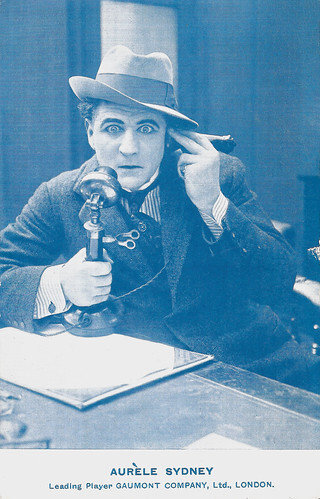
British postcard. Photo: Gaumont Company, London.
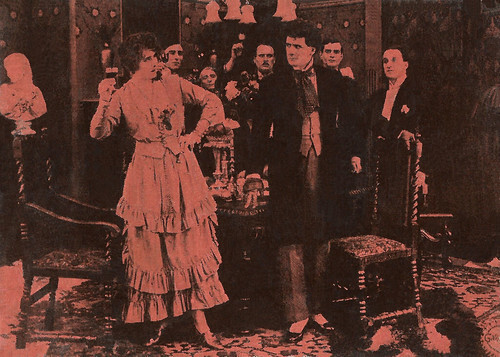
Spanish collector's card (cromo) for Chocolate Pi, series 3, no. 3. Photo: Gaumont. Aurele (or Aurelio) Sydney as Ultus and Mary Dibley as The Grey Lady - Mary Ferris in the serial Ultus and the Grey Lady (George Pearson, 1916). Spanish title: Ultus y la dama gris.
In Ultus and the Grey Lady (George Pearson, 1916), Ultus is hunting Eugene Lester, the man who betrayed him at the end of the previous film, Ultus, the Man from the Dead (George Pearson, 1915). The traitor has hired Conway Bass the detective to protect him. The Grey Lady and her followers take an interest in Ultus and his quest...
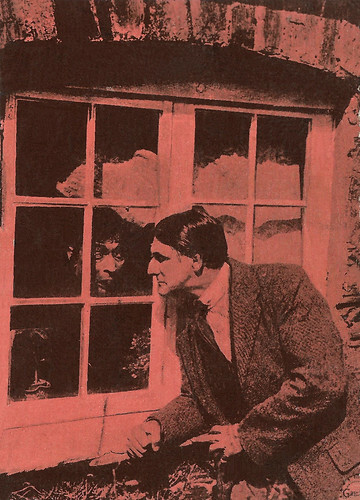
Spanish collector's card (cromo) for Chocolate Pi, series 4, card 4. Photo: Gaumont. Scene card for Ultus and the Grey Lady, II/The Track of Lester (George Pearson, 1916), starring Aurele Sydney . Spanish title: La pista de Lester.
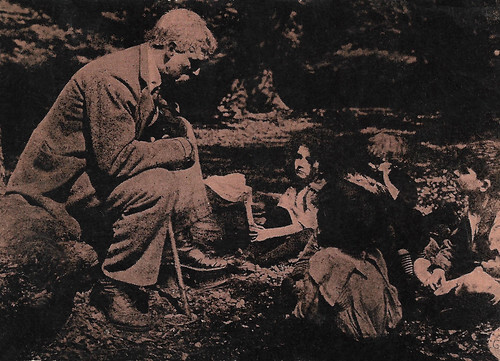
Spanish collector's card (cromo) for Chocolate Pi, series 5, no. 1. Photo: Gaumont. Aurele Sydney in the serial Ultus and the Secret of the Night (George Pearson, 1917). Spanish title: El secreto de la noche.
In Ultus and the Secret of the Night (George Pearson, 1917), Ultus is still being pursued by detective Conway Bass and decides to hide out in disguise in a quiet country village, but he hears stories from the local children of a ghost haunting a mysterious manor. Little daunted, he investigates and discovers that the source of the screams is a mistreated little girl whom he determines to rescue from her abductors...
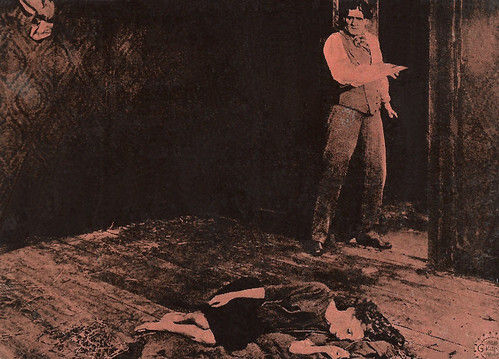
Spanish collector's card (cromo) for Chocolate Pi, series 5, no. 3. Photo: Gaumont. Aurele Sydney in the serial Ultus and the Secret of the Night (George Pearson, 1917). Spanish title: El secreto de la noche. The girl could be Dolly Morgan.
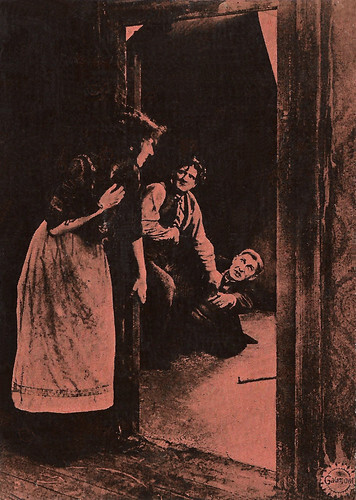
Spanish collector's card (cromo) for Chocolate Pi, series 5, no. 5. Photo: Gaumont. Aurele Sydney in the serial Ultus and the Secret of the Night (George Pearson, 1917). Spanish title: El secreto de la noche.
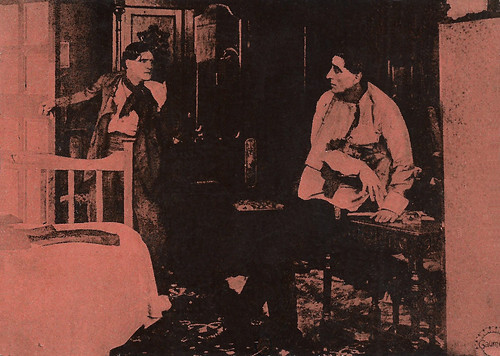
Spanish collector's card (cromo) for Chocolate Pi, series 6 no 5. Photo: Gaumont. Aurele Sydney in the serial The Capture of Ultus/Ultus and the Secret of the Night, II) (George Pearson, 1917. Spanish title: La Captura de Ultus.
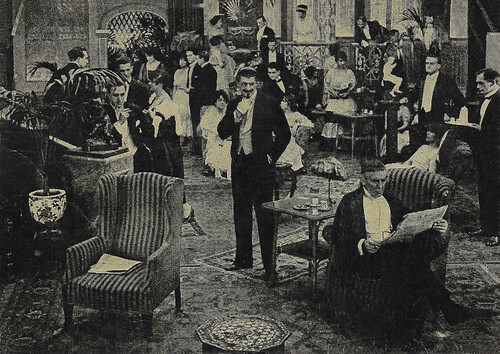
Spanish collector's card (cromo) for Chocolate Pi, series 7, no. 4. Photo: Gaumont. Aurele Sydney in the serial Ultus and the Three-Button Mystery (George Pearson, 1917). Spanish series title: El misterio de los tres botones. On this card, Ultus wears a false moustache and goatee to catch the bad guy.
In Ultus and the Three-Button Mystery (George Pearson, 1917), Ultus makes a daring escape from the Old Bailey. He becomes involved in the case of kidnapping of a Cabinet Minister by the agents of a Foreign Power. He is aided by faithful assistant Dick and the star-struck Elsie Meredith. But Elsie's role is not to be quite what she expects...
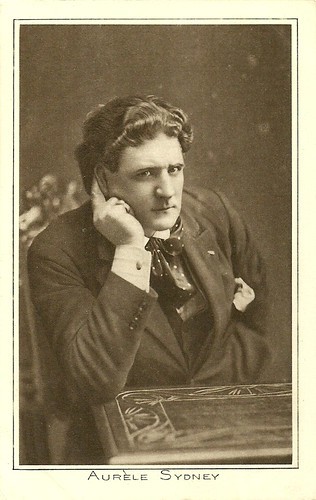
British postcard in the Pictures Portrait Gallery Series by Ed. Pictures Ltd., London, no. 43. Aurele Sydney .
Sources: Vittorio Martinelli, Maciste & Co.; Rachel Low, The History of British Film, 1914-1918; Kevin Brownlow, The Parade’s Gone By; and .

British postcard. Photo: Gaumont Company, London.

Spanish collector's card (cromo) for Chocolate Pi, series 3, no. 3. Photo: Gaumont. Aurele (or Aurelio) Sydney as Ultus and Mary Dibley as The Grey Lady - Mary Ferris in the serial Ultus and the Grey Lady (George Pearson, 1916). Spanish title: Ultus y la dama gris.
In Ultus and the Grey Lady (George Pearson, 1916), Ultus is hunting Eugene Lester, the man who betrayed him at the end of the previous film, Ultus, the Man from the Dead (George Pearson, 1915). The traitor has hired Conway Bass the detective to protect him. The Grey Lady and her followers take an interest in Ultus and his quest...

Spanish collector's card (cromo) for Chocolate Pi, series 4, card 4. Photo: Gaumont. Scene card for Ultus and the Grey Lady, II/The Track of Lester (George Pearson, 1916), starring Aurele Sydney . Spanish title: La pista de Lester.

Spanish collector's card (cromo) for Chocolate Pi, series 5, no. 1. Photo: Gaumont. Aurele Sydney in the serial Ultus and the Secret of the Night (George Pearson, 1917). Spanish title: El secreto de la noche.
In Ultus and the Secret of the Night (George Pearson, 1917), Ultus is still being pursued by detective Conway Bass and decides to hide out in disguise in a quiet country village, but he hears stories from the local children of a ghost haunting a mysterious manor. Little daunted, he investigates and discovers that the source of the screams is a mistreated little girl whom he determines to rescue from her abductors...

Spanish collector's card (cromo) for Chocolate Pi, series 5, no. 3. Photo: Gaumont. Aurele Sydney in the serial Ultus and the Secret of the Night (George Pearson, 1917). Spanish title: El secreto de la noche. The girl could be Dolly Morgan.

Spanish collector's card (cromo) for Chocolate Pi, series 5, no. 5. Photo: Gaumont. Aurele Sydney in the serial Ultus and the Secret of the Night (George Pearson, 1917). Spanish title: El secreto de la noche.

Spanish collector's card (cromo) for Chocolate Pi, series 6 no 5. Photo: Gaumont. Aurele Sydney in the serial The Capture of Ultus/Ultus and the Secret of the Night, II) (George Pearson, 1917. Spanish title: La Captura de Ultus.

Spanish collector's card (cromo) for Chocolate Pi, series 7, no. 4. Photo: Gaumont. Aurele Sydney in the serial Ultus and the Three-Button Mystery (George Pearson, 1917). Spanish series title: El misterio de los tres botones. On this card, Ultus wears a false moustache and goatee to catch the bad guy.
In Ultus and the Three-Button Mystery (George Pearson, 1917), Ultus makes a daring escape from the Old Bailey. He becomes involved in the case of kidnapping of a Cabinet Minister by the agents of a Foreign Power. He is aided by faithful assistant Dick and the star-struck Elsie Meredith. But Elsie's role is not to be quite what she expects...

British postcard in the Pictures Portrait Gallery Series by Ed. Pictures Ltd., London, no. 43. Aurele Sydney .
Sources: Vittorio Martinelli, Maciste & Co.; Rachel Low, The History of British Film, 1914-1918; Kevin Brownlow, The Parade’s Gone By; and .
Published on April 04, 2023 22:00
April 3, 2023
Mia Pankau
Mia Pankau (1891-1974) was a star of the German silent cinema. Most of her films were directed by her husband, Jaap Speyer.
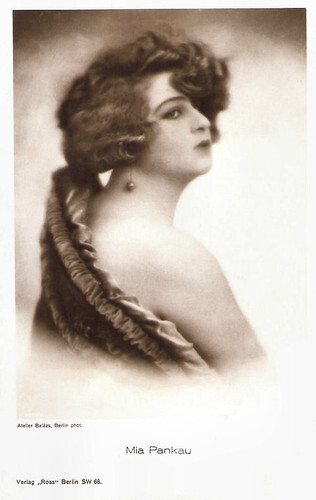
German postcard by Ross Verlag, no. 1031/1, 1927-1928. Photo: Atelier Balázs, Berlin.
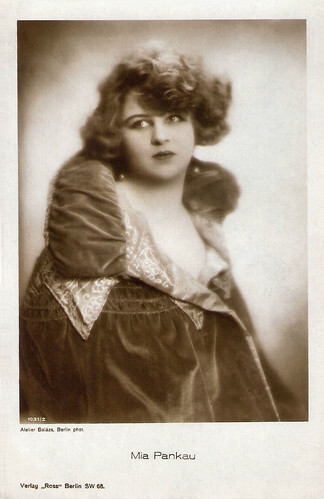
German postcard by Ross Verlag, no. 1031/2, 1927-1928. Photo: Atelier Balázs, Berlin.
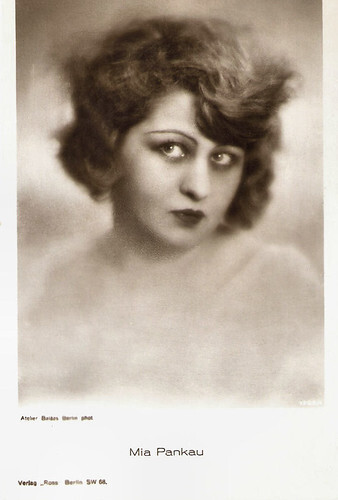
German postcard by Ross Verlag, no. 1755/1, 1927-1928. Photo: Atelier Balázs, Berlin.
When women love and hate
Martha Elisabeth Pankau was born in Friedland, Upper Silesia (now Korfantów in Poland), in 1891.
She made her film debut in 1917 in the film Wenn Frauen lieben und hassen/When Women Love and Hate (1917), directed by Dutch film director Jaap Speyer, with whom she would later marry.
Quite soon she was the leading actress in all of Speyer’s films of the late 1910s. They worked for such companies as Horos Film, Althoff & Co., and the Hamburg-based Vera Filmwerke. Their films include Heddas Rache/Hedda's Revenge (1919) with Reinhold Schünzel , Lilli (1919) and the sequel Lilli’s Ehe/Lilli's Marriage (1919).
In the early 1920s followed the two-parter Zügelloses Blut/Unbridled blood (Jaap Speyer, 1920) with Bernhard Goetzke , Entblätterte Blüten/Stripped Blossoms (Jaap Speyer, 1920), Die rote Nacht/The Red Night (Jaap Speyer, 1921) with Oscar Marion , Das blonde Verhängnis/The Blonde Fate (Jaap Speyer, 1921) opposite Ernst Hofmann , Jimmy, ein Schicksal von Mensch und Tier/Jimmy, a destiny of Man and Animal (Jaap Speyer, 1922), and Der allmächtige Dollar/The Almighty Dollar (Jaap Speyer, 1923).
Incidentally, she played in films by other directors such as Wolfgang Neff (Der Heiratsschwindler/The marriage swindler, 1922), Leo König (Die Hermannschlacht/The Battle of Hermann, 1924), and Friedrich Zelnik (Briefen die ihn nicht erreichten/Letters He Never Received, 1925).
She continued to work with her husband on the films Elegantes Pack/Elegant stack (Jaap Speyer, 1925), Die Moral der Gasse/The Morals of the Alley (Jaap Speyer, 1925) starring Werner Krauss , Hotelratten/Hotel Rats (Jaap Speyer, 1927) with Nils Asther , and Die drei Frauen der Urban Hell/The Three Wives of Urban Hell (Jaap Speyer, 1928).
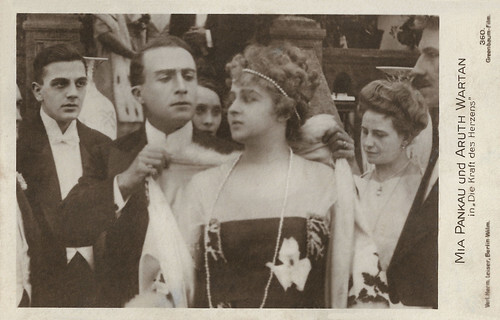
German postcard by Verlag Hermann Leiser, Berlin-Wilm., no. 360. Photo: Greenbaum-Film. Mia Pankau and Aruth Wartan in Die Kraft des Herzens/The power of the heart (Jaap Speyer, 1918).
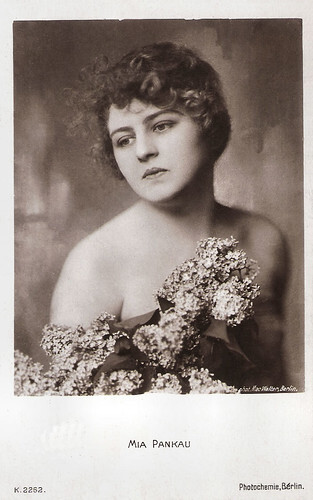
German postcard by Photochemie, Berlin, no. K. 2262. Photo: Mac Walten, Berlin.
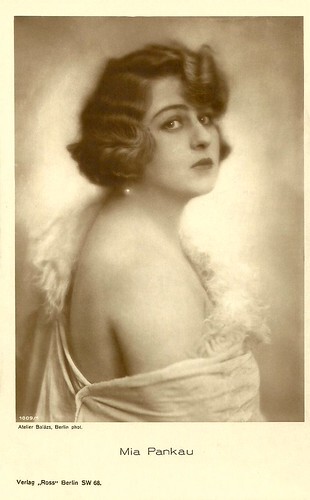
German postcard by Ross Verlag, no. 1009/1, 1927-1928. Photo: Atelier Balázs, Berlin.
White slave trade
In the late 1920s, Mia Pankau appeared in supporting parts in such popular productions as Durchlaucht Radieschen/Highness radish (Richard Eichberg, 1927) starring Xenia Desni, and the Anny Ondra vehicle Der erste Kuss/The First Kiss (Karel Lamac, 1929).
Probably her best known is the fantasy/horror film Alraune/A Daughter of Destiny (Henrik Galeen, 1928) featuring Brigitte Helm . Pankau plays a prostitute who is artificially inseminated by a sociopathic scientist ( Paul Wegener ) with the semen of an executed murderer. As the result, the angelic Alraune ( Brigitte Helm ) is incapable of feeling any real emotions and kills all the men who fall in love with her.
Pankau easily switched from comedy to drama, from war film to horror film, but she had more difficulty switching to sound cinema. She appeared in a short sound film, Besuch um Mitternacht. Nachtgespenst in Berlin/Visit at midnight. The ghost of Berlin (Jaap Speyer, 1930), a film she co-produced herself.
After that she performed only in one sound feature: Tänzerinnen für Süd-Amerika gesucht/Girls For Sale (Jaap Speyer, 1931), again directed by Speyer. She was clearly not the big star any more, as the female lead had gone to Dita Parlo . Pankau played a matchmaker involved in the white slave trade, Parlo a young victim.
After that Mia Pankau retired from the screen. She died in Hoisdorf near Hamburg, Germany in 1974, at the age of 83.
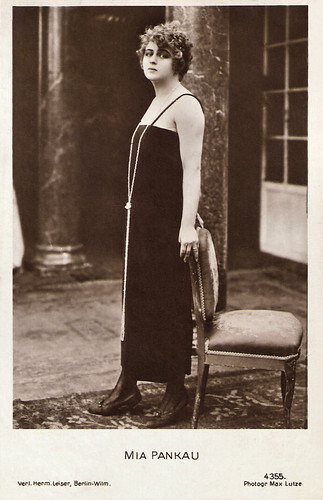
German postcard by Verlag Hermann Leiser, Berlin-Wilm., no. 4355. Photo: Max Lutze.
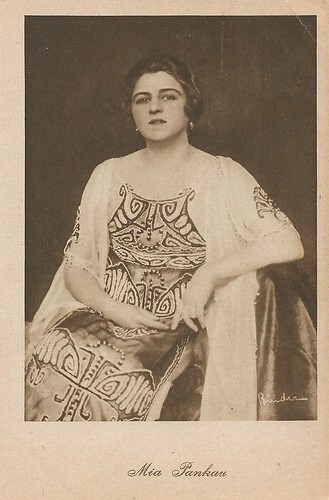
German postcard by Verlag Hermann Wolff, Berlin, no. F.84. Photo: Alex Binder, Berlin. This postcard was sent by mail in 1924.
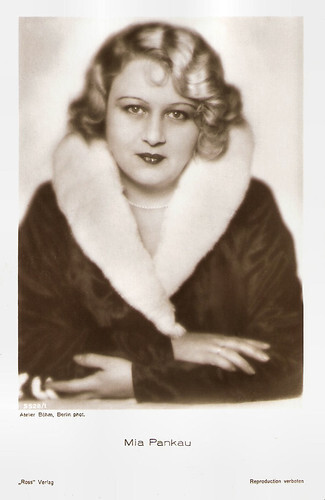
German postcard by Ross Verlag, no. 5528/1, 1930-1931. Photo: Böhm, Berlin.
Sources: Thomas Staedeli (Cyranos), Hal Erickson (AllMovie), Filmportal.de, Wikipedia and .

German postcard by Ross Verlag, no. 1031/1, 1927-1928. Photo: Atelier Balázs, Berlin.

German postcard by Ross Verlag, no. 1031/2, 1927-1928. Photo: Atelier Balázs, Berlin.

German postcard by Ross Verlag, no. 1755/1, 1927-1928. Photo: Atelier Balázs, Berlin.
When women love and hate
Martha Elisabeth Pankau was born in Friedland, Upper Silesia (now Korfantów in Poland), in 1891.
She made her film debut in 1917 in the film Wenn Frauen lieben und hassen/When Women Love and Hate (1917), directed by Dutch film director Jaap Speyer, with whom she would later marry.
Quite soon she was the leading actress in all of Speyer’s films of the late 1910s. They worked for such companies as Horos Film, Althoff & Co., and the Hamburg-based Vera Filmwerke. Their films include Heddas Rache/Hedda's Revenge (1919) with Reinhold Schünzel , Lilli (1919) and the sequel Lilli’s Ehe/Lilli's Marriage (1919).
In the early 1920s followed the two-parter Zügelloses Blut/Unbridled blood (Jaap Speyer, 1920) with Bernhard Goetzke , Entblätterte Blüten/Stripped Blossoms (Jaap Speyer, 1920), Die rote Nacht/The Red Night (Jaap Speyer, 1921) with Oscar Marion , Das blonde Verhängnis/The Blonde Fate (Jaap Speyer, 1921) opposite Ernst Hofmann , Jimmy, ein Schicksal von Mensch und Tier/Jimmy, a destiny of Man and Animal (Jaap Speyer, 1922), and Der allmächtige Dollar/The Almighty Dollar (Jaap Speyer, 1923).
Incidentally, she played in films by other directors such as Wolfgang Neff (Der Heiratsschwindler/The marriage swindler, 1922), Leo König (Die Hermannschlacht/The Battle of Hermann, 1924), and Friedrich Zelnik (Briefen die ihn nicht erreichten/Letters He Never Received, 1925).
She continued to work with her husband on the films Elegantes Pack/Elegant stack (Jaap Speyer, 1925), Die Moral der Gasse/The Morals of the Alley (Jaap Speyer, 1925) starring Werner Krauss , Hotelratten/Hotel Rats (Jaap Speyer, 1927) with Nils Asther , and Die drei Frauen der Urban Hell/The Three Wives of Urban Hell (Jaap Speyer, 1928).

German postcard by Verlag Hermann Leiser, Berlin-Wilm., no. 360. Photo: Greenbaum-Film. Mia Pankau and Aruth Wartan in Die Kraft des Herzens/The power of the heart (Jaap Speyer, 1918).

German postcard by Photochemie, Berlin, no. K. 2262. Photo: Mac Walten, Berlin.

German postcard by Ross Verlag, no. 1009/1, 1927-1928. Photo: Atelier Balázs, Berlin.
White slave trade
In the late 1920s, Mia Pankau appeared in supporting parts in such popular productions as Durchlaucht Radieschen/Highness radish (Richard Eichberg, 1927) starring Xenia Desni, and the Anny Ondra vehicle Der erste Kuss/The First Kiss (Karel Lamac, 1929).
Probably her best known is the fantasy/horror film Alraune/A Daughter of Destiny (Henrik Galeen, 1928) featuring Brigitte Helm . Pankau plays a prostitute who is artificially inseminated by a sociopathic scientist ( Paul Wegener ) with the semen of an executed murderer. As the result, the angelic Alraune ( Brigitte Helm ) is incapable of feeling any real emotions and kills all the men who fall in love with her.
Pankau easily switched from comedy to drama, from war film to horror film, but she had more difficulty switching to sound cinema. She appeared in a short sound film, Besuch um Mitternacht. Nachtgespenst in Berlin/Visit at midnight. The ghost of Berlin (Jaap Speyer, 1930), a film she co-produced herself.
After that she performed only in one sound feature: Tänzerinnen für Süd-Amerika gesucht/Girls For Sale (Jaap Speyer, 1931), again directed by Speyer. She was clearly not the big star any more, as the female lead had gone to Dita Parlo . Pankau played a matchmaker involved in the white slave trade, Parlo a young victim.
After that Mia Pankau retired from the screen. She died in Hoisdorf near Hamburg, Germany in 1974, at the age of 83.

German postcard by Verlag Hermann Leiser, Berlin-Wilm., no. 4355. Photo: Max Lutze.

German postcard by Verlag Hermann Wolff, Berlin, no. F.84. Photo: Alex Binder, Berlin. This postcard was sent by mail in 1924.

German postcard by Ross Verlag, no. 5528/1, 1930-1931. Photo: Böhm, Berlin.
Sources: Thomas Staedeli (Cyranos), Hal Erickson (AllMovie), Filmportal.de, Wikipedia and .
Published on April 03, 2023 22:00
April 2, 2023
Directed by Jean Cocteau
French poet, playwright, novelist, designer, filmmaker, visual artist and critic Jean Cocteau (1889-1963) was one of the most multi-talented artists of the 20th century. He is best known for his novels 'Le Grand Écart' (1923), 'Le Livre blanc' (1928), and 'Les Enfants Terribles' (1929); the stage plays 'La Voix Humaine' (1930), 'La Machine Infernale' (1934), 'Les Parents terribles' (1938), and 'L'Aigle à deux têtes' (1946); and the films Le sang d'un poète/The Blood of a Poet (1930), La belle et la bête/Beauty and the Beast (1946), Les Parents Terribles (1948), Orphée/Orpheus (1950), and Le testament d'Orphée/Testament of Orpheus (1960). He collaborated with the Russian Ballet company of Sergei Diaghilev and was one of the creatives of the Surrealist and Dadaist movements, but he always remained a poet at heart.
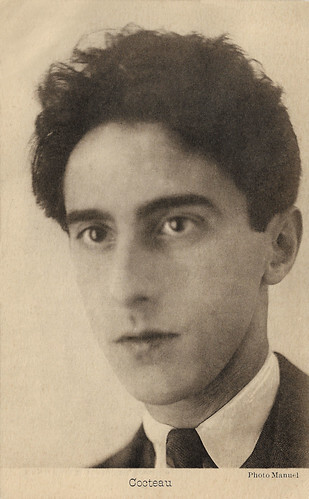
Belgian postcard by Maison d'Art, Bruxelles. Photo: Manuel.
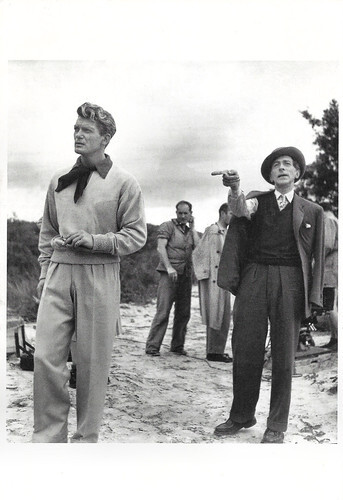
French postcard by Éditions du Désastre, Paris, 1988, no RD 6. Photo: Robert Doisneau, 1949. Jean Cocteau and Jean Marais .
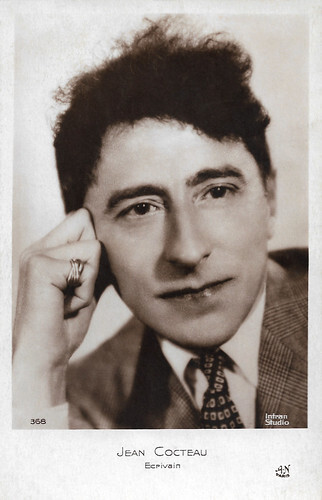
French postcard by A.N., Paris, no. 368. Photo: Intran Studio.
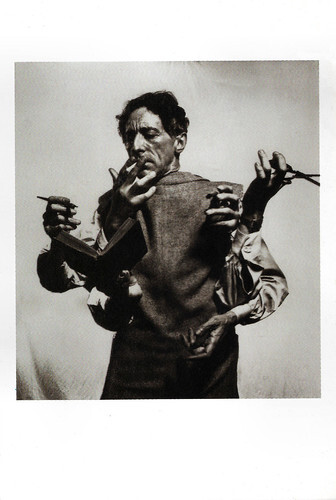
French postcard. Photo montage: Philippe Halsman / Magnum Photos. Caption: The French writer Jean Cocteau in a photographic montage by Philippe Halsman.
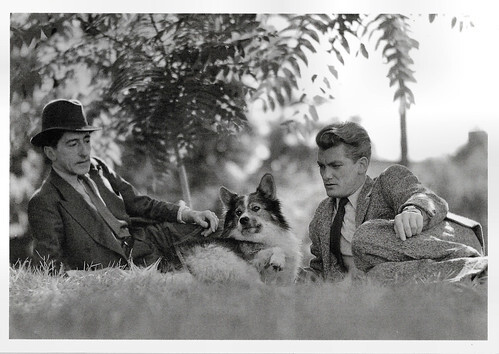
French postcard by Editions Hazan, Paris, in the Collection Magie Noire, no. 1960. Photo: unknown. Jean Cocteau and Jean Marais .
Openly homosexual
Jean Maurice Eugène Cocteau was born in 1889 in Maisons-Laffitte, Seine-et-Oise (now Yvelines), France. Cocteau was born into a middle-class family. Cocteau's father committed suicide when he was about 10 years old. In 1900, he entered a private school and was expelled in 1904. After his expulsion from school, Cocteau ran away to Marseilles where he lived in the red-light district under a false name. Police discovered him in Marseilles and returned him to his uncle's care. Jean began writing at 10 and was a published poet by age 16. From 1908, he was a frequent guest in artistic circles.
Cocteau associated himself with Edouard de Max , a reigning tragedian of the Paris stage at this time. De Max encouraged Cocteau to write and on 4 April 1908, he rented the Theatre Femina for the premiere of the young writer's poetry. In 1909, Cocteau met the Russian impresario Sergei Daighilev who ran the Ballets Russes. In 1911, he wrote the libretto for 'Le dieu bleu, a ballet by the Ballets Russes. In 1917 came 'Parade', an avant-garde ballet by Cocteau, for which Pablo Picasso, among others, designed the sets and costumes and Erik Satie composed the music. In Guillaume Apollinaire's programme booklet, to describe the ballet, the word surréaliste was used for the first time. The ballet was not a great success, but it did establish Cocteau's name in the avant-garde of Paris.
In 1920, Cocteau met the aspiring writer Raymond Radiguet, then aged 17. They collaborated extensively, socialised, and undertook many journeys and vacations together. Cocteau also got Radiguet exempted from military service. After Radiguet released 'Le Diable au corps', a largely autobiographical story of an adulterous relationship between a married woman and a younger man, a period of productivity followed for Cocteau. This stopped in 1923 when Radiguet died of typhoid fever. Cocteau became addicted to opium in the period that followed. During Cocteau's recovery from his opium addiction, the artist created some of his most important works including the stage play 'Orphee' and many long poems.
Cocteau was openly homosexual. He was the author of the mildly homoerotic and semi-autobiographical 'Le Livre blanc' (The White Book), published anonymously in 1928. He never repudiated its authorship and a later edition of the novel features his foreword and drawings. Frequently his work, either literary (Les enfants terribles), graphic (erotic drawings, book illustration, paintings) or cinematographic, is pervaded with homosexual undertones, homoerotic imagery/symbolism or camp.
In 1926, he published 'Le rappel à l'ordre', a book of essays describing the renewed interest in traditions in the post-World War I period. In 1929, Cocteau wrote his best-known work, 'Les Enfants terribles'. In the early 1930s, Cocteau wrote what some believe to be his greatest play, 'La Machine Infernal'. The play was a treatment of the Oedipus theme. Cocteau also wrote 'La voix humaine' (1930, The Human Voice), 'Les chevaliers de la table rounde' (1937, The Knights of the Round Table), 'Les parents terribles' (1938, Intimate Relations), and 'La machine a ecrire' (1941, The Typewriter).
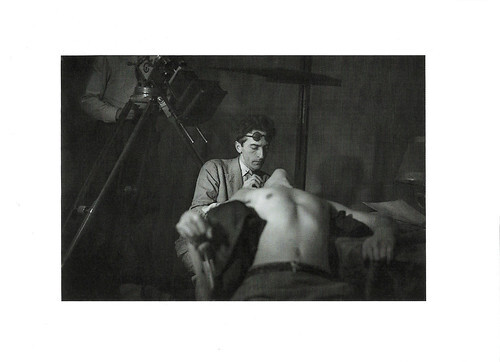
French postcard by Editions du Centre Pompidou, no. CP 2217. Photo: Sacha Masour. Jean Cocteau paints the eyes of Enrique Rivero at the set of Le Sang d'un poète/The Blood of a Poet (Jean Cocteau, 1930).
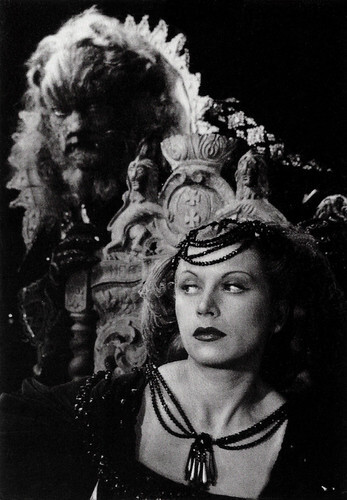
French card, no. C142. Photo: Aldo. Jean Marais and Josette Day in La belle et la bête/Beauty and the Beast (Jean Cocteau, René Clément, 1946).
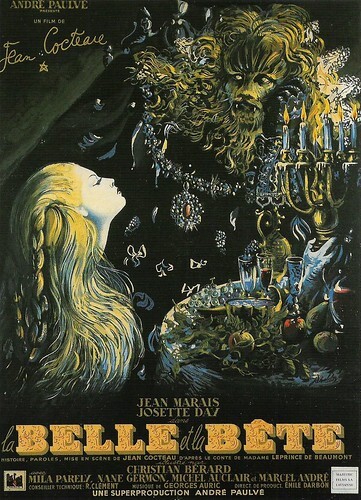
Swiss postcard by CVB Publishers. Image: Collection Cinémathèque Lausanne. French poster for La Belle et la Bête (Jean Cocteau, René Clément, 1946). The poster was designed by Cocteau's friend Jean-Denis Malcles.
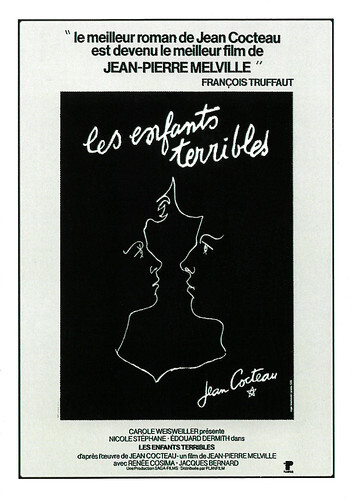
French postcard by Carterie artistique et cinématographique, Pont du Casse, no. EDC 2827. Affiche for Les enfants terribles/The Terrible Children (Jean-Pierre Melville, 1950), based on the play by Jean Cocteau.
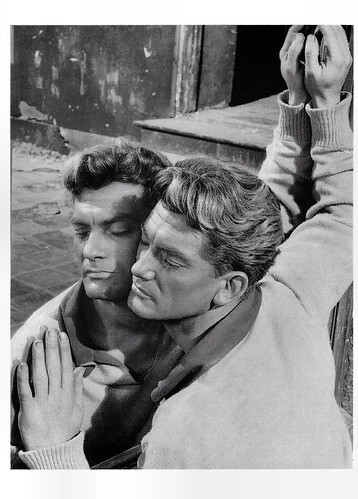
Swiss / British / German postcard by News Productions, Baulmes & Stroud / Filmwelt Berlin, Bakede, no. 56482. Photo: Collection Cinémathèque Suisse, Lausanne. Jean Marais in Orphée/Orpheus (Jean Cocteau, 1950).
The Beauty and the Beast
Jean Cocteau's film debut Le sang d'un poète/The Blood of a Poet (1930) starring Enrique Rivero , was a grand experiment in an effort to capture a young poet's obsession with the struggle between the forces of life and death. He is condemned to walk the halls of the Hotel of Dramatic Follies for his crime of having brought a statue to life. Because of the October 1930 scandal around Luis Buñuel's L'âge d'or (1930) - another film financed by Le Vicomte de Noailles and Marie-Laure de Noailles, the Paris premiere of this film was delayed until January 1932. The film is the first part of Jean Cocteau's Orpheus Trilogy (1932-1960); a loosely connected telling and re-telling of the well-known Greek legend. During the next years, the artist's work lapsed. One reason for this is his recurring addiction to opium.
Wikipedia : "Although in 1938 Cocteau had compared Adolf Hitler to an evil demiurge who wished to perpetrate a Saint Bartholomew's Day massacre against Jews, his friend Arno Breker convinced him that Hitler was a pacifist and patron of the arts with France's best interests in mind. During the Nazi occupation of France, he was in a "round-table" of French and German intellectuals who met at the Georges V Hotel in Paris, including Cocteau, the writers Ernst Jünger, Paul Morand and Henry Millon de Montherlant, the publisher Gaston Gallimard and the Nazi legal scholar Carl Schmitt. In his diary, Cocteau accused France of disrespect towards Hitler and speculated on the Führer's sexuality. Cocteau effusively praised Breker's sculptures in an article entitled 'Salut à Breker' published in 1942. This piece caused him to be arraigned on charges of collaboration after the war, though he was cleared of any wrongdoing and had used his contacts in his failed attempt to save friends such as Max Jacob.
Jean Cocteau's return to work in the 1940s was primarily due to the influence of his protégé and lover Jean Marais , who starred in La belle et la bête/Beauty and the Beast (Jean Cocteau, 1946), based on the eponymous tale by Jeanne-Marie Leprince de Beaumont (1756). Marais played three roles, the Beast, Beauty's suitor, and the Prince, and Josette Day played Belle. The film marked a triumphant return of Cocteau to the screen.
Cocteau and Marais also made L'aigle à deux têtes/The Eagle with Two Heads (Jean Cocteau, 1948) and Les parents terribles/The Storm Within (Jean Cocteau, 1948). In Cocteau's most important film, Orphee/Orpheus (Jean Cocteau, 1950), Jean Marais is a poet who becomes obsessed with a Princess, Death (Maria Casares). They fall in love. Orphee's wife, Eurydice ( Marie Déa ), is killed by the Princess' henchmen and Orphee goes after her into the Underworld. Although they have become dangerously entangled, the Princess sends Orphee back out of the Underworld, to carry on his life with Eurydice.
In 1955, Cocteau became a member of the Académie française and he was also awarded the French Legion of Honour. In his final film, Le testament d'Orphée/Testament of Orpheus (Jean Cocteau, 1959), Cocteau himself played the poet Orpheus who looks back over his life and work, recalling his inspirations and obsessions. Cocteau made about twelve films in his career, all rich with symbolism and surreal imagery.
Jean Cocteau passed away in 1963 at his chateau in Milly-la-Foret, France at the age of 74. He died of a heart after hearing the news of the death of another friend, the singer Edith Piaf . Cocteau's chateau was bought by the government on the initiative of a committee that wants to keep his memory alive. It was inaugurated as a Cocteau museum in 2010. Cocteau's longest-lasting relationships were with French actors Jean Marais and Édouard Dermit, whom Cocteau formally adopted. According to his wishes, Cocteau is buried beneath the floor of the Chapelle Saint-Blaise des Simples in Milly-la-Forêt. The epitaph on his gravestone set on the floor of the chapel reads: "Je reste avec vous" (I stay with you).
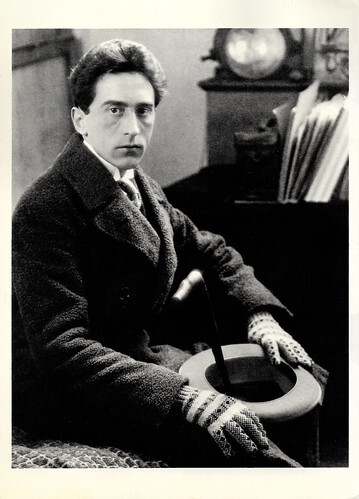
American postcard by Fotofolio, NY, NY, no. MR 37. Photo: Man Ray, 1924.
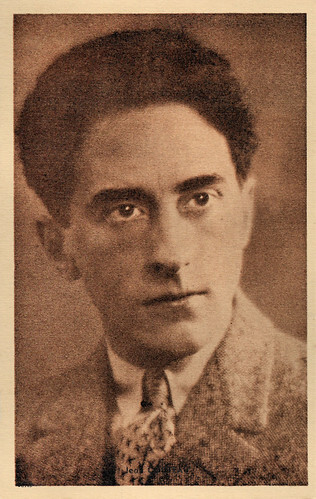
Vintage French postcard. Collection d'Art et d'Histoire, Paris.
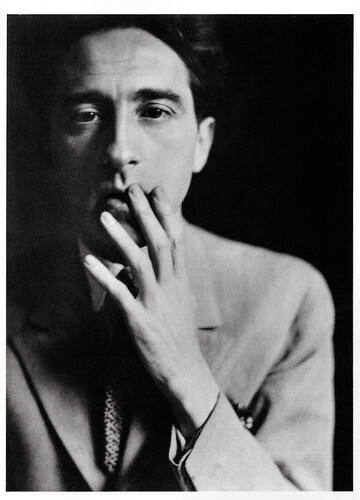
French postcard by Marion-Valentine, Paris, no. N 118. Photo: Germaine Krull / Collection Bibliothèque Nationale. Caption: Jean Cocteau, 1929.
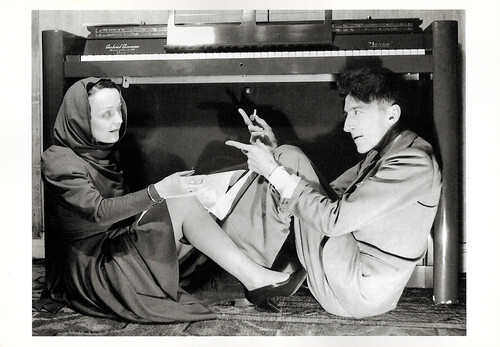
French postcard in the Collection Magie Noire by Editions Hazan, Paris, no. 6037, 1988. Photo: Serge Lido. Caption: Édith Piaf and Jean Cocteau, 1939.
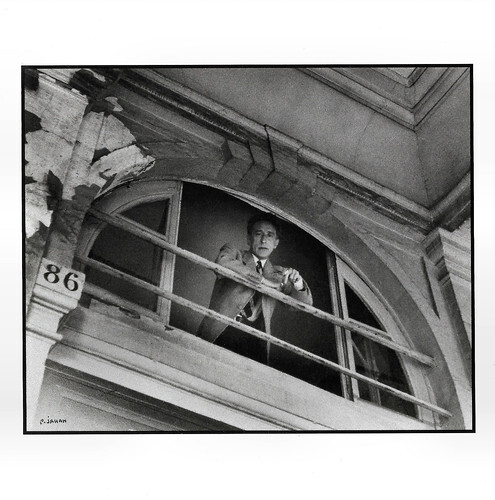
French postcard by Musée Carnavalet, Paris, no IC 40 2125. Photo: Pierre Jahan. Caption: Jean Cocteau in his window, 86, rue de Montparnasse, Palais Royal, Paris (1er arr.), 1941.
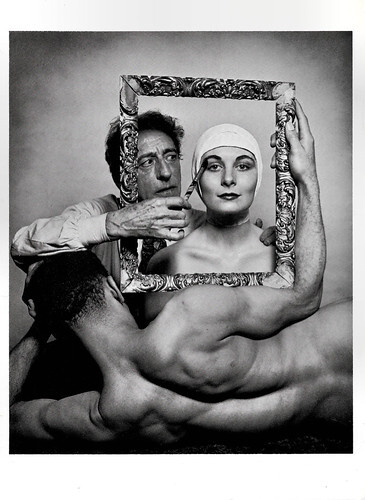
French postcard by Fotofolio, N.Y., N.Y, no. PH8. Photo: Philippe Halsman, 1949. Caption: The Act of Creation. Cocteau with actress Ricki Soma (wife of John Huston and mother of Anjelica) and dancer Leo Coleman.
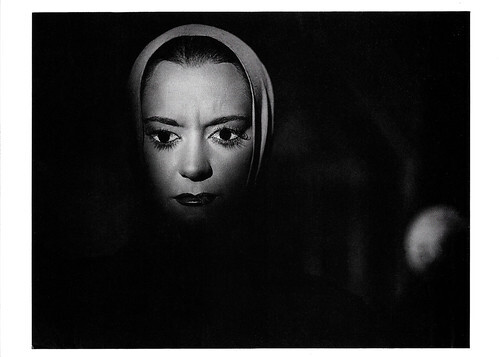
Swiss / British / German postcard by News Productions, Baulmes & Stroud / Filmwelt Berlin, Bakede, no. 56514. Photo: Collection Cinémathèque Suisse, Lausanne. Maria Casarès in Orphée/Orpheus (Jean Cocteau, 1950).
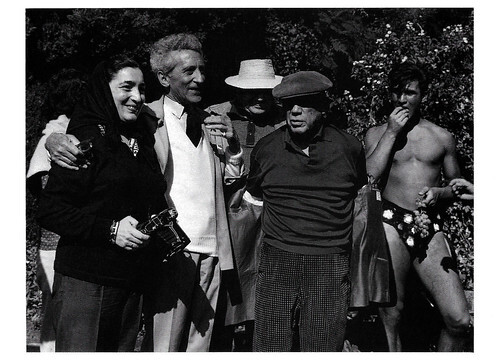
Swiss postcard by News Productions, Baulmes / Stroud / Filmwelt Berlin, Bakede, no. 56513. Photo: Collection Cinémathèque Suisse. Jean Cocteau and Pablo Picasso on the set of Le Testament d'Orphée/Testament of Orpheus (Jean Cocteau, 1960).
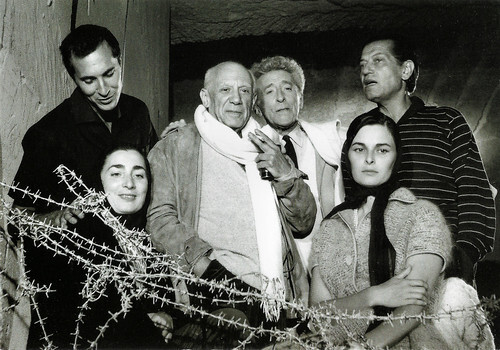
French postcard TTG / ADAGP, Paris, 2013, no. 0183000053. Photo: Lucien Clergue. Matador Luis Miguel Dominguin, Jacqueline and Pablo Picasso, Jean Cocteau, Lucia Bosé and Serge Lifar. Cocteau's final film, Le Testament d'Orphée/The Testament of Orpheus (1960), featured appearances by Picasso and Dominguín,
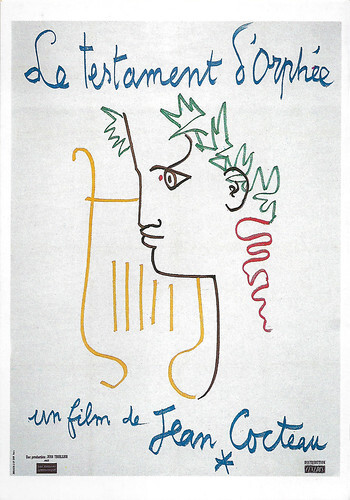
French postcard by Fernand Hazan, Paris, no. 1603 C. Poster design: Jean Cocteau. French poster for Le testament d'Orphée/Testament of Orpheus (Jean Cocteau, 1960).
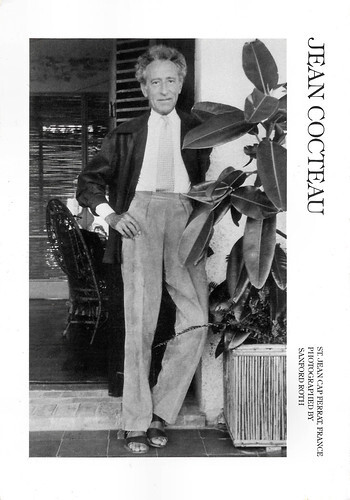
American postcard by Pomegranate, Corte Madera, Calif, no. 35-5135. Photo: Sanford Roth. Caption: Jean Cocteau, French dramatist, novelist, critic and poet. St. Jean, Cap Ferrat, France.
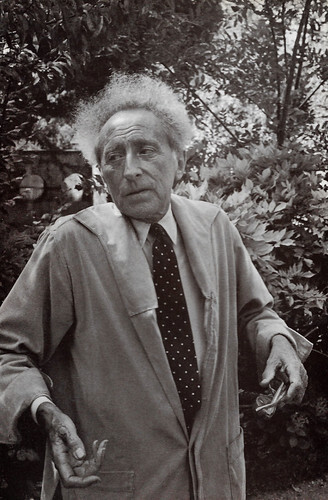
French postcard in the series Personnalités du XXe siècle by Opsis, Paris, no. C 4. Photo: J. Mounicq.
Sources: (IMDb), MFA - Masterworks Fine Art Gallery, Wikipedia (Dutch and English) and .

Belgian postcard by Maison d'Art, Bruxelles. Photo: Manuel.

French postcard by Éditions du Désastre, Paris, 1988, no RD 6. Photo: Robert Doisneau, 1949. Jean Cocteau and Jean Marais .

French postcard by A.N., Paris, no. 368. Photo: Intran Studio.

French postcard. Photo montage: Philippe Halsman / Magnum Photos. Caption: The French writer Jean Cocteau in a photographic montage by Philippe Halsman.

French postcard by Editions Hazan, Paris, in the Collection Magie Noire, no. 1960. Photo: unknown. Jean Cocteau and Jean Marais .
Openly homosexual
Jean Maurice Eugène Cocteau was born in 1889 in Maisons-Laffitte, Seine-et-Oise (now Yvelines), France. Cocteau was born into a middle-class family. Cocteau's father committed suicide when he was about 10 years old. In 1900, he entered a private school and was expelled in 1904. After his expulsion from school, Cocteau ran away to Marseilles where he lived in the red-light district under a false name. Police discovered him in Marseilles and returned him to his uncle's care. Jean began writing at 10 and was a published poet by age 16. From 1908, he was a frequent guest in artistic circles.
Cocteau associated himself with Edouard de Max , a reigning tragedian of the Paris stage at this time. De Max encouraged Cocteau to write and on 4 April 1908, he rented the Theatre Femina for the premiere of the young writer's poetry. In 1909, Cocteau met the Russian impresario Sergei Daighilev who ran the Ballets Russes. In 1911, he wrote the libretto for 'Le dieu bleu, a ballet by the Ballets Russes. In 1917 came 'Parade', an avant-garde ballet by Cocteau, for which Pablo Picasso, among others, designed the sets and costumes and Erik Satie composed the music. In Guillaume Apollinaire's programme booklet, to describe the ballet, the word surréaliste was used for the first time. The ballet was not a great success, but it did establish Cocteau's name in the avant-garde of Paris.
In 1920, Cocteau met the aspiring writer Raymond Radiguet, then aged 17. They collaborated extensively, socialised, and undertook many journeys and vacations together. Cocteau also got Radiguet exempted from military service. After Radiguet released 'Le Diable au corps', a largely autobiographical story of an adulterous relationship between a married woman and a younger man, a period of productivity followed for Cocteau. This stopped in 1923 when Radiguet died of typhoid fever. Cocteau became addicted to opium in the period that followed. During Cocteau's recovery from his opium addiction, the artist created some of his most important works including the stage play 'Orphee' and many long poems.
Cocteau was openly homosexual. He was the author of the mildly homoerotic and semi-autobiographical 'Le Livre blanc' (The White Book), published anonymously in 1928. He never repudiated its authorship and a later edition of the novel features his foreword and drawings. Frequently his work, either literary (Les enfants terribles), graphic (erotic drawings, book illustration, paintings) or cinematographic, is pervaded with homosexual undertones, homoerotic imagery/symbolism or camp.
In 1926, he published 'Le rappel à l'ordre', a book of essays describing the renewed interest in traditions in the post-World War I period. In 1929, Cocteau wrote his best-known work, 'Les Enfants terribles'. In the early 1930s, Cocteau wrote what some believe to be his greatest play, 'La Machine Infernal'. The play was a treatment of the Oedipus theme. Cocteau also wrote 'La voix humaine' (1930, The Human Voice), 'Les chevaliers de la table rounde' (1937, The Knights of the Round Table), 'Les parents terribles' (1938, Intimate Relations), and 'La machine a ecrire' (1941, The Typewriter).

French postcard by Editions du Centre Pompidou, no. CP 2217. Photo: Sacha Masour. Jean Cocteau paints the eyes of Enrique Rivero at the set of Le Sang d'un poète/The Blood of a Poet (Jean Cocteau, 1930).

French card, no. C142. Photo: Aldo. Jean Marais and Josette Day in La belle et la bête/Beauty and the Beast (Jean Cocteau, René Clément, 1946).

Swiss postcard by CVB Publishers. Image: Collection Cinémathèque Lausanne. French poster for La Belle et la Bête (Jean Cocteau, René Clément, 1946). The poster was designed by Cocteau's friend Jean-Denis Malcles.

French postcard by Carterie artistique et cinématographique, Pont du Casse, no. EDC 2827. Affiche for Les enfants terribles/The Terrible Children (Jean-Pierre Melville, 1950), based on the play by Jean Cocteau.

Swiss / British / German postcard by News Productions, Baulmes & Stroud / Filmwelt Berlin, Bakede, no. 56482. Photo: Collection Cinémathèque Suisse, Lausanne. Jean Marais in Orphée/Orpheus (Jean Cocteau, 1950).
The Beauty and the Beast
Jean Cocteau's film debut Le sang d'un poète/The Blood of a Poet (1930) starring Enrique Rivero , was a grand experiment in an effort to capture a young poet's obsession with the struggle between the forces of life and death. He is condemned to walk the halls of the Hotel of Dramatic Follies for his crime of having brought a statue to life. Because of the October 1930 scandal around Luis Buñuel's L'âge d'or (1930) - another film financed by Le Vicomte de Noailles and Marie-Laure de Noailles, the Paris premiere of this film was delayed until January 1932. The film is the first part of Jean Cocteau's Orpheus Trilogy (1932-1960); a loosely connected telling and re-telling of the well-known Greek legend. During the next years, the artist's work lapsed. One reason for this is his recurring addiction to opium.
Wikipedia : "Although in 1938 Cocteau had compared Adolf Hitler to an evil demiurge who wished to perpetrate a Saint Bartholomew's Day massacre against Jews, his friend Arno Breker convinced him that Hitler was a pacifist and patron of the arts with France's best interests in mind. During the Nazi occupation of France, he was in a "round-table" of French and German intellectuals who met at the Georges V Hotel in Paris, including Cocteau, the writers Ernst Jünger, Paul Morand and Henry Millon de Montherlant, the publisher Gaston Gallimard and the Nazi legal scholar Carl Schmitt. In his diary, Cocteau accused France of disrespect towards Hitler and speculated on the Führer's sexuality. Cocteau effusively praised Breker's sculptures in an article entitled 'Salut à Breker' published in 1942. This piece caused him to be arraigned on charges of collaboration after the war, though he was cleared of any wrongdoing and had used his contacts in his failed attempt to save friends such as Max Jacob.
Jean Cocteau's return to work in the 1940s was primarily due to the influence of his protégé and lover Jean Marais , who starred in La belle et la bête/Beauty and the Beast (Jean Cocteau, 1946), based on the eponymous tale by Jeanne-Marie Leprince de Beaumont (1756). Marais played three roles, the Beast, Beauty's suitor, and the Prince, and Josette Day played Belle. The film marked a triumphant return of Cocteau to the screen.
Cocteau and Marais also made L'aigle à deux têtes/The Eagle with Two Heads (Jean Cocteau, 1948) and Les parents terribles/The Storm Within (Jean Cocteau, 1948). In Cocteau's most important film, Orphee/Orpheus (Jean Cocteau, 1950), Jean Marais is a poet who becomes obsessed with a Princess, Death (Maria Casares). They fall in love. Orphee's wife, Eurydice ( Marie Déa ), is killed by the Princess' henchmen and Orphee goes after her into the Underworld. Although they have become dangerously entangled, the Princess sends Orphee back out of the Underworld, to carry on his life with Eurydice.
In 1955, Cocteau became a member of the Académie française and he was also awarded the French Legion of Honour. In his final film, Le testament d'Orphée/Testament of Orpheus (Jean Cocteau, 1959), Cocteau himself played the poet Orpheus who looks back over his life and work, recalling his inspirations and obsessions. Cocteau made about twelve films in his career, all rich with symbolism and surreal imagery.
Jean Cocteau passed away in 1963 at his chateau in Milly-la-Foret, France at the age of 74. He died of a heart after hearing the news of the death of another friend, the singer Edith Piaf . Cocteau's chateau was bought by the government on the initiative of a committee that wants to keep his memory alive. It was inaugurated as a Cocteau museum in 2010. Cocteau's longest-lasting relationships were with French actors Jean Marais and Édouard Dermit, whom Cocteau formally adopted. According to his wishes, Cocteau is buried beneath the floor of the Chapelle Saint-Blaise des Simples in Milly-la-Forêt. The epitaph on his gravestone set on the floor of the chapel reads: "Je reste avec vous" (I stay with you).

American postcard by Fotofolio, NY, NY, no. MR 37. Photo: Man Ray, 1924.

Vintage French postcard. Collection d'Art et d'Histoire, Paris.

French postcard by Marion-Valentine, Paris, no. N 118. Photo: Germaine Krull / Collection Bibliothèque Nationale. Caption: Jean Cocteau, 1929.

French postcard in the Collection Magie Noire by Editions Hazan, Paris, no. 6037, 1988. Photo: Serge Lido. Caption: Édith Piaf and Jean Cocteau, 1939.

French postcard by Musée Carnavalet, Paris, no IC 40 2125. Photo: Pierre Jahan. Caption: Jean Cocteau in his window, 86, rue de Montparnasse, Palais Royal, Paris (1er arr.), 1941.

French postcard by Fotofolio, N.Y., N.Y, no. PH8. Photo: Philippe Halsman, 1949. Caption: The Act of Creation. Cocteau with actress Ricki Soma (wife of John Huston and mother of Anjelica) and dancer Leo Coleman.

Swiss / British / German postcard by News Productions, Baulmes & Stroud / Filmwelt Berlin, Bakede, no. 56514. Photo: Collection Cinémathèque Suisse, Lausanne. Maria Casarès in Orphée/Orpheus (Jean Cocteau, 1950).

Swiss postcard by News Productions, Baulmes / Stroud / Filmwelt Berlin, Bakede, no. 56513. Photo: Collection Cinémathèque Suisse. Jean Cocteau and Pablo Picasso on the set of Le Testament d'Orphée/Testament of Orpheus (Jean Cocteau, 1960).

French postcard TTG / ADAGP, Paris, 2013, no. 0183000053. Photo: Lucien Clergue. Matador Luis Miguel Dominguin, Jacqueline and Pablo Picasso, Jean Cocteau, Lucia Bosé and Serge Lifar. Cocteau's final film, Le Testament d'Orphée/The Testament of Orpheus (1960), featured appearances by Picasso and Dominguín,

French postcard by Fernand Hazan, Paris, no. 1603 C. Poster design: Jean Cocteau. French poster for Le testament d'Orphée/Testament of Orpheus (Jean Cocteau, 1960).

American postcard by Pomegranate, Corte Madera, Calif, no. 35-5135. Photo: Sanford Roth. Caption: Jean Cocteau, French dramatist, novelist, critic and poet. St. Jean, Cap Ferrat, France.

French postcard in the series Personnalités du XXe siècle by Opsis, Paris, no. C 4. Photo: J. Mounicq.
Sources: (IMDb), MFA - Masterworks Fine Art Gallery, Wikipedia (Dutch and English) and .
Published on April 02, 2023 22:00
April 1, 2023
Hermann Picha
German stage and film actor Hermann Picha (1865-1936) was very prolific in German cinema during the silent and early sound eras, appearing in over 300 short and feature films. Picha played a mixture of lead and supporting roles during his career. He played the title role in Schneider Wibbel/Wibbel the Tailor (Manfred Noa, 1920) and appeared in a supporting role in Fritz Lang's Expressionist fantasy classic Der müde Tod/Destiny (1921), inspired by the Indian folktale of Savitri.

Austrian postcard by Iris- Verlag, no. 622. Photo: Sascha-Film, Wien.
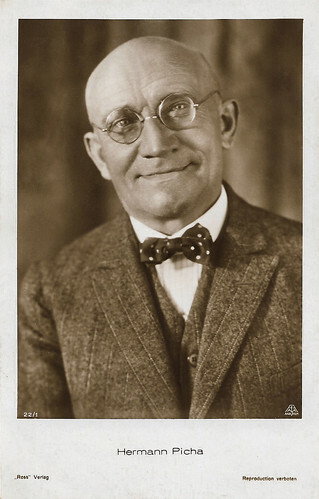
German postcard by Ross Verlag, no. 22/1. Photo: Aafa-Film.
One of the most sought-after supporting actors
Hermann Picha was born Hermann August Carl Picher in 1865 in Charlottenburg (now Berlin), Germany. Hermann made his stage debut in 1885 in Jauer and then played in Detmold, Heilbronn and Hamburg. From 1890 to 1905 he acted at the Bellevue Theater in Stettin.
He became known as an eccentric mime and comedian. In 1905 he was engaged by the Berliner Theater in Berlin. Later, he worked on other Berlin stages such as the Großes Schauspielhaus, the Lustspielhaus and the Deutsches Künstlerhaus.
In 1914, he made his film debut probably in the silent thriller Das Panzergewölbe/The Armoured Vault (Joe May, 1914) starring Ernst Reicher . It was part of the Stuart Webbs series, popular during the silent era. In silent German cinema, he became one of the most sought-after supporting actors.
Picha was a specialist in grotesques or highly idiosyncratic types. Another popular mystery film was Das Derby/The Derby (Ewald André Dupont, 1919) starring Max Landa. He became a key supporting player for prominent directors of the German silent cinema.
He had a part in the success of some important film classics such as Ernst Lubitsch 's Romeo und Julia im Schnee/Romeo and Juliet in the Snow (1920) starring Lotte Neumann , Fritz Lang 's Der müde Tod/Destiny (1921), Joe May 's Das indische Grabmal/The Indian Tomb (1921) and Friedrich Wilhelm Murnau's Tartüff/Tartuffe (1925).
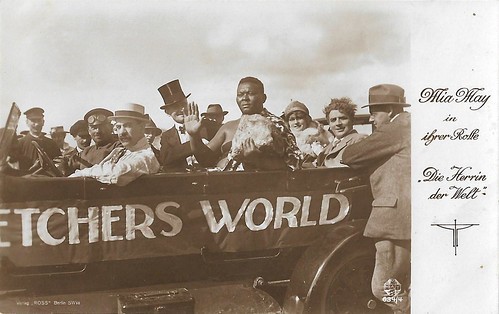
German postcard by Ross Verlag, no. 634/6. Photo: May Film. Mia May and Michael Bohnen in Die Herrin der Welt/Mistress of the World (Joe May and others, 1919). The man with the top hat is Hermann Picha, who plays newspaper mogul Jonathan Fletcher.
The first-night audience booed
Occasionally Hermann Picha played starring roles in such films as the comedy Schneider Wibbel/Wibbel the Tailor (Manfred Noa, 1920) and he played the shoemaker Wilhelm Voigt in Der Hauptmann von Köpenick/The Captain from Köpenick (Siegfried Dessauer, 1926).
The German sound film banked on the comical talent of Hermann Picha too. He appeared in the popular operetta Der Bettelstudent/The Beggar Student (Victor Janson, 1931) with Jarmila Novotná and the comedy Paprika/Marriage in Haste (Carl Boese, 1932) starring Franciska Gaal , Paul Hörbiger and Paul Heidemann and made by the German branch of Universal Pictures.
Picha could be seen in the German Science-Fiction film Die Welt ohne Maske/The World Without a Mask (1934) directed by and starring Harry Piel . His final film was the drama Nur nicht weich werden, Susanne!/Don't Lose Heart, Suzanne! (Arzén von Cserépy, 1935) starring Jessie Vihrog and Veit Harlan .
The film offered support to the Nazi Party's anti-Semitic stance through a negative portrayal of the two Jewish film producers. It received strong official backing, and a gala premiere was arranged for its release by Joseph Goebbels. To Goebbels' surprise and disgust, the first-night audience booed, once the screening was over. The incident was largely hushed-up, and the film's director Arzén von Cserépy went back to his native Hungary in disgrace and never made another German film.
Hermann Picha died in 1936 in Berlin, Germany. Picha is buried in the II Municipal Cemetery Eythstraße in Berlin-Schöneberg.
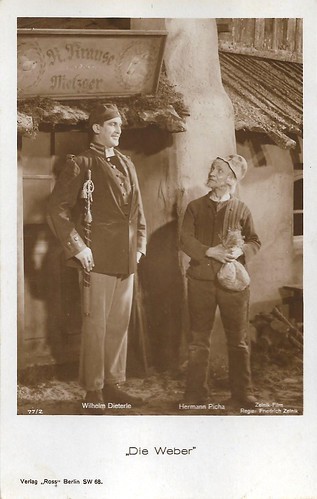
German postcard by Ross Verlag, Berlin, no. 77/2 Photo: Zelnik-Film. Wilhelm Dieterle and Hermann Picha in Die Weber (Friedrich Zelnik, 1927).
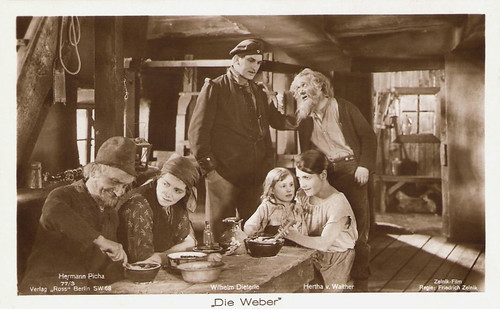
German postcard by Ross Verlag, Berlin, no. 77/3. Photo: Zelnik-Film. Hertha von Walther, Wilhelm Dieterle and Hermann Picha in Die Weber (Friedrich Zelnik, 1927).
Sources: Wikipedia (English and German), and .

Austrian postcard by Iris- Verlag, no. 622. Photo: Sascha-Film, Wien.

German postcard by Ross Verlag, no. 22/1. Photo: Aafa-Film.
One of the most sought-after supporting actors
Hermann Picha was born Hermann August Carl Picher in 1865 in Charlottenburg (now Berlin), Germany. Hermann made his stage debut in 1885 in Jauer and then played in Detmold, Heilbronn and Hamburg. From 1890 to 1905 he acted at the Bellevue Theater in Stettin.
He became known as an eccentric mime and comedian. In 1905 he was engaged by the Berliner Theater in Berlin. Later, he worked on other Berlin stages such as the Großes Schauspielhaus, the Lustspielhaus and the Deutsches Künstlerhaus.
In 1914, he made his film debut probably in the silent thriller Das Panzergewölbe/The Armoured Vault (Joe May, 1914) starring Ernst Reicher . It was part of the Stuart Webbs series, popular during the silent era. In silent German cinema, he became one of the most sought-after supporting actors.
Picha was a specialist in grotesques or highly idiosyncratic types. Another popular mystery film was Das Derby/The Derby (Ewald André Dupont, 1919) starring Max Landa. He became a key supporting player for prominent directors of the German silent cinema.
He had a part in the success of some important film classics such as Ernst Lubitsch 's Romeo und Julia im Schnee/Romeo and Juliet in the Snow (1920) starring Lotte Neumann , Fritz Lang 's Der müde Tod/Destiny (1921), Joe May 's Das indische Grabmal/The Indian Tomb (1921) and Friedrich Wilhelm Murnau's Tartüff/Tartuffe (1925).

German postcard by Ross Verlag, no. 634/6. Photo: May Film. Mia May and Michael Bohnen in Die Herrin der Welt/Mistress of the World (Joe May and others, 1919). The man with the top hat is Hermann Picha, who plays newspaper mogul Jonathan Fletcher.
The first-night audience booed
Occasionally Hermann Picha played starring roles in such films as the comedy Schneider Wibbel/Wibbel the Tailor (Manfred Noa, 1920) and he played the shoemaker Wilhelm Voigt in Der Hauptmann von Köpenick/The Captain from Köpenick (Siegfried Dessauer, 1926).
The German sound film banked on the comical talent of Hermann Picha too. He appeared in the popular operetta Der Bettelstudent/The Beggar Student (Victor Janson, 1931) with Jarmila Novotná and the comedy Paprika/Marriage in Haste (Carl Boese, 1932) starring Franciska Gaal , Paul Hörbiger and Paul Heidemann and made by the German branch of Universal Pictures.
Picha could be seen in the German Science-Fiction film Die Welt ohne Maske/The World Without a Mask (1934) directed by and starring Harry Piel . His final film was the drama Nur nicht weich werden, Susanne!/Don't Lose Heart, Suzanne! (Arzén von Cserépy, 1935) starring Jessie Vihrog and Veit Harlan .
The film offered support to the Nazi Party's anti-Semitic stance through a negative portrayal of the two Jewish film producers. It received strong official backing, and a gala premiere was arranged for its release by Joseph Goebbels. To Goebbels' surprise and disgust, the first-night audience booed, once the screening was over. The incident was largely hushed-up, and the film's director Arzén von Cserépy went back to his native Hungary in disgrace and never made another German film.
Hermann Picha died in 1936 in Berlin, Germany. Picha is buried in the II Municipal Cemetery Eythstraße in Berlin-Schöneberg.

German postcard by Ross Verlag, Berlin, no. 77/2 Photo: Zelnik-Film. Wilhelm Dieterle and Hermann Picha in Die Weber (Friedrich Zelnik, 1927).

German postcard by Ross Verlag, Berlin, no. 77/3. Photo: Zelnik-Film. Hertha von Walther, Wilhelm Dieterle and Hermann Picha in Die Weber (Friedrich Zelnik, 1927).
Sources: Wikipedia (English and German), and .
Published on April 01, 2023 22:00
March 31, 2023
Eddie Murphy
African-American film actor Eddie Murphy (1961) began his career as a stand-up comedian. He made his television debut on Saturday Night Live. From the early 1980s, he devoted himself to acting in comedies. With his first film roles in 48 Hrs. (Walter Hill, 1982) and Trading Places (John Landis, 1983), he was already breaking through. This was followed by the hits Beverly Hills Cop (Martin Brest, 1984) and Coming to America (John Landis, 1988). His popularity waned in the late 1980s and early 1990s, but he made a comeback with The Nutty Professor (Tom Shadyac, 1996). Also a versatile voice actor, he voiced the donkey in Shrek (Andrew Adamson, Vicky Jenson, 2001) and the Chinese dragon in Mulan (Barry Cook, Tom Bancroft, 1998).
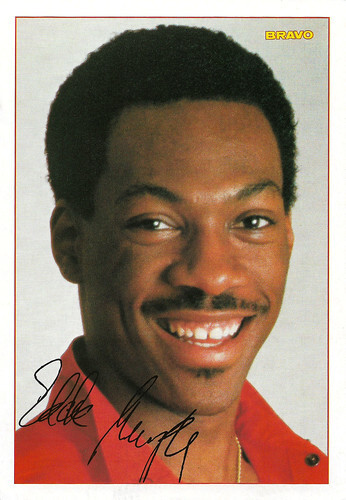
West German collectors card by Bravo.
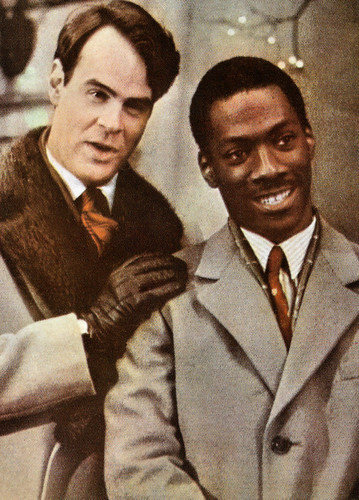
Romanian postcard by Casa Filmului Acin, no. C.P.C.S., 33150. Dan Aykroyd and Eddie Murphy in Trading Places (John Landis, 1983).
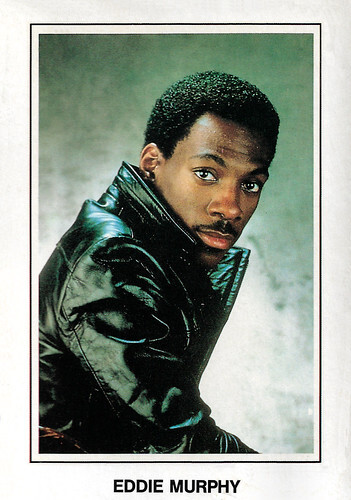
Vintage postcard.
Dead-on impressions of celebrities and outlooks on life
Edward Regan Murphy was born in 1961 in Brooklyn, New York, to Lillian Laney, a telephone operator, and Charles Edward Murphy, a transit police officer who was also an amateur comedian and actor. After his father died when Eddie was eight, his mother married Vernon Lynch, a foreman at a Breyer's Ice Cream plant. His brothers are Charlie Murphy and Vernon Lynch Jr.
A bright kid growing up in the streets of New York, Eddie had aspirations of being in show business. His sense of humour made him stand out amongst his classmates at Roosevelt Junior-Senior High School. When he was fifteen, Murphy listened to Richard Pryor's comedy album 'That Nigger's Crazy', which inspired his decision to become a comedian.
Murphy started to work as a stand-up comic in the lower part of New York, wooing audiences with his dead-on impressions of celebrities and outlooks on life. At 19, he was hired as one of the backup performers on the TV comedy show Saturday Night Live. Murphy exercised his comedic abilities by impersonating African American figures and originating some of the show's most memorable characters: Velvet Jones, inner-city kiddie host Mr. Robinson, and sourball celebrity Gumby.
Murphy made his feature film debut in 48 Hrs. (Walter Hill, 1982), alongside Nick Nolte. The two's comedic and antagonistic chemistry, alongside Murphy's believable performance as a streetwise convict aiding a bitter, ageing cop, won over critics and audiences. The next year, Murphy went two for two, with another hit, Trading Places (John Landis, 1983) with Dan Aykroyd. That same year, the standup album 'Eddie Murphy, Comedian' won a Grammy.
Beverly Hills Cop (Martin Brest, 1984) became one of the biggest blockbusters of the decade. It made Murphy a box-office superstar and a celebrity worldwide. Murphy's performance as a young Detroit cop in pursuit of his friend's murderers also earned him a third consecutive Golden Globe nomination. Axel Foley became one of Murphy's signature characters. On top of his game, Murphy was unfazed by his success, that is until his box office appeal and choices in scripts resulted in a spotty mix of hits and misses into the late 1980s and early 1990s.
Films like The Golden Child (Michael Ritchie, 1986) and Beverly Hills Cop II (Tony Scott, 1987) were critically panned but were still massive draws at the box office. John Landis directed Murphy again in the hit Coming to America (John Landis, 1988) which allowed him to play an abundance of characters. Some of which he essayed so well that he was utterly unrecognisable. In 1989, Murphy found failure with his directorial debut, Harlem Nights (Eddie Murphy, 1989). Another 48 Hrs. (Walter Hill, 1990), his turn as a hopeless romantic in Boomerang (Reginald Hudlin, 1992) and as a suave vampire in Vampire In Brooklyn (Wes Craven, 1995) did little to resuscitate his career.
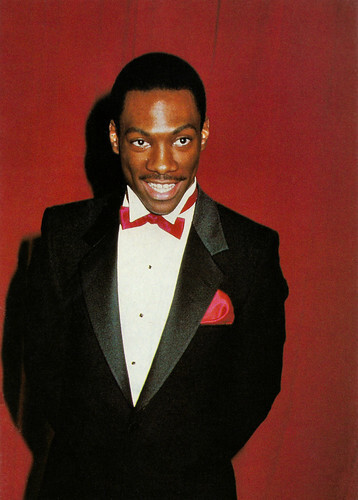
British postcard by Star-Graphics, London, no. S 191.
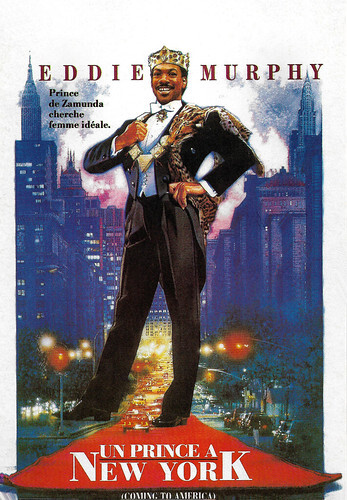
French postcard by Editions F. Nugeron, no. E 498. French poster for Coming to America (John Landis, 1988) with Eddie Murphy. Caption: Prince of Zamunda is looking for his ideal wife.
Family-oriented humour
His remake of Jerry Lewis 's The Nutty Professor (Tom Shadyac, 1996) brought Eddie Murphy's drawing power back into fruition. Hal Erickson at AllMovie : "the picture casts Murphy as Dr. Sherman Klump, an obese, klutzy scientist who transforms himself into Buddy Love, a self-obsessed narcissist and a hit with women. As an added surprise, Murphy doubles up his roles as Sherman and Buddy by playing each member of the Klump family (beneath piles and piles of latex). The Nutty Professor grossed dollar one and topped all of Murphy's prior efforts, earning well up into the hundreds of millions and pointing the actor in a more family-friendly direction."
From there, Murphy rebounded with occasional hits and misses but has long proven himself as a skilled comedic actor with a laudable range pertaining to characterisations and mannerisms. Though he has grown up a lot since his fast-lane rise as a superstar in the 1980s, Murphy has lived the Hollywood lifestyle with controversy, criticism, scandal, and the admiration of millions worldwide for his talents.
As Murphy matured throughout the years, he settled down with more family-oriented humour with Dr. Dolittle (Betty Thomas, 1998), the animation film Mulan (Tony Bancroft, Barry Cook, 1998), Bowfinger (Frank Oz, 1999) with Steve Martin, and the animated smash Shrek (Andrew Adamson, Vicky Jenson, 2001), in a supporting role that showcased Murphy's comedic personality and charm.
In the next years, he further starred in the hits The Haunted Mansion (Rob Minkoff, 2003), and Shrek 2 (Andrew Adamson, Kelly Asbury, Conrad Vernon, 2004). For the musical Dreamgirls (Bill Condon, 2006), he was nominated for a Best Supporting Actor Oscar. The film adaptation features an ensemble cast including Jamie Foxx, Beyoncé Knowles, Eddie Murphy, Jennifer Hudson, and Danny Glover. Murphy was a revelation as James Thunder Early, an R&B vocal sensation for whom the titular divas are hired to sing backup.
His later films include Norbit (Brian Robbins, 2007), Shrek the Third (Chris Miller, Raman Hui, 2007), and Shrek Forever After (Mike Mitchell, 2010). In October 2019, Murphy produced and starred in the biographical comedy Dolemite Is My Name (Craig Brewer, 2019) as Rudy Ray Moore. The film received overwhelming critical acclaim. In December 2019, Murphy returned to Saturday Night Live to promote Dolemite; this was his first time hosting since 1984. Murphy, Arsenio Hall and James Earl Jones reprised their roles in the Coming to America sequel Coming 2 America (Craig Brewer, 2021). Eddie Murphy was married to Nicole Mitchell Murphy from 1993 to 2006. Murphy has ten children.
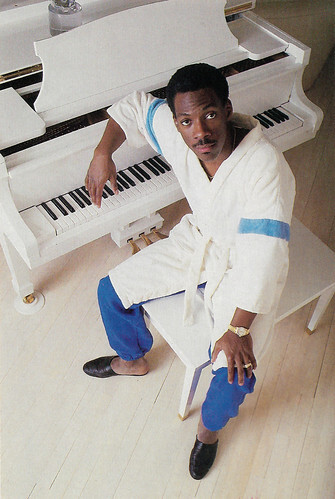
American postcard by Coral-Lee, Rancho Cordova, CA, Personality no. 145. Photo: Lynn Goldsmith / LGI.
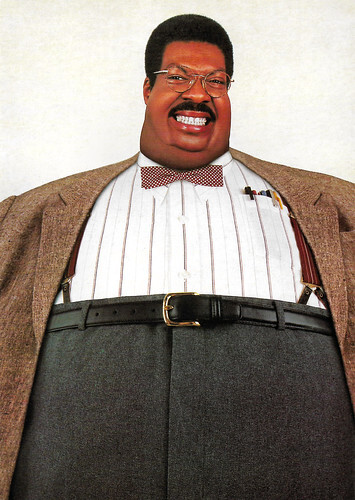
Vintage postcard by Boomerang. Photo: UIP. Eddie Murphy in The Nutty Professor (Tom Shadyac, 1996).
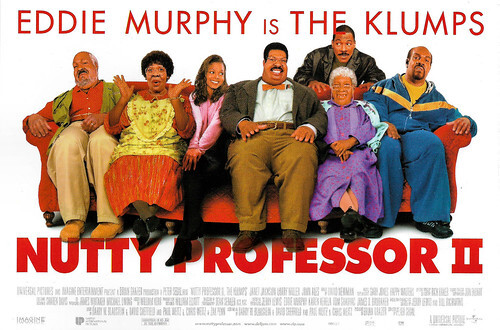
British postcard by Film Review / Visual Imagination Ltd, London, no. C 4. Photo: UIP. Eddie Murphy and Janet Jackson in Nutty Professor II - The Klumps (Peter Segal, 2000).
Sources: Hal Erickson (AllMovie), Wikipedia and .

West German collectors card by Bravo.

Romanian postcard by Casa Filmului Acin, no. C.P.C.S., 33150. Dan Aykroyd and Eddie Murphy in Trading Places (John Landis, 1983).

Vintage postcard.
Dead-on impressions of celebrities and outlooks on life
Edward Regan Murphy was born in 1961 in Brooklyn, New York, to Lillian Laney, a telephone operator, and Charles Edward Murphy, a transit police officer who was also an amateur comedian and actor. After his father died when Eddie was eight, his mother married Vernon Lynch, a foreman at a Breyer's Ice Cream plant. His brothers are Charlie Murphy and Vernon Lynch Jr.
A bright kid growing up in the streets of New York, Eddie had aspirations of being in show business. His sense of humour made him stand out amongst his classmates at Roosevelt Junior-Senior High School. When he was fifteen, Murphy listened to Richard Pryor's comedy album 'That Nigger's Crazy', which inspired his decision to become a comedian.
Murphy started to work as a stand-up comic in the lower part of New York, wooing audiences with his dead-on impressions of celebrities and outlooks on life. At 19, he was hired as one of the backup performers on the TV comedy show Saturday Night Live. Murphy exercised his comedic abilities by impersonating African American figures and originating some of the show's most memorable characters: Velvet Jones, inner-city kiddie host Mr. Robinson, and sourball celebrity Gumby.
Murphy made his feature film debut in 48 Hrs. (Walter Hill, 1982), alongside Nick Nolte. The two's comedic and antagonistic chemistry, alongside Murphy's believable performance as a streetwise convict aiding a bitter, ageing cop, won over critics and audiences. The next year, Murphy went two for two, with another hit, Trading Places (John Landis, 1983) with Dan Aykroyd. That same year, the standup album 'Eddie Murphy, Comedian' won a Grammy.
Beverly Hills Cop (Martin Brest, 1984) became one of the biggest blockbusters of the decade. It made Murphy a box-office superstar and a celebrity worldwide. Murphy's performance as a young Detroit cop in pursuit of his friend's murderers also earned him a third consecutive Golden Globe nomination. Axel Foley became one of Murphy's signature characters. On top of his game, Murphy was unfazed by his success, that is until his box office appeal and choices in scripts resulted in a spotty mix of hits and misses into the late 1980s and early 1990s.
Films like The Golden Child (Michael Ritchie, 1986) and Beverly Hills Cop II (Tony Scott, 1987) were critically panned but were still massive draws at the box office. John Landis directed Murphy again in the hit Coming to America (John Landis, 1988) which allowed him to play an abundance of characters. Some of which he essayed so well that he was utterly unrecognisable. In 1989, Murphy found failure with his directorial debut, Harlem Nights (Eddie Murphy, 1989). Another 48 Hrs. (Walter Hill, 1990), his turn as a hopeless romantic in Boomerang (Reginald Hudlin, 1992) and as a suave vampire in Vampire In Brooklyn (Wes Craven, 1995) did little to resuscitate his career.

British postcard by Star-Graphics, London, no. S 191.

French postcard by Editions F. Nugeron, no. E 498. French poster for Coming to America (John Landis, 1988) with Eddie Murphy. Caption: Prince of Zamunda is looking for his ideal wife.
Family-oriented humour
His remake of Jerry Lewis 's The Nutty Professor (Tom Shadyac, 1996) brought Eddie Murphy's drawing power back into fruition. Hal Erickson at AllMovie : "the picture casts Murphy as Dr. Sherman Klump, an obese, klutzy scientist who transforms himself into Buddy Love, a self-obsessed narcissist and a hit with women. As an added surprise, Murphy doubles up his roles as Sherman and Buddy by playing each member of the Klump family (beneath piles and piles of latex). The Nutty Professor grossed dollar one and topped all of Murphy's prior efforts, earning well up into the hundreds of millions and pointing the actor in a more family-friendly direction."
From there, Murphy rebounded with occasional hits and misses but has long proven himself as a skilled comedic actor with a laudable range pertaining to characterisations and mannerisms. Though he has grown up a lot since his fast-lane rise as a superstar in the 1980s, Murphy has lived the Hollywood lifestyle with controversy, criticism, scandal, and the admiration of millions worldwide for his talents.
As Murphy matured throughout the years, he settled down with more family-oriented humour with Dr. Dolittle (Betty Thomas, 1998), the animation film Mulan (Tony Bancroft, Barry Cook, 1998), Bowfinger (Frank Oz, 1999) with Steve Martin, and the animated smash Shrek (Andrew Adamson, Vicky Jenson, 2001), in a supporting role that showcased Murphy's comedic personality and charm.
In the next years, he further starred in the hits The Haunted Mansion (Rob Minkoff, 2003), and Shrek 2 (Andrew Adamson, Kelly Asbury, Conrad Vernon, 2004). For the musical Dreamgirls (Bill Condon, 2006), he was nominated for a Best Supporting Actor Oscar. The film adaptation features an ensemble cast including Jamie Foxx, Beyoncé Knowles, Eddie Murphy, Jennifer Hudson, and Danny Glover. Murphy was a revelation as James Thunder Early, an R&B vocal sensation for whom the titular divas are hired to sing backup.
His later films include Norbit (Brian Robbins, 2007), Shrek the Third (Chris Miller, Raman Hui, 2007), and Shrek Forever After (Mike Mitchell, 2010). In October 2019, Murphy produced and starred in the biographical comedy Dolemite Is My Name (Craig Brewer, 2019) as Rudy Ray Moore. The film received overwhelming critical acclaim. In December 2019, Murphy returned to Saturday Night Live to promote Dolemite; this was his first time hosting since 1984. Murphy, Arsenio Hall and James Earl Jones reprised their roles in the Coming to America sequel Coming 2 America (Craig Brewer, 2021). Eddie Murphy was married to Nicole Mitchell Murphy from 1993 to 2006. Murphy has ten children.

American postcard by Coral-Lee, Rancho Cordova, CA, Personality no. 145. Photo: Lynn Goldsmith / LGI.

Vintage postcard by Boomerang. Photo: UIP. Eddie Murphy in The Nutty Professor (Tom Shadyac, 1996).

British postcard by Film Review / Visual Imagination Ltd, London, no. C 4. Photo: UIP. Eddie Murphy and Janet Jackson in Nutty Professor II - The Klumps (Peter Segal, 2000).
Sources: Hal Erickson (AllMovie), Wikipedia and .
Published on March 31, 2023 22:00
March 30, 2023
The second Félix Potin collection
On 6 March 2023, EFSP presented a series of French vintage minicards produced for Félix Potin chocolate bars. There were three series of these collectors cards, which we will present in three posts. After the success of the first series, a second collection followed with photographic portraits of actors and famous painters of the early 20th century. This second series was issued in 1908 and again contained 500 personalities, also including artists, writers, sportsmen, scientists, politicians, and other famous people. The photos were made by star photographers such as Léopold-Émile Reutlinger, Sartony, Henri Manuel, etc. This series was again highly successful and Ivo Blom collected the minicards. For this post, we selected 25 highlights of the second collection.
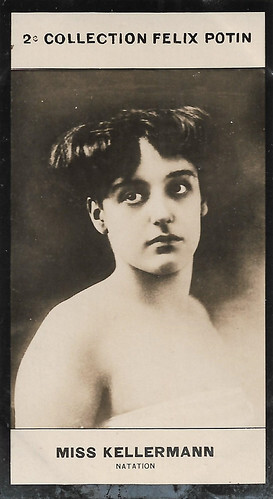
French minicard by Chocolat Félix Potin, Second Series, 1908. Photo: anonymous.
Annette Kellerman (1886-1975) was an Australian professional swimmer, vaudeville star, actress and writer. When she was six, she started swimming. In 1905, she was the first woman to attempt to swim the English Channel, but she gave up after three failed attempts. She was the first woman to wear a one-piece swimming costume and created her own line of swimming costumes. After her swimming career, she pursued a film career. In 1911, she was the first actress to wear a mermaid suit in a film. She was the first leading actress who appeared fully nude in A Daughter of the Gods (1916), the first film with a budget of $1 million. Kellerman appeared in one of the last films made in Prizma Colour, Venus of the South Seas (1924). This is also her only feature film that has survived in full. One of her Vitagraph shorts also survives, Jepthah’s Daughter: A Biblical Tragedy (1909). Recently, partial prints of Neptune’s Daughter and Siren of the Sea were uncovered. Kellermann did all of her stunts herself, sometimes resulting in serious injuries. She advised for the Esther Williams movie on her life, Million Dollar Mermaid (1952).
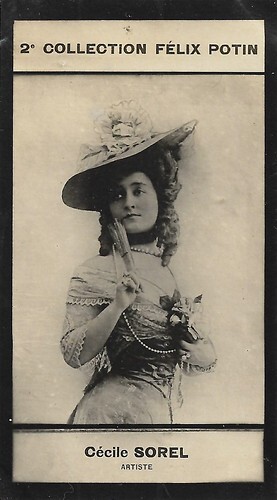
French minicard by Chocolat Félix Potin, Second Series, 1908. Photo: Léopold-Émile Reutlinger.
Legendary actress Cécile Sorel (1873-1966) was the ‘queen of the French stage’ during the Belle Epoque, the period between the Paris Exposition of 1900 and the First World War. Her public appearances, often in extravagant costumes, created a sensation. During her long life, she played in five films.
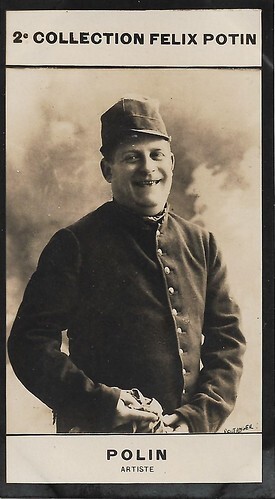
French minicard by Chocolat Félix Potin, Second Series, 1908. Photo: Léopold-Émile Reutlinger.
French comedian Polin (1863-1927) was one of the greatest stars of the café-concerts of Paris. His interpretations were sober and had nuance and finesse, which were rare in the café-concerts. From 1910 on, he also appeared in film and theatre, including Sacha Guitry's play 'Le Grand Duc' (The Grand Duke, 1921) with Lucien and Sacha Guitry and Yvonne Printemps.
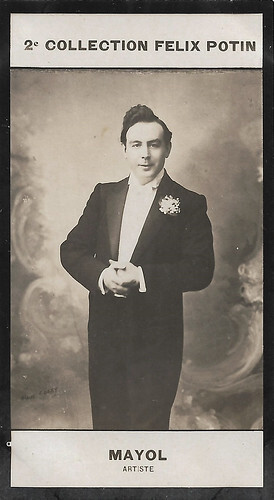
French minicard by Chocolat Félix Potin, Second Series, 1908. Photo: Paul Darby.
French singer of the Belle Epoque Félix Mayol (1872-1941) created almost 500 songs. In 1895 he had his breakthrough performing in a campy, effeminate way. His improbable hair tassel gave him the nickname of "the red-toupeed artist" or "flame of punch" and inspired many imitators. After a 1905 phonoscènes series at Gaumont, Mayol acted in five more films, including Le filon du Bouif (Louis Osmont, 1922), and two early sound films, Aux urnes, citoyens!/Tu sera député (Jean Hémard, 1932) and La dame de chez Maxim's (Alexander Korda, 1933) starring Florelle.
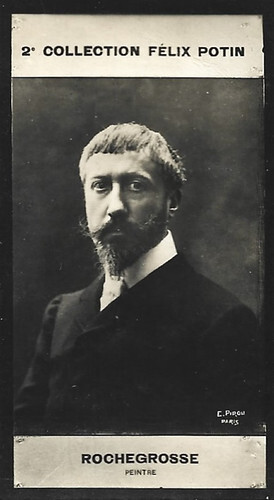
French minicard by Chocolat Félix Potin, Second Series, 1908. Photo: Eugène Pirou, Paris.
Georges-Antoine Rochegrosse (1859-1938) was a French painter, decorator and illustrator. Through his encounter with the culture of Algeria, he became a painter of Orientalism and received numerous awards for his work. His book illustrations for the 1900 edition of 'Salammbô' by Gustave Flaubert were used in the film Cabiria (Giovanni Patrone, 1914).
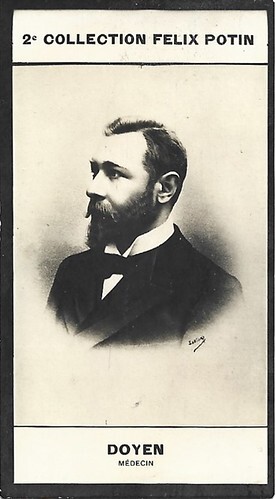
French minicard by Chocolat Félix Potin, Second Series, 1908. Photo: Sartony.
Eugène Louis Doyen (1859-1916) was a French surgeon of international renown, cited by the Russian writer Mikhail Bulgakov as the model for Marcel Proust's character Cottard, and vilified by Léon Daudet in 'Les Morticoles' as Doctor Bradilin. Doyen is considered one of the renovators of French surgery at the end of the 19th century, despite his inaccurate theories on cancer. We owe him very important improvements in surgical technique. From 1898, Doyen and Clément Maurice (organiser of the first Lumière shows) shot some sixty film sequences which recorded Doyen's surgical operations.
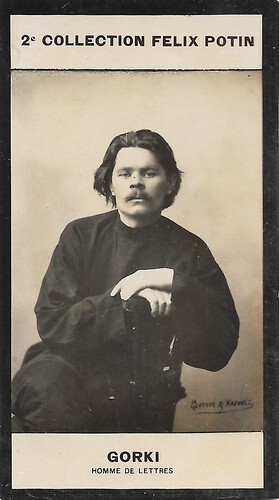
French minicard by Chocolat Félix Potin, Second Series, 1908. Photo: Scherer & Nabholz.
Russian writer Maxim Gorky (1868-1936) was one of the founders of socialist realism in literature and was politically and intellectually committed to the Bolshevik revolutionaries. Among Gorky's most famous works are his early short stories, written in the 1890s; his plays 'The Philistines' (1901), 'Na dne'/The Lower Depths' (1902) and 'Children of the Sun' (1905); his autobiographical trilogy, 'Detstvo/My Childhood', 'V lyudyakh/In the World', and 'Moi universitety/My Universities' (1913–1923); and his novel, 'Mat/Mother' (1906). 'Mat' was made into a notable silent film by Vsevolod Pudovkin, Mat/The Mother (1926) and dramatised by Bertolt Brecht in 'Die Mutter' (1930–31).
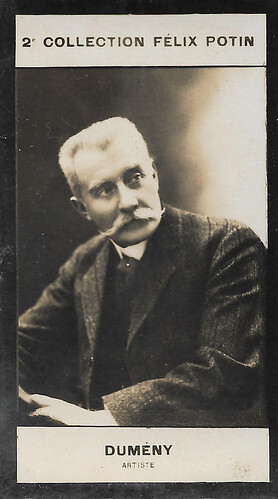
French minicard by Chocolat Félix Potin, Second Series, 1908. Photo: Henri Manuel.
Camille Dumény (1854-1920) was a French stage and screen actor. In 1904 he returned to the Théâtre du Gymnase Marie-Bell, in what was the most brilliant period of her career. Between 1909 and 1918, Dumény acted in 9 films, mainly at Pathé Frères He co-directed L'orgueil (1910), and directed L'empreinte de la patrie (1915). His last acting role was in Frères (Maurice Rémon, 1918), written by Jacques Grétillat.
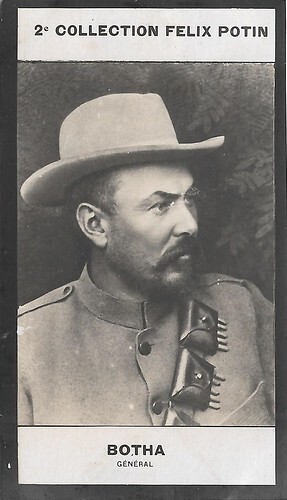
French minicard by Chocolat Félix Potin, Second Series, 1908. Photo: .
Louis Botha (1862-1919) was the commander-in-chief of the Transvaal army during the Second Boer War and the first prime minister of the Union of South Africa.
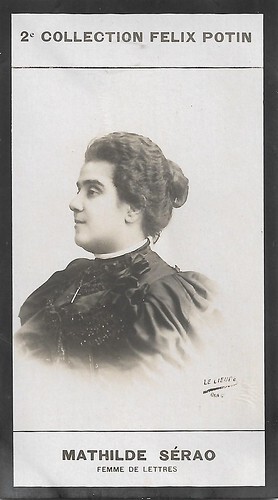
French minicard by Chocolat Félix Potin, Second Series, 1908. Photo: Le Lieure, Rome.
Matilde Serao (1856-1927) was an Italian journalist and novelist. She was the first woman called to edit an Italian newspaper, Il Corriere di Roma and later Il Giorno. Serao was also the co-founder and editor of the newspaper Il Mattino, and the author of several novels. She never won the Nobel Prize in Literature despite being nominated on six occasions.
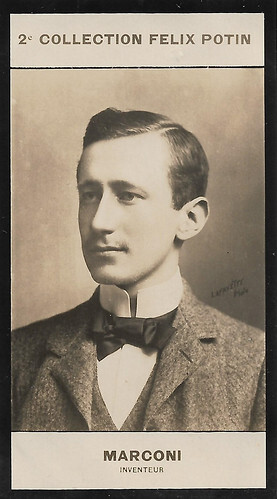
French minicard by Chocolat Félix Potin, Second Series, 1908. Photo: Lafayette.
Guglielmo Marconi (1874-1937) was an Italian physicist, inventor and businessman. He was one of the inventors of the radio and wireless telegraphy. Together with Ferdinand Braun, he was co-recipient of the 1909 Nobel Prize in Physics "in recognition of his contributions to the development of wireless telegraphy". Marconi was also the founder of the first international broadcasting company.
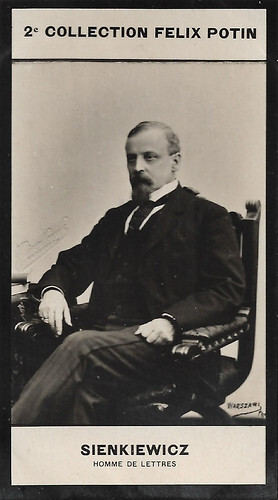
French minicard by Chocolat Félix Potin, Second Series, 1908. Photo: Warszawi.
Writer and philanthropist Henryk Sienkiewicz (1846-1916) was the greatest Polish novelist of his time. He enjoyed international fame during his lifetime thanks to the immense success of his novel 'Quo vadis?' (1896, first published as a feuilleton in 1895), which earned him the Nobel Prize for Literature in 1905. He also campaigned for the rights of Poles, who were under Prussian and then Russian occupation. The widely translated 'Quo vadis?' was filmed in 1901, 1909, 1913, 1926, 1951 and 2001.
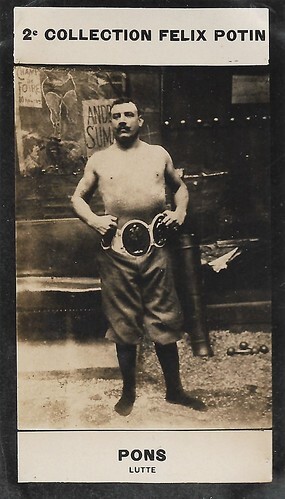
French minicard by Chocolat Félix Potin, Second Series, 1908. Photo: anonymous.
French wrestler Paul Pons (1864-1915) won the first title as world champion in Greco-Roman wrestling in 1898. Known as the Colossus, Pons was a blacksmith and mechanic by profession. Trained by Pietro Damiano, he became the national champion in Paris in 1891, then the first world wrestling champion in 1898, beating the Russian Pytlasiński. The championship passed to Bulgarian Nikola Petroff in 1900 when he defeated Pons at the Exposition Universelle in Paris.
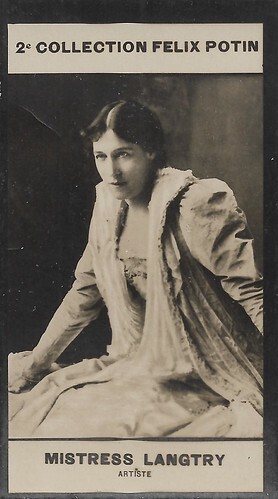
French minicard by Chocolat Félix Potin, Second Series, 1908. Photo: anonymous.
Lillie Langtry (1853-1929) was a highly successful British actress. Because of her beauty, her nickname was 'Jersey Lily'. She had several prominent lovers, including the Prince of Wales, and later King Edward VII. In 1879, Lillie made her debut as an actress at London's Haymarket Theatre. A year later, she toured several European countries. From 1882, Lillie performed in the United States. In 1886, her face was captured for a postage stamp issued in Jersey. In His Neighbor's Wife (Edwin S. Porter, 1913) Langtry starred opposite Sidney Mason in the role of Mrs Norton. It would be her only film appearance.
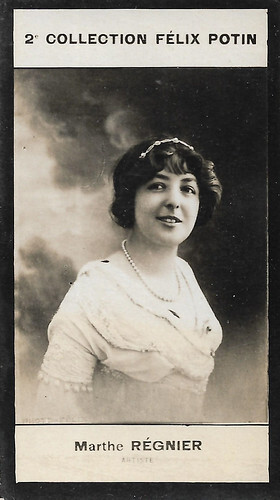
French minicard by Chocolat Félix Potin, Second Series, 1908. Photo: anonymous (probably: Félix).
Marthe Régnier (1880-1967) was a famous French stage actress and singer of the Belle Epoque and beyond. She launched her own perfume, designed fashion, and jewellery, and was the companion of Baron Rothschild. Regnier also acted in six silent and sound films.
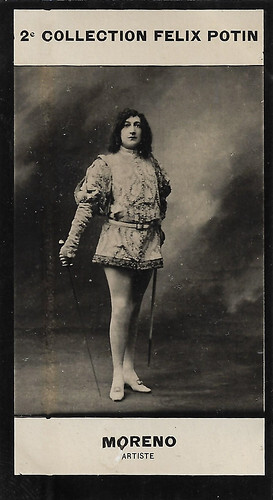
French minicard by Chocolat Félix Potin, Second Series, 1908. Photo: Roger-Viollet.
French stage and screen actress Marguerite Moreno (1871-1948) was engaged by the Comédie-Française in 1890. She acted with famous names on the French stage: Charles Le Bargy, Mounet-Sully, Julia Bartet, Coquelin sr. and Paul Mounet. Moreno also became the 'muse of the Symbolists', and poet Stéphane Mallarmé’s close friend. In 1915, she discovered cinema. In the silent era, she played Queen Anne of Austria in Vingt ans après (Henri Diamant-Berger, 1922). When sound cinema arrived in France, Moreno had an enormous increase in film roles. Together with Charles Dullin, Moreno played the evil couple Thenardier opposite Harry Baur as Jean Valjean in Les Misérables (Raymond Bernard, 1934).
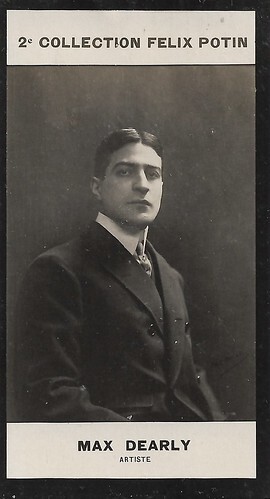
French minicard by Chocolat Félix Potin, Second Series, 1908. Photo: Paul Berger.
French actor Max Dearly (1874-1943) was famous for his roles in French film classics of the 1930s. In 1933 Dearly played the pharmacist Homais in Jean Renoir’s adaptation of Gustave Flaubert’s Madame Bovary. Memorable was also his part as the eccentric aristocrat Mr. Gillenormand, Marius’ grandfather in Les Misérables (Raymond Bernard, 1934). However, Dearly was above all an excellent actor in Parisian Vaudeville and revues.
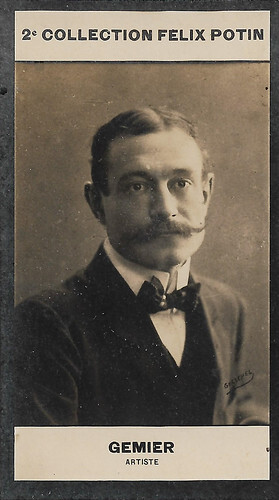
French minicard by Chocolat Félix Potin, Second Series, 1908. Photo: Aaron Gerschel.
Firmin Gémier (1869-1933) was an actor, director and theatre manager on the French stage, promotor of the Théâtre Populaire and founder of the first Théâtre National Populaire in Paris in 1920. He also acted in the French silent and sound cinema of the 1910s to the 1930s.
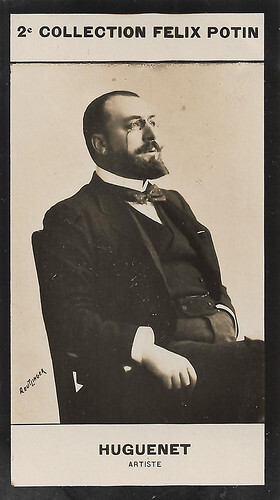
French minicard by Chocolat Félix Potin, Second Series, 1908. Photo: Léopold-Émile Reutlinger.
Félix Huguenet (1858-1926) only stayed two years with the Comédie Française (1906-1908) but had a rich stage career between the 1880s and the 1920s. He played in four films, including Mademoiselle de La Seiglière (André Antoine, 1921).
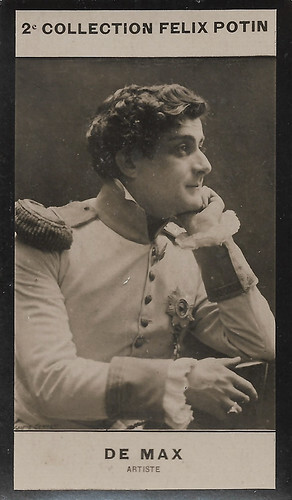
French minicard by Chocolat Félix Potin, Second Series, 1908. Photo: Paul Berger.
Actor Édouard de Max (1869-1924) was a leading man and 'monstre sacré' of the French stage. He also appeared in silent films of the 1910s and 1920s, including two versions of Les trois mousquetaires/The Three Musketeers.
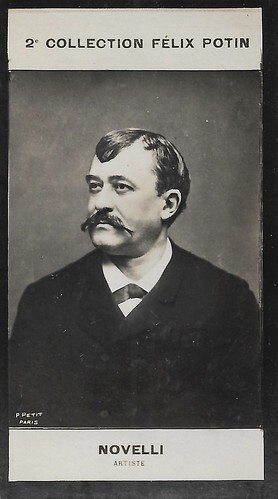
French minicard by Chocolat Félix Potin, Second Series, 1908. Photo: Pierre Petit, Paris.
Italian actor Ermete Novelli (1851-1919) was a legendary 'monstre sacré' of the theatre. In the 1910s he appeared in films by Film d'Arte Italiana, Ambrosio and Raggio Film.
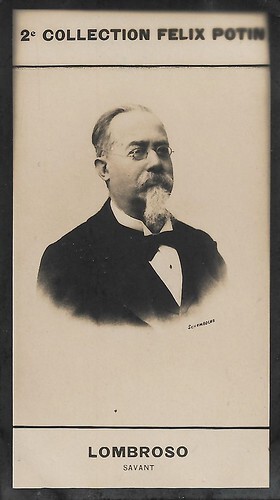
French minicard by Chocolat Félix Potin, Second Series, 1908. Photo: Michele Schemboche, Rome, Turin, Naples.
Cesare Lombroso (1835- 1909) was an Italian professor of forensic medicine and one of the founders of the Italian School of Criminology. He is famous for his theses on the "born criminal". He tried to identify criminals as a hereditary class that could be distinguished by physical appearance. His theories were influenced by the theory of degeneration, racialism and transformism. Lombroso was criticized for his prejudice and racism, but also for his pseudo-scientific studies. Afterward, Lombroso adjusted his theory, believing that crime is the result of both individual (biological) and social factors.
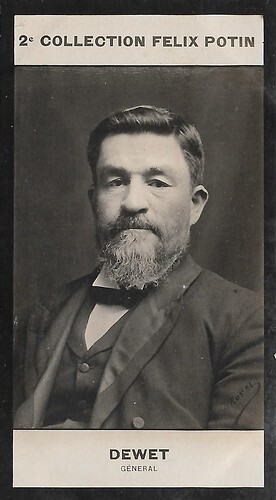
French minicard by Chocolat Félix Potin, Second Series, 1908. Photo: Russel.
Christiaan Rudolf de Wet (1854-1922) was a South African Boer general and politician.
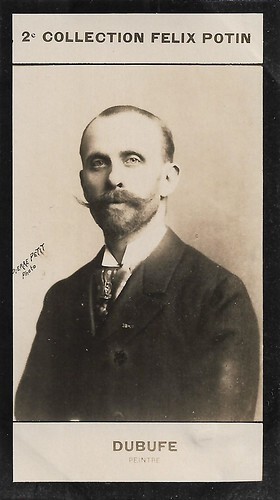
French minicard by Chocolat Félix Potin, Second Series, 1908. Photo: Pierre Petit, Paris.
French painter, decorator and illustrator Guillaume Dubufe (1853-1909) was known for his decorations of ceilings of the foyer at the Comédie-Française, the Lobau Gallery at the Hôtel de Ville, the banquet hall at the Élysée Palace, and the library at the Sorbonne. He also decorated the famous restaurant Le Train Bleu. When not staying at their mansion in Paris, his family stayed at their villa on the Isle of Capri, where he painted scenes of his home. Dubufe was the son of Édouard Dubufe, who was one of the most famous portraitists of the Second Empire.
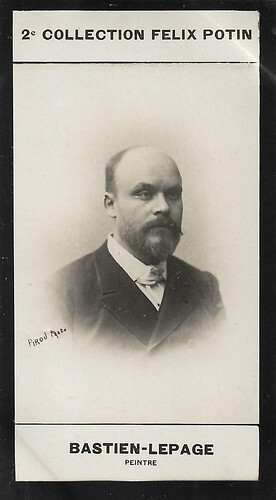
French minicard by Chocolat Félix Potin, Second Series, 1908. Photo: Pirou.
Jules Bastien-Lepage (1848-1884), was a French naturalist painter, an artistic style that emerged from the later phase of the Realist movement. His painting 'Les Foins' (Haymaking, 1877), now at the Musée d'Orsay in Paris, was widely praised by critics and the public alike.
For more cards, check out our Félix Potin album at Flickr.

French minicard by Chocolat Félix Potin, Second Series, 1908. Photo: anonymous.
Annette Kellerman (1886-1975) was an Australian professional swimmer, vaudeville star, actress and writer. When she was six, she started swimming. In 1905, she was the first woman to attempt to swim the English Channel, but she gave up after three failed attempts. She was the first woman to wear a one-piece swimming costume and created her own line of swimming costumes. After her swimming career, she pursued a film career. In 1911, she was the first actress to wear a mermaid suit in a film. She was the first leading actress who appeared fully nude in A Daughter of the Gods (1916), the first film with a budget of $1 million. Kellerman appeared in one of the last films made in Prizma Colour, Venus of the South Seas (1924). This is also her only feature film that has survived in full. One of her Vitagraph shorts also survives, Jepthah’s Daughter: A Biblical Tragedy (1909). Recently, partial prints of Neptune’s Daughter and Siren of the Sea were uncovered. Kellermann did all of her stunts herself, sometimes resulting in serious injuries. She advised for the Esther Williams movie on her life, Million Dollar Mermaid (1952).

French minicard by Chocolat Félix Potin, Second Series, 1908. Photo: Léopold-Émile Reutlinger.
Legendary actress Cécile Sorel (1873-1966) was the ‘queen of the French stage’ during the Belle Epoque, the period between the Paris Exposition of 1900 and the First World War. Her public appearances, often in extravagant costumes, created a sensation. During her long life, she played in five films.

French minicard by Chocolat Félix Potin, Second Series, 1908. Photo: Léopold-Émile Reutlinger.
French comedian Polin (1863-1927) was one of the greatest stars of the café-concerts of Paris. His interpretations were sober and had nuance and finesse, which were rare in the café-concerts. From 1910 on, he also appeared in film and theatre, including Sacha Guitry's play 'Le Grand Duc' (The Grand Duke, 1921) with Lucien and Sacha Guitry and Yvonne Printemps.

French minicard by Chocolat Félix Potin, Second Series, 1908. Photo: Paul Darby.
French singer of the Belle Epoque Félix Mayol (1872-1941) created almost 500 songs. In 1895 he had his breakthrough performing in a campy, effeminate way. His improbable hair tassel gave him the nickname of "the red-toupeed artist" or "flame of punch" and inspired many imitators. After a 1905 phonoscènes series at Gaumont, Mayol acted in five more films, including Le filon du Bouif (Louis Osmont, 1922), and two early sound films, Aux urnes, citoyens!/Tu sera député (Jean Hémard, 1932) and La dame de chez Maxim's (Alexander Korda, 1933) starring Florelle.

French minicard by Chocolat Félix Potin, Second Series, 1908. Photo: Eugène Pirou, Paris.
Georges-Antoine Rochegrosse (1859-1938) was a French painter, decorator and illustrator. Through his encounter with the culture of Algeria, he became a painter of Orientalism and received numerous awards for his work. His book illustrations for the 1900 edition of 'Salammbô' by Gustave Flaubert were used in the film Cabiria (Giovanni Patrone, 1914).

French minicard by Chocolat Félix Potin, Second Series, 1908. Photo: Sartony.
Eugène Louis Doyen (1859-1916) was a French surgeon of international renown, cited by the Russian writer Mikhail Bulgakov as the model for Marcel Proust's character Cottard, and vilified by Léon Daudet in 'Les Morticoles' as Doctor Bradilin. Doyen is considered one of the renovators of French surgery at the end of the 19th century, despite his inaccurate theories on cancer. We owe him very important improvements in surgical technique. From 1898, Doyen and Clément Maurice (organiser of the first Lumière shows) shot some sixty film sequences which recorded Doyen's surgical operations.

French minicard by Chocolat Félix Potin, Second Series, 1908. Photo: Scherer & Nabholz.
Russian writer Maxim Gorky (1868-1936) was one of the founders of socialist realism in literature and was politically and intellectually committed to the Bolshevik revolutionaries. Among Gorky's most famous works are his early short stories, written in the 1890s; his plays 'The Philistines' (1901), 'Na dne'/The Lower Depths' (1902) and 'Children of the Sun' (1905); his autobiographical trilogy, 'Detstvo/My Childhood', 'V lyudyakh/In the World', and 'Moi universitety/My Universities' (1913–1923); and his novel, 'Mat/Mother' (1906). 'Mat' was made into a notable silent film by Vsevolod Pudovkin, Mat/The Mother (1926) and dramatised by Bertolt Brecht in 'Die Mutter' (1930–31).

French minicard by Chocolat Félix Potin, Second Series, 1908. Photo: Henri Manuel.
Camille Dumény (1854-1920) was a French stage and screen actor. In 1904 he returned to the Théâtre du Gymnase Marie-Bell, in what was the most brilliant period of her career. Between 1909 and 1918, Dumény acted in 9 films, mainly at Pathé Frères He co-directed L'orgueil (1910), and directed L'empreinte de la patrie (1915). His last acting role was in Frères (Maurice Rémon, 1918), written by Jacques Grétillat.

French minicard by Chocolat Félix Potin, Second Series, 1908. Photo: .
Louis Botha (1862-1919) was the commander-in-chief of the Transvaal army during the Second Boer War and the first prime minister of the Union of South Africa.

French minicard by Chocolat Félix Potin, Second Series, 1908. Photo: Le Lieure, Rome.
Matilde Serao (1856-1927) was an Italian journalist and novelist. She was the first woman called to edit an Italian newspaper, Il Corriere di Roma and later Il Giorno. Serao was also the co-founder and editor of the newspaper Il Mattino, and the author of several novels. She never won the Nobel Prize in Literature despite being nominated on six occasions.

French minicard by Chocolat Félix Potin, Second Series, 1908. Photo: Lafayette.
Guglielmo Marconi (1874-1937) was an Italian physicist, inventor and businessman. He was one of the inventors of the radio and wireless telegraphy. Together with Ferdinand Braun, he was co-recipient of the 1909 Nobel Prize in Physics "in recognition of his contributions to the development of wireless telegraphy". Marconi was also the founder of the first international broadcasting company.

French minicard by Chocolat Félix Potin, Second Series, 1908. Photo: Warszawi.
Writer and philanthropist Henryk Sienkiewicz (1846-1916) was the greatest Polish novelist of his time. He enjoyed international fame during his lifetime thanks to the immense success of his novel 'Quo vadis?' (1896, first published as a feuilleton in 1895), which earned him the Nobel Prize for Literature in 1905. He also campaigned for the rights of Poles, who were under Prussian and then Russian occupation. The widely translated 'Quo vadis?' was filmed in 1901, 1909, 1913, 1926, 1951 and 2001.

French minicard by Chocolat Félix Potin, Second Series, 1908. Photo: anonymous.
French wrestler Paul Pons (1864-1915) won the first title as world champion in Greco-Roman wrestling in 1898. Known as the Colossus, Pons was a blacksmith and mechanic by profession. Trained by Pietro Damiano, he became the national champion in Paris in 1891, then the first world wrestling champion in 1898, beating the Russian Pytlasiński. The championship passed to Bulgarian Nikola Petroff in 1900 when he defeated Pons at the Exposition Universelle in Paris.

French minicard by Chocolat Félix Potin, Second Series, 1908. Photo: anonymous.
Lillie Langtry (1853-1929) was a highly successful British actress. Because of her beauty, her nickname was 'Jersey Lily'. She had several prominent lovers, including the Prince of Wales, and later King Edward VII. In 1879, Lillie made her debut as an actress at London's Haymarket Theatre. A year later, she toured several European countries. From 1882, Lillie performed in the United States. In 1886, her face was captured for a postage stamp issued in Jersey. In His Neighbor's Wife (Edwin S. Porter, 1913) Langtry starred opposite Sidney Mason in the role of Mrs Norton. It would be her only film appearance.

French minicard by Chocolat Félix Potin, Second Series, 1908. Photo: anonymous (probably: Félix).
Marthe Régnier (1880-1967) was a famous French stage actress and singer of the Belle Epoque and beyond. She launched her own perfume, designed fashion, and jewellery, and was the companion of Baron Rothschild. Regnier also acted in six silent and sound films.

French minicard by Chocolat Félix Potin, Second Series, 1908. Photo: Roger-Viollet.
French stage and screen actress Marguerite Moreno (1871-1948) was engaged by the Comédie-Française in 1890. She acted with famous names on the French stage: Charles Le Bargy, Mounet-Sully, Julia Bartet, Coquelin sr. and Paul Mounet. Moreno also became the 'muse of the Symbolists', and poet Stéphane Mallarmé’s close friend. In 1915, she discovered cinema. In the silent era, she played Queen Anne of Austria in Vingt ans après (Henri Diamant-Berger, 1922). When sound cinema arrived in France, Moreno had an enormous increase in film roles. Together with Charles Dullin, Moreno played the evil couple Thenardier opposite Harry Baur as Jean Valjean in Les Misérables (Raymond Bernard, 1934).

French minicard by Chocolat Félix Potin, Second Series, 1908. Photo: Paul Berger.
French actor Max Dearly (1874-1943) was famous for his roles in French film classics of the 1930s. In 1933 Dearly played the pharmacist Homais in Jean Renoir’s adaptation of Gustave Flaubert’s Madame Bovary. Memorable was also his part as the eccentric aristocrat Mr. Gillenormand, Marius’ grandfather in Les Misérables (Raymond Bernard, 1934). However, Dearly was above all an excellent actor in Parisian Vaudeville and revues.

French minicard by Chocolat Félix Potin, Second Series, 1908. Photo: Aaron Gerschel.
Firmin Gémier (1869-1933) was an actor, director and theatre manager on the French stage, promotor of the Théâtre Populaire and founder of the first Théâtre National Populaire in Paris in 1920. He also acted in the French silent and sound cinema of the 1910s to the 1930s.

French minicard by Chocolat Félix Potin, Second Series, 1908. Photo: Léopold-Émile Reutlinger.
Félix Huguenet (1858-1926) only stayed two years with the Comédie Française (1906-1908) but had a rich stage career between the 1880s and the 1920s. He played in four films, including Mademoiselle de La Seiglière (André Antoine, 1921).

French minicard by Chocolat Félix Potin, Second Series, 1908. Photo: Paul Berger.
Actor Édouard de Max (1869-1924) was a leading man and 'monstre sacré' of the French stage. He also appeared in silent films of the 1910s and 1920s, including two versions of Les trois mousquetaires/The Three Musketeers.

French minicard by Chocolat Félix Potin, Second Series, 1908. Photo: Pierre Petit, Paris.
Italian actor Ermete Novelli (1851-1919) was a legendary 'monstre sacré' of the theatre. In the 1910s he appeared in films by Film d'Arte Italiana, Ambrosio and Raggio Film.

French minicard by Chocolat Félix Potin, Second Series, 1908. Photo: Michele Schemboche, Rome, Turin, Naples.
Cesare Lombroso (1835- 1909) was an Italian professor of forensic medicine and one of the founders of the Italian School of Criminology. He is famous for his theses on the "born criminal". He tried to identify criminals as a hereditary class that could be distinguished by physical appearance. His theories were influenced by the theory of degeneration, racialism and transformism. Lombroso was criticized for his prejudice and racism, but also for his pseudo-scientific studies. Afterward, Lombroso adjusted his theory, believing that crime is the result of both individual (biological) and social factors.

French minicard by Chocolat Félix Potin, Second Series, 1908. Photo: Russel.
Christiaan Rudolf de Wet (1854-1922) was a South African Boer general and politician.

French minicard by Chocolat Félix Potin, Second Series, 1908. Photo: Pierre Petit, Paris.
French painter, decorator and illustrator Guillaume Dubufe (1853-1909) was known for his decorations of ceilings of the foyer at the Comédie-Française, the Lobau Gallery at the Hôtel de Ville, the banquet hall at the Élysée Palace, and the library at the Sorbonne. He also decorated the famous restaurant Le Train Bleu. When not staying at their mansion in Paris, his family stayed at their villa on the Isle of Capri, where he painted scenes of his home. Dubufe was the son of Édouard Dubufe, who was one of the most famous portraitists of the Second Empire.

French minicard by Chocolat Félix Potin, Second Series, 1908. Photo: Pirou.
Jules Bastien-Lepage (1848-1884), was a French naturalist painter, an artistic style that emerged from the later phase of the Realist movement. His painting 'Les Foins' (Haymaking, 1877), now at the Musée d'Orsay in Paris, was widely praised by critics and the public alike.
For more cards, check out our Félix Potin album at Flickr.
Published on March 30, 2023 22:00
March 29, 2023
S.O.S. Eisberg (1933)
S.O.S. Eisberg/S.O.S. Iceberg (Arnold Fanck, 1933) is a German-US drama film starring Gustav Diessl, Leni Riefenstahl, Sepp Rist, Gibson Gowland, and Rod La Rocque. The film which mixes elements of mountain film drama and disaster film was written by Tom Reed and based on a story by Arnold Fanck and Friedrich Wolf. S.O.S. Eisberg follows the account of the real-life Alfred Lothar Wegener polar expedition of 1929-1930. Two members of the ill-fated Wegener expedition served as technical consultants to Universal.
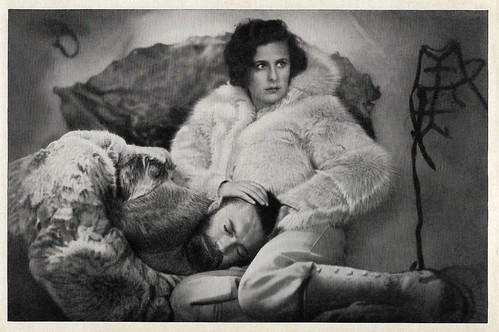
German collectors card in the series 'Vom Werden deutscher Filmkunst - Der Tonfilm', album no. 11, picture no. 43, group 44. Photo: Ufa / Ross Verlag. Leni Riefenstahl and Gustav Diessl in S.O.S. Eisberg/S.O.S. Iceberg (Arnold Fanck, 1933).
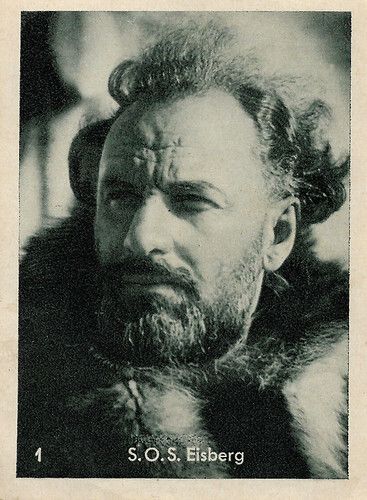
German collectors card by Ufa, Berlin, no. 1. Photo: Ufa. Sepp Rist in S.O.S. Eisberg/S.O.S. Iceberg (Arnold Fanck, 1933).
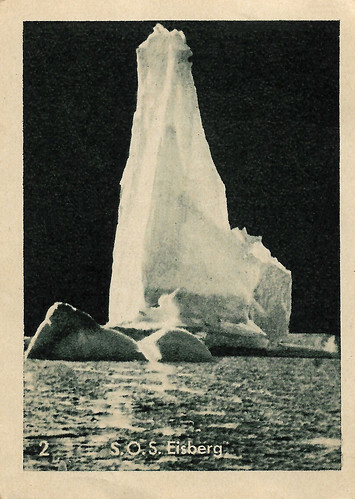
German collectors card by Ufa, Berlin, no. 2. Photo: Ufa. Scene from S.O.S. Eisberg/S.O.S. Iceberg (Arnold Fanck, 1933).
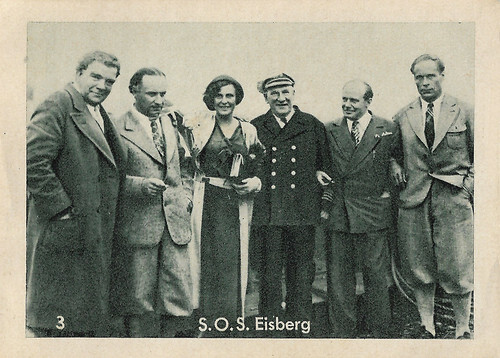
German collectors card by Ufa, Berlin, no. 3. Photo: Ufa. Leni Riefenstahl and crew at the set of S.O.S. Eisberg/S.O.S. Iceberg (Arnold Fanck, 1933).
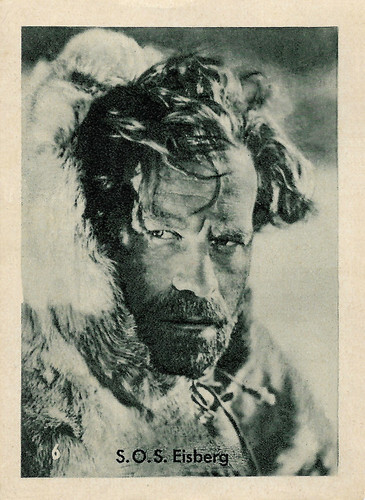
German collectors card by Ufa, Berlin, no. 6. Photo: Ufa. Gustav Diessl in S.O.S. Eisberg/S.O.S. Iceberg (Arnold Fanck, 1933).
A request from Hollywood
At the beginning of 1932, German film director Arnold Fanck received a request from Hollywood to make a "nature feature film" for Universal Pictures. The film industry executives had in mind a project comparable to Fanck's mountain films Die weiße Hölle vom Piz Palü/The White Hell of Pitz Palu (Arnold Fanck, Georg Wilhelm Pabst, 1929) and Stürme über dem Montblanc/Storm over Mont Blanc (Arnold Fanck, 1930) since both had also been successfully shown in cinemas in the United States.
Fanck's first proposal to shoot on Mount McKinley in Alaska did not convince the Universal film bosses. A far more spectacular location had to be found, a setting that promised a cinematic enhancement of the theme of mountains, snow and ice that had already been introduced to filmgoers. In Fanck's circle of collaborators, Sepp Allgeier, Richard Angst and Bernhard Villinger, there had already been relevant experiences with Greenland and the Arctic Circle, respectively, since 1913 and 1926.
Fanck had already dealt with Greenland as a filming location earlier. For example, he wrote the manuscript for the film Milak, der Grönlandjäger/Milak, the Greenland Hunter (Georg Asagaroff, Bernhard Villinger, 1928). The Greenland expeditions of Umberto Nobile with the airship Italia in 1928 and of Alfred Wegener in 1930, which ended in drama, were present in the collective memory of the time so that the apron seemed prepared for a spectacular cinema film about Greenland.
Fanck transmitted his exposé expensively by telegram to Hollywood and travelled with his secretary and friend Elisabeth Kind on the Bremen to New York City in May 1932 and from there by rail across the North American continent to Los Angeles. There he was greeted by Paul Kohner and awaited by studio boss Carl Laemmle, who hosted a reception in his honour with Hollywood greats such as Marlene Dietrich and Greta Garbo . The cinematic venture was given a budget of 1 million Reichsmarks, the most expensive and elaborate project in film history up to that point.
Till 1948, Greenland was a territory closed to tourists or foreigners. Filming with actors, therefore, required the Danish authorities to circumvent this provision. Without further ado, the filming was declared a scientific expedition with the help of the ethnologist and polar explorer Knud Rasmussen, who also took over the patronage for the film. In addition, the glaciologists Fritz Loewe and Ernst Sorge were engaged, who had already made a name for themselves through their participation in Alfred Wegener's expeditions.

German collectors card by Ufa, Berlin, no. 9. Photo: Ufa. Leni Riefenstahl in S.O.S. Eisberg/S.O.S. Iceberg (Arnold Fanck, 1933).
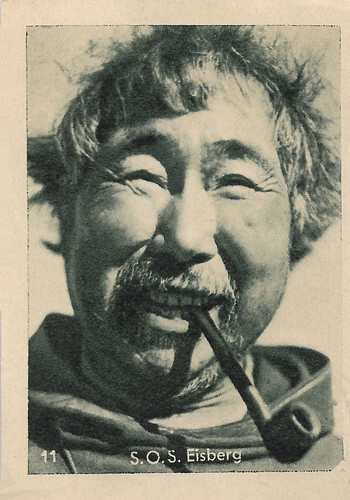
German collectors card by Ufa, Berlin, no. 11. Photo: Ufa. Scene from S.O.S. Eisberg/S.O.S. Iceberg (Arnold Fanck, 1933).
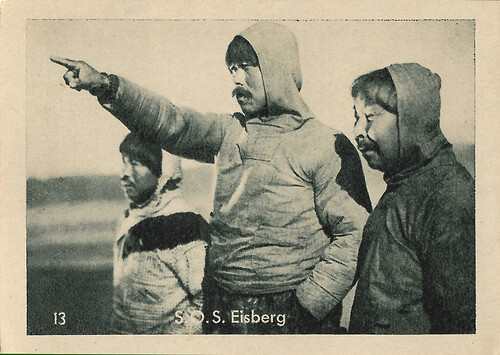
German collectors card by Ufa, Berlin, no. 13. Photo: Ufa. Scene from S.O.S. Eisberg/S.O.S. Iceberg (Arnold Fanck, 1933).
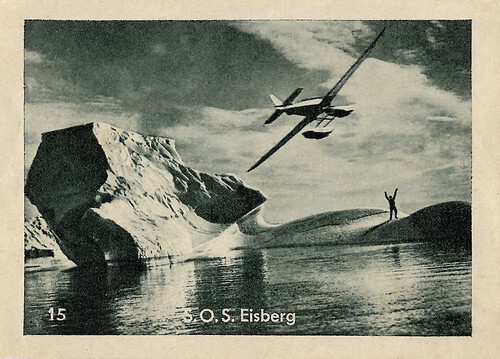
German collectors card by Ufa, Berlin, no. 15. Photo: Ufa. Scene from S.O.S. Eisberg/S.O.S. Iceberg (Arnold Fanck, 1933).
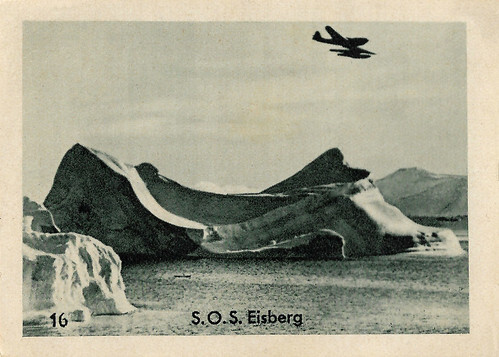
German collectors card by Ufa, Berlin, no. 16. Photo: Ufa. Scene from S.O.S. Eisberg/S.O.S. Iceberg (Arnold Fanck, 1933).
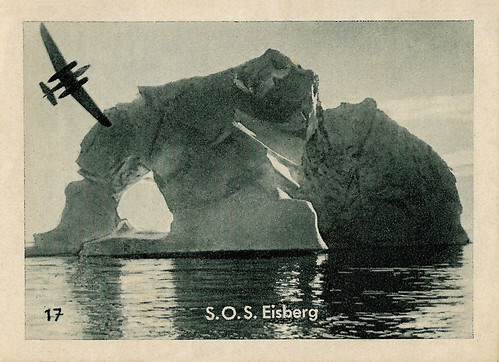
German collectors card by Ufa, Berlin, no. 17. Photo: Ufa. Scene from S.O.S. Eisberg/S.O.S. Iceberg (Arnold Fanck, 1933).
Riefenstahl, in her last film as an actress
Among the stars in S.O.S. Eisberg (Arnold Fanck, 1933) was Leni Riefenstahl , who had just made her directorial debut in Das blaue Licht/The Blue Light (Leni Riefenstahl, 1932). Riefenstahl, in her last film as an actress, co-starred with Gustav Diessl and Ernst Udet in the German version S.O.S. Eisberg, and with Gibson Gowland and Rod La Rocque in the English version, S.O.S. Iceberg. Ernst Udet, a former German ace in the First World War, in a cameo performance, flew in both versions.
S.O.S. Eisberg follows the account of the real-life Alfred Lothar Wegener polar expedition of 1929-1930. In April-October 1929, Wegener embarked on his third expedition to Greenland, which laid the groundwork for the main expedition that he was planning to lead in 1930-1931. Wegener's last Greenland expedition was in 1930.
The 14 participants under his leadership were to establish three permanent stations from which the thickness of the Greenland ice sheet could be measured and year-round Arctic weather observations made. They would travel on the ice cap using two innovative, propeller-driven snowmobiles, in addition to ponies and dog sledges. Wegener felt personally responsible for the expedition's success, as the German government had contributed $120,000 ($1.5 million in 2007 dollars).
Success depended on enough provisions being transferred from West camp to Eismitte ("mid-ice") for two men to winter there, and this was a factor in the decision that led to his death. Owing to a late thaw, the expedition was six weeks behind schedule and, as summer ended, the men at Eismitte sent a message that they had insufficient fuel and so would return on 20 October. On 24 September, although the route markers were by now largely buried under snow, Wegener set out with thirteen Greenlanders and his meteorologist Fritz Loewe to supply the camp by dog sledge. During the journey, the temperature reached −60 °C (−76 °F) and Loewe's toes became so frostbitten they had to be amputated with a penknife without anaesthetic.
Twelve of the Greenlanders returned to West camp. On 19 October the remaining three members of the expedition reached Eismitte. Expedition member Johannes Georgi estimated that there were only enough supplies for three at Eismitte, so Wegener and Rasmus Villumsen took two dog sledges and made them for West camp. They took no food for the dogs and killed them one by one to feed the rest until they could run only one sledge. While Villumsen rode the sledge, Wegener had to use skis, but they never reached the camp: Wegener died and Villumsen was never seen again. After Wegener was declared missing in May 1931, and his body found shortly thereafter, Kurt Wegener took over the expedition's leadership in July, according to the prearranged plan for such an eventuality.
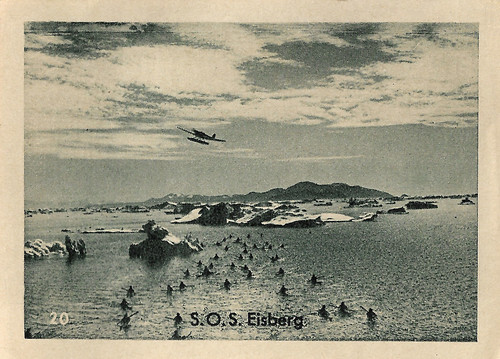
German collectors card by Ufa, Berlin, no. 20. Photo: Ufa. Scene from S.O.S. Eisberg/S.O.S. Iceberg (Arnold Fanck, 1933).
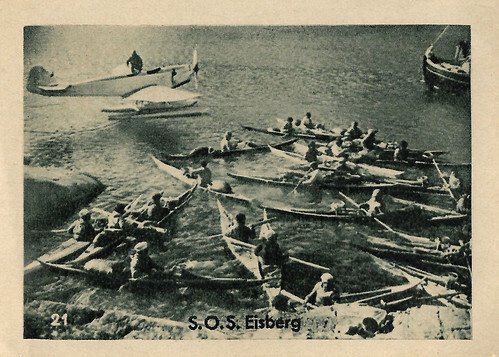
German collectors card by Ufa, Berlin, no. 21. Photo: Ufa. Scene from S.O.S. Eisberg/S.O.S. Iceberg (Arnold Fanck, 1933).
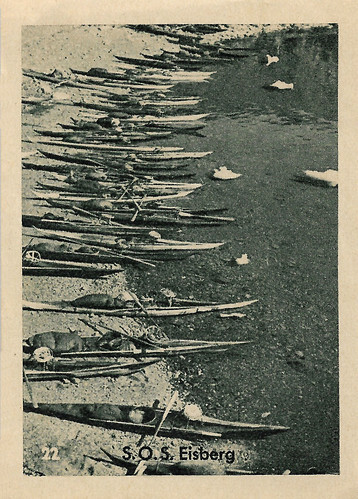
German collectors card by Ufa, Berlin, no. 22. Photo: Ufa. Publicity still for S.O.S. Eisberg/S.O.S. Iceberg (Arnold Fanck, 1933).
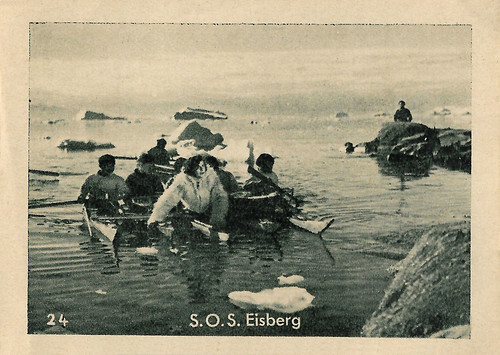
German collectors card by Ufa, Berlin, no. 24 of 24. Photo: Ufa. Leni Riefenstahl in S.O.S. Eisberg/S.O.S. Iceberg (Arnold Fanck, 1933).
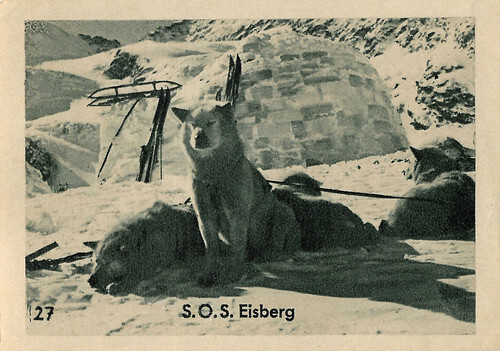
German collectors card by Ufa, Berlin, no. 27. Photo: Ufa. Publicity still for S.O.S. Eisberg/S.O.S. Iceberg (Arnold Fanck, 1933).
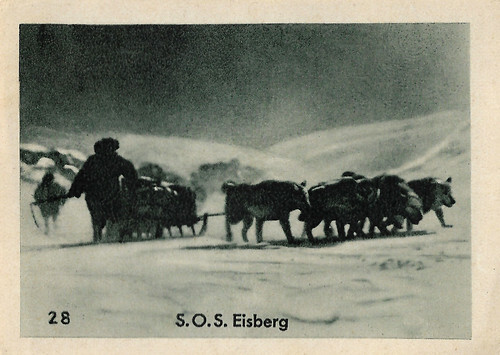
German collectors card by Ufa, Berlin, no. 28. Photo: Ufa. Publicity still for S.O.S. Eisberg/S.O.S. Iceberg (Arnold Fanck, 1933).
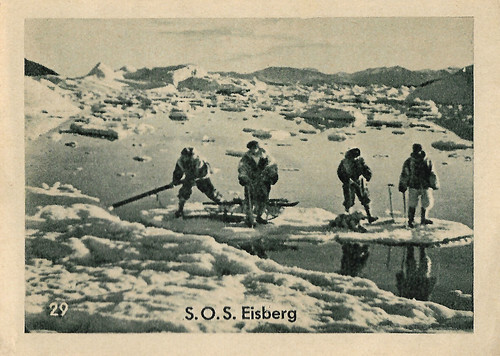
German collectors card by Ufa, Berlin, no. 29. Photo: Ufa. Publicity still for S.O.S. Eisberg/S.O.S. Iceberg (Arnold Fanck, 1933).
Brand begins sending out an S.O.S. on his wireless
This expedition inspired the Greenland expedition episode of Adam Melfort in John Buchan's novel 'A Prince of the Captivity' (1944) and the film S.O.S. Eisberg/S.O.S. Iceberg (Arnold Fanck, 1933). At a banquet at the International Society for Arctic Research, he members toast scientist Dr. Carl Lorenz (Gustav Diessl), who is about to recreate famed explorer Wegener's ill-fated expedition. Lawrence's team consists of two scientists, Dr. Johannes Brand ( Sepp Rist ) and Dr. Jan Matushek (Max Holzboer), his friend, Fritz Kuemmel (Walter Riml), their financial backer, John Dragan (Walter Riml), and their pilot to the Arctic, Lorenz's wife Hella ( Leni Riefenstahl ).
After Hella drops them at their base camp, the men begin their long trek to recover Wegener's records and prove his theories on ice floes. As the weeks pass, Brand and the others fear they will not survive when the ice breaks up, but Lorenz scoffs and refuses to wait until winter. Early one morning, Lorenz sets out on his own. His companions fear he is lost.
They find a hut Wegener occupied and a note from Lorenz saying that he is trying to reach a native village. Suddenly, the break up of the ice leaves their sledges of food supplies tumbling into a ravine. The rescuers take refuge on a huge iceberg where they discover that Lorenz is there, dazed and uncommunicative. Brand begins sending out an S.O.S. on his wireless and Hella immediately leaves to search for her husband. Disaster strikes, with Dragan going mad, and as Kümmel fights with him to prevent their dog, Nakinak, from being killed, Kümmel falls to his death.
When Hella finds the survivors, she misjudges her landing and crashes but is able to swim to the iceberg. Brand seeing they are drifting out to sea, dives into the water, and is picked up by another pilot (Ernst Udet) following Hella's flight path. The pilot flies Brand to the nearby Inuit village. Matushek sees two polar bears fighting over a seal but is killed when he tries to spear the bears.
Dragan then attacks Hella, but by then her husband has come to his senses, and she is saved. The iceberg begins to come apart, throwing Dragan into the sea. Lorenz, Hella and Nakinak are rescued by the Inuit. The three survivors later are aboard a ship bound for home, but Lorenz is haunted by the deaths incurred in his misguided expedition.
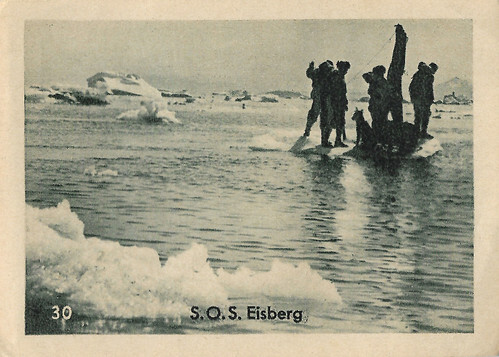
German collectors card by Ufa, Berlin, no. 30. Photo: Ufa. Publicity still for S.O.S. Eisberg/S.O.S. Iceberg (Arnold Fanck, 1933).
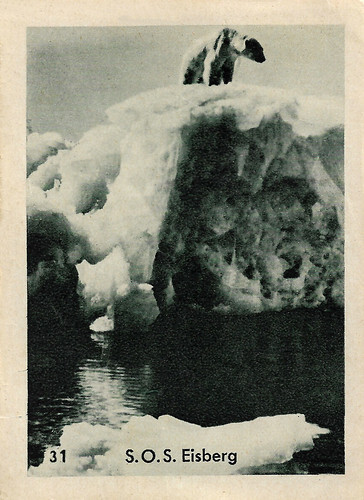
German collectors card by Ufa, Berlin, no. 31. Photo: Ufa. Publicity still for S.O.S. Eisberg/S.O.S. Iceberg (Arnold Fanck, 1933).
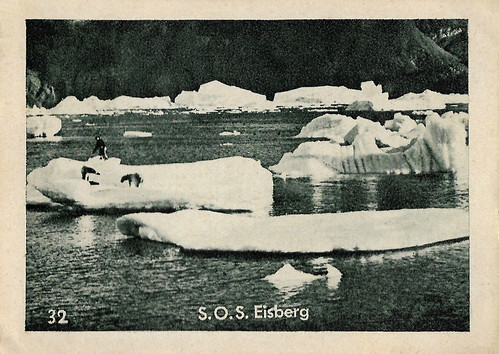
German collectors card by Ufa, Berlin, no. 32. Photo: Ufa. Publicity still for S.O.S. Eisberg/S.O.S. Iceberg (Arnold Fanck, 1933).
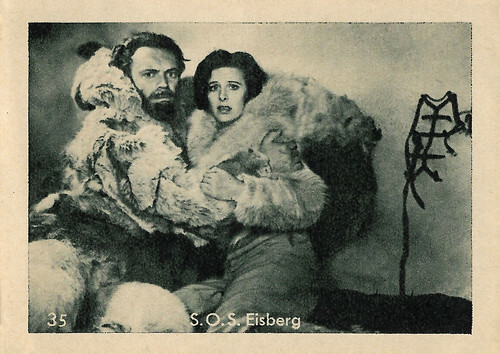
German collectors card by Ufa, Berlin, no. 35. Photo: Ufa. Gustav Diessl and Leni Riefenstahl in S.O.S. Eisberg/S.O.S. Iceberg (Arnold Fanck, 1933).
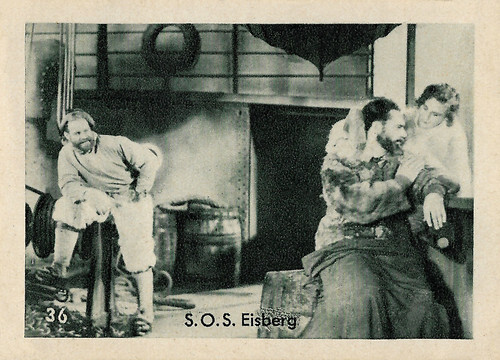
German collectors card by Ufa, Berlin, no. 36. Photo: Ufa. Gustav Diessl and Leni Riefenstahl at right in S.O.S. Eisberg/S.O.S. Iceberg (Arnold Fanck, 1933).
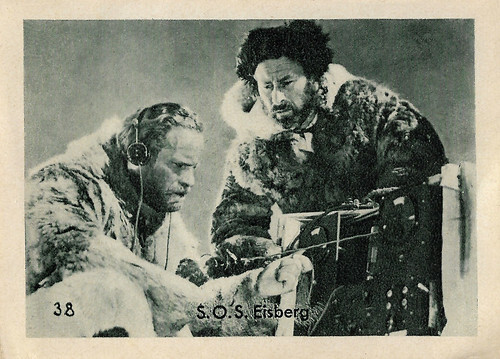
German collectors card by Ufa, Berlin, no. 38. Photo: UfA. Sepp Rist in S.O.S. Eisberg/S.O.S. Iceberg (Arnold Fanck, 1933).
Sources: Wikipedia (German and English) and IMDb.

German collectors card in the series 'Vom Werden deutscher Filmkunst - Der Tonfilm', album no. 11, picture no. 43, group 44. Photo: Ufa / Ross Verlag. Leni Riefenstahl and Gustav Diessl in S.O.S. Eisberg/S.O.S. Iceberg (Arnold Fanck, 1933).

German collectors card by Ufa, Berlin, no. 1. Photo: Ufa. Sepp Rist in S.O.S. Eisberg/S.O.S. Iceberg (Arnold Fanck, 1933).

German collectors card by Ufa, Berlin, no. 2. Photo: Ufa. Scene from S.O.S. Eisberg/S.O.S. Iceberg (Arnold Fanck, 1933).

German collectors card by Ufa, Berlin, no. 3. Photo: Ufa. Leni Riefenstahl and crew at the set of S.O.S. Eisberg/S.O.S. Iceberg (Arnold Fanck, 1933).

German collectors card by Ufa, Berlin, no. 6. Photo: Ufa. Gustav Diessl in S.O.S. Eisberg/S.O.S. Iceberg (Arnold Fanck, 1933).
A request from Hollywood
At the beginning of 1932, German film director Arnold Fanck received a request from Hollywood to make a "nature feature film" for Universal Pictures. The film industry executives had in mind a project comparable to Fanck's mountain films Die weiße Hölle vom Piz Palü/The White Hell of Pitz Palu (Arnold Fanck, Georg Wilhelm Pabst, 1929) and Stürme über dem Montblanc/Storm over Mont Blanc (Arnold Fanck, 1930) since both had also been successfully shown in cinemas in the United States.
Fanck's first proposal to shoot on Mount McKinley in Alaska did not convince the Universal film bosses. A far more spectacular location had to be found, a setting that promised a cinematic enhancement of the theme of mountains, snow and ice that had already been introduced to filmgoers. In Fanck's circle of collaborators, Sepp Allgeier, Richard Angst and Bernhard Villinger, there had already been relevant experiences with Greenland and the Arctic Circle, respectively, since 1913 and 1926.
Fanck had already dealt with Greenland as a filming location earlier. For example, he wrote the manuscript for the film Milak, der Grönlandjäger/Milak, the Greenland Hunter (Georg Asagaroff, Bernhard Villinger, 1928). The Greenland expeditions of Umberto Nobile with the airship Italia in 1928 and of Alfred Wegener in 1930, which ended in drama, were present in the collective memory of the time so that the apron seemed prepared for a spectacular cinema film about Greenland.
Fanck transmitted his exposé expensively by telegram to Hollywood and travelled with his secretary and friend Elisabeth Kind on the Bremen to New York City in May 1932 and from there by rail across the North American continent to Los Angeles. There he was greeted by Paul Kohner and awaited by studio boss Carl Laemmle, who hosted a reception in his honour with Hollywood greats such as Marlene Dietrich and Greta Garbo . The cinematic venture was given a budget of 1 million Reichsmarks, the most expensive and elaborate project in film history up to that point.
Till 1948, Greenland was a territory closed to tourists or foreigners. Filming with actors, therefore, required the Danish authorities to circumvent this provision. Without further ado, the filming was declared a scientific expedition with the help of the ethnologist and polar explorer Knud Rasmussen, who also took over the patronage for the film. In addition, the glaciologists Fritz Loewe and Ernst Sorge were engaged, who had already made a name for themselves through their participation in Alfred Wegener's expeditions.

German collectors card by Ufa, Berlin, no. 9. Photo: Ufa. Leni Riefenstahl in S.O.S. Eisberg/S.O.S. Iceberg (Arnold Fanck, 1933).

German collectors card by Ufa, Berlin, no. 11. Photo: Ufa. Scene from S.O.S. Eisberg/S.O.S. Iceberg (Arnold Fanck, 1933).

German collectors card by Ufa, Berlin, no. 13. Photo: Ufa. Scene from S.O.S. Eisberg/S.O.S. Iceberg (Arnold Fanck, 1933).

German collectors card by Ufa, Berlin, no. 15. Photo: Ufa. Scene from S.O.S. Eisberg/S.O.S. Iceberg (Arnold Fanck, 1933).

German collectors card by Ufa, Berlin, no. 16. Photo: Ufa. Scene from S.O.S. Eisberg/S.O.S. Iceberg (Arnold Fanck, 1933).

German collectors card by Ufa, Berlin, no. 17. Photo: Ufa. Scene from S.O.S. Eisberg/S.O.S. Iceberg (Arnold Fanck, 1933).
Riefenstahl, in her last film as an actress
Among the stars in S.O.S. Eisberg (Arnold Fanck, 1933) was Leni Riefenstahl , who had just made her directorial debut in Das blaue Licht/The Blue Light (Leni Riefenstahl, 1932). Riefenstahl, in her last film as an actress, co-starred with Gustav Diessl and Ernst Udet in the German version S.O.S. Eisberg, and with Gibson Gowland and Rod La Rocque in the English version, S.O.S. Iceberg. Ernst Udet, a former German ace in the First World War, in a cameo performance, flew in both versions.
S.O.S. Eisberg follows the account of the real-life Alfred Lothar Wegener polar expedition of 1929-1930. In April-October 1929, Wegener embarked on his third expedition to Greenland, which laid the groundwork for the main expedition that he was planning to lead in 1930-1931. Wegener's last Greenland expedition was in 1930.
The 14 participants under his leadership were to establish three permanent stations from which the thickness of the Greenland ice sheet could be measured and year-round Arctic weather observations made. They would travel on the ice cap using two innovative, propeller-driven snowmobiles, in addition to ponies and dog sledges. Wegener felt personally responsible for the expedition's success, as the German government had contributed $120,000 ($1.5 million in 2007 dollars).
Success depended on enough provisions being transferred from West camp to Eismitte ("mid-ice") for two men to winter there, and this was a factor in the decision that led to his death. Owing to a late thaw, the expedition was six weeks behind schedule and, as summer ended, the men at Eismitte sent a message that they had insufficient fuel and so would return on 20 October. On 24 September, although the route markers were by now largely buried under snow, Wegener set out with thirteen Greenlanders and his meteorologist Fritz Loewe to supply the camp by dog sledge. During the journey, the temperature reached −60 °C (−76 °F) and Loewe's toes became so frostbitten they had to be amputated with a penknife without anaesthetic.
Twelve of the Greenlanders returned to West camp. On 19 October the remaining three members of the expedition reached Eismitte. Expedition member Johannes Georgi estimated that there were only enough supplies for three at Eismitte, so Wegener and Rasmus Villumsen took two dog sledges and made them for West camp. They took no food for the dogs and killed them one by one to feed the rest until they could run only one sledge. While Villumsen rode the sledge, Wegener had to use skis, but they never reached the camp: Wegener died and Villumsen was never seen again. After Wegener was declared missing in May 1931, and his body found shortly thereafter, Kurt Wegener took over the expedition's leadership in July, according to the prearranged plan for such an eventuality.

German collectors card by Ufa, Berlin, no. 20. Photo: Ufa. Scene from S.O.S. Eisberg/S.O.S. Iceberg (Arnold Fanck, 1933).

German collectors card by Ufa, Berlin, no. 21. Photo: Ufa. Scene from S.O.S. Eisberg/S.O.S. Iceberg (Arnold Fanck, 1933).

German collectors card by Ufa, Berlin, no. 22. Photo: Ufa. Publicity still for S.O.S. Eisberg/S.O.S. Iceberg (Arnold Fanck, 1933).

German collectors card by Ufa, Berlin, no. 24 of 24. Photo: Ufa. Leni Riefenstahl in S.O.S. Eisberg/S.O.S. Iceberg (Arnold Fanck, 1933).

German collectors card by Ufa, Berlin, no. 27. Photo: Ufa. Publicity still for S.O.S. Eisberg/S.O.S. Iceberg (Arnold Fanck, 1933).

German collectors card by Ufa, Berlin, no. 28. Photo: Ufa. Publicity still for S.O.S. Eisberg/S.O.S. Iceberg (Arnold Fanck, 1933).

German collectors card by Ufa, Berlin, no. 29. Photo: Ufa. Publicity still for S.O.S. Eisberg/S.O.S. Iceberg (Arnold Fanck, 1933).
Brand begins sending out an S.O.S. on his wireless
This expedition inspired the Greenland expedition episode of Adam Melfort in John Buchan's novel 'A Prince of the Captivity' (1944) and the film S.O.S. Eisberg/S.O.S. Iceberg (Arnold Fanck, 1933). At a banquet at the International Society for Arctic Research, he members toast scientist Dr. Carl Lorenz (Gustav Diessl), who is about to recreate famed explorer Wegener's ill-fated expedition. Lawrence's team consists of two scientists, Dr. Johannes Brand ( Sepp Rist ) and Dr. Jan Matushek (Max Holzboer), his friend, Fritz Kuemmel (Walter Riml), their financial backer, John Dragan (Walter Riml), and their pilot to the Arctic, Lorenz's wife Hella ( Leni Riefenstahl ).
After Hella drops them at their base camp, the men begin their long trek to recover Wegener's records and prove his theories on ice floes. As the weeks pass, Brand and the others fear they will not survive when the ice breaks up, but Lorenz scoffs and refuses to wait until winter. Early one morning, Lorenz sets out on his own. His companions fear he is lost.
They find a hut Wegener occupied and a note from Lorenz saying that he is trying to reach a native village. Suddenly, the break up of the ice leaves their sledges of food supplies tumbling into a ravine. The rescuers take refuge on a huge iceberg where they discover that Lorenz is there, dazed and uncommunicative. Brand begins sending out an S.O.S. on his wireless and Hella immediately leaves to search for her husband. Disaster strikes, with Dragan going mad, and as Kümmel fights with him to prevent their dog, Nakinak, from being killed, Kümmel falls to his death.
When Hella finds the survivors, she misjudges her landing and crashes but is able to swim to the iceberg. Brand seeing they are drifting out to sea, dives into the water, and is picked up by another pilot (Ernst Udet) following Hella's flight path. The pilot flies Brand to the nearby Inuit village. Matushek sees two polar bears fighting over a seal but is killed when he tries to spear the bears.
Dragan then attacks Hella, but by then her husband has come to his senses, and she is saved. The iceberg begins to come apart, throwing Dragan into the sea. Lorenz, Hella and Nakinak are rescued by the Inuit. The three survivors later are aboard a ship bound for home, but Lorenz is haunted by the deaths incurred in his misguided expedition.

German collectors card by Ufa, Berlin, no. 30. Photo: Ufa. Publicity still for S.O.S. Eisberg/S.O.S. Iceberg (Arnold Fanck, 1933).

German collectors card by Ufa, Berlin, no. 31. Photo: Ufa. Publicity still for S.O.S. Eisberg/S.O.S. Iceberg (Arnold Fanck, 1933).

German collectors card by Ufa, Berlin, no. 32. Photo: Ufa. Publicity still for S.O.S. Eisberg/S.O.S. Iceberg (Arnold Fanck, 1933).

German collectors card by Ufa, Berlin, no. 35. Photo: Ufa. Gustav Diessl and Leni Riefenstahl in S.O.S. Eisberg/S.O.S. Iceberg (Arnold Fanck, 1933).

German collectors card by Ufa, Berlin, no. 36. Photo: Ufa. Gustav Diessl and Leni Riefenstahl at right in S.O.S. Eisberg/S.O.S. Iceberg (Arnold Fanck, 1933).

German collectors card by Ufa, Berlin, no. 38. Photo: UfA. Sepp Rist in S.O.S. Eisberg/S.O.S. Iceberg (Arnold Fanck, 1933).
Sources: Wikipedia (German and English) and IMDb.
Published on March 29, 2023 22:00
March 28, 2023
Tania Fedor
Tania Fédor (1905-1985) was a Monaco-born French film actress, who peaked in the early 1930s in such films as Le petit café (Ludwig Berger, 1931) with Maurice Chevalier and Fantômas (Pál Fejös, 1932) with Jean Galland in the title role and Thomy Bourdelle as Inspector Juve.
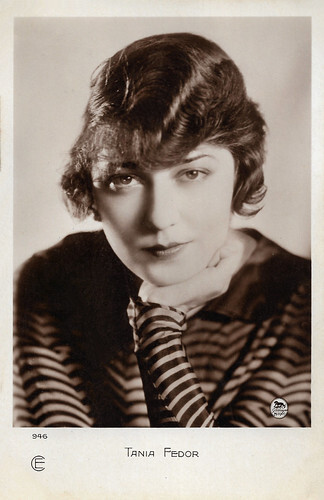
French postcard by Cinémagazine-Edition, Paris, no. 946. Photo: Metro-Goldwyn-Mayer.
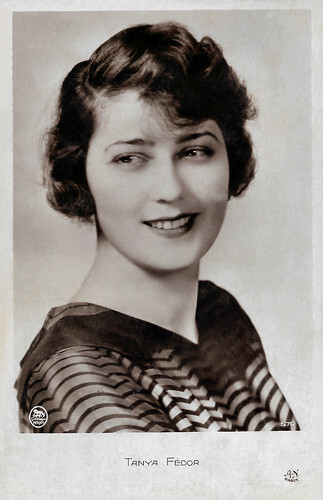
French postcard by A.N., Paris, no. 570. Photo: Metro-Goldwyn-Mayer.
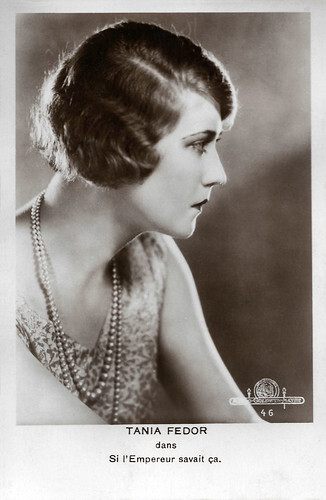
Belgian postcard by P.I.A. Belgaphot, Bruxelles, no. 46. Photo: Metro-Goldwyn-Mayer. Tania Fédor in Si l’empereur savait ça/His Glorious Night (Jacques Feyder, 1930). Caption: The most beautiful films are performed by the stars of Metro Goldwyn Mayer.
Clutching hands and screams in the dark
Tania Fedor was born Tatania d'Ermter in 1905 in Monte-Carlo, Monaco. She came from a Russian aristocratic family and like other Russian royalty, her family later found a permanent home in France. Tania studied acting in Paris and in 1924 she was already on the stage of the Comédie Française, France's most famous theatre. She was a Pensionnaire of the Comédie-Française from 1925 to 1930. where she acted in plays by Alexandre Dumas, Sr., Molière and Jean Racine.
In 1926, she made her film debut in L'Inconnue des six jours/The unknown of six days (René Sti, 1926). Later she performed in other theatres like Odéon and Théâtre de France. In 1930, she left the Comédie Française to join Jacques Feyder's French team in Hollywood to shoot Si l'Empereur savait ça!/If the Emperor Only Knew That (Jacques Feyder, 1930). Tania Fédor was hooked. After making another film in Hollywood, she preferred to return to France to become primarily a film actress.
One of her first sound films was Le petit café/The Little Cafe (Ludwig Berger, 1931), a French-language American Pre-Code musical film starring Maurice Chevalier , Yvonne Vallée and Fédor. The film is a foreign-language version of the film Playboy of Paris (1930), which was based on the play 'The Little Cafe' by Tristan Bernard. Multiple-language versions were standard in the years following the introduction of sound film, before dubbing became widespread. It was shot at the Joinville Studios in Paris.
Fedor played Lady Beltham in the popular sound version of Fantômas (Pál Fejös, 1932). Hal Erickson at AllMovie : "Back to his old tricks, the hooded, black-clad Fantomas goes around robbing from the rich and giving to himself, though he's not quite as homicidally inclined here as he'd been in his earlier film appearances. Jean Galland stars as the elusive "hero," while Thomy Bourdelle plays the detective who dedicates his life to bringing Fantomas to justice. Director Fejos doesn't miss a trick, running through a gamut that includes clutching hands and screams in the dark."
Based on the fairy tale 'A Thousand and One Nights', she then made the film La mille et deuxième nuit (Alexandre Volkoff, 1933), in which she starred alongside Russian actor Ivan Mozzhukhin . Abel Gance directed her as Queen Anne of Austria in Jérôme Perreau héros des barricades/The Queen and the Cardinal (Abel Gance, 1935) with George Milton and Samson Fainsilber .
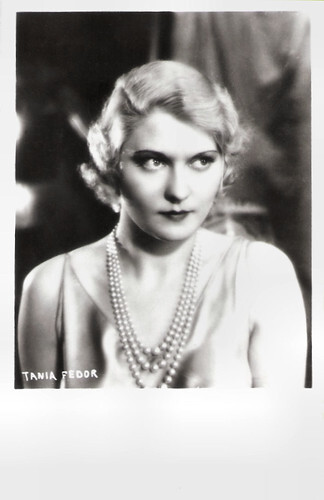
Vintage card.
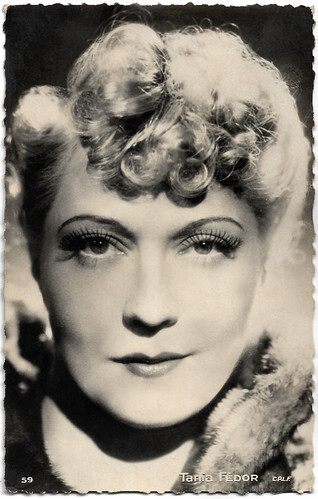
French postcard by Edit. Chantal, Rueil, no. 59. Photo: C.P.L.F.
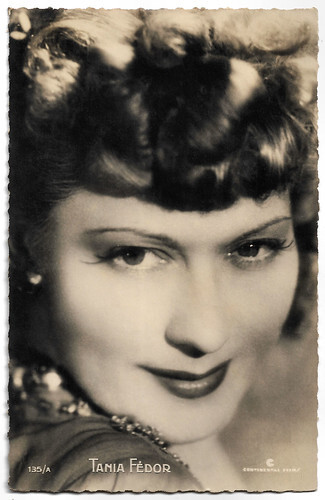
French postcard by Editions Continental, no. 135/A. Photo: Continental Films.
Orgies that were famous throughout the country
Tania Fedor had another success with the Alexandre Dumas père adaptation La tour de Nesle/The Tower of Nesle (Gaston Roudès, 1937) with Jean Weber . In the 13th century, the aristocrat Marguerite de Bourgogne organised orgies that were famous throughout the country. Secretly, the suitors were murdered the day after these festivities and thrown into the Seine.
Fedor also appeared in the drama Carrefour/Crossroads (Kurt (later: Curtis) Bernhardt, 1938) starring Charles Vanel , Jules Berry and Suzy Prim . It inspired two English-language remakes, the British film Dead Man's Shoes (1940) and Hollywood's Crossroads (1942). In the early 1940s, she appeared opposite Raimu in the drama Les Inconnus dans la maison/The Strangers in the House (Henri Decoin, 1942), after the novel by the same name by Georges Simenon.
During the 1950s he played smaller parts in such films as Lucrèce Borgia/Lucretia Borgia (Christian-Jaque, 1953) starring Martine Carol and Pedro Armendáriz. The film tells the story of the Borgia family of Italy during the Renaissance. In the historical mosaic Si Versailles m'était conté/Affairs in Versailles (Sacha Guitry, 1953) she played Queen Marie Leszczyńska. Her husband Louis XV was played by Jean Marais .
In 1955, Fédor left for Canada and settled in Montréal, where she decided to work as a teacher. She opened her studio and at the same time taught at the Conservatoire du Québec in Montreal and at the National Theatre School. She continued to perform in the theatre and appeared in numerous television plays. Although she never acquired a proper Quebec accent, each of her performances on stage and in front of the camera was a great success. She also occasionally reappeared in films such as the groundbreaking drama À tout prendre/All Things Considered (Claude Jutra, 1963).
The film was a semi-autobiographical portrait of Jutra's own life, focusing on his romantic relationship with actress and model Johanne Harrelle, and his struggle to accept his own homosexuality. Both Jutra and Harrelle played themselves in the film. Notably, the film version of Jutra commits suicide at the end of the film in virtually the same manner, drowning himself in the St. Lawrence River, in which Jutra himself would eventually commit suicide in 1986 after being diagnosed with early-onset Alzheimer's. Considered a landmark film in the history of Quebec and Canadian cinema, the film won the Canadian Film Award for Best Feature Film at the 16th Canadian Film Awards.
Tania Fédor retired in 1971 and spent the last years of her life in Chez Nous des Artistes, a retirement home for ageing artists. Tania Fedor passed away in 1985 in Montreal, Canada. She was 80.
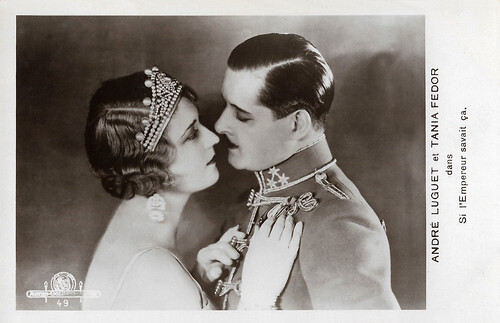
Belgian postcard by P.I.A. Belgaphot, Bruxelles, no. 49. Photo: Metro-Goldwyn-Mayer. Tania Fédor and André Luguet in Si l’empereur savait ça/If the Emperor Only Knew That (Jacques Feyder, 1930).
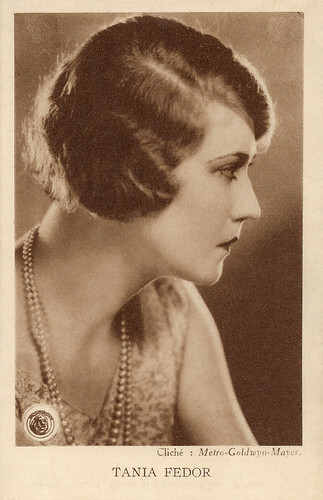
Belgian postcard by S.A. Cacao et Chocolat Kivou, Vilvorde. Photo: Metro-Goldwyn-Mayer.
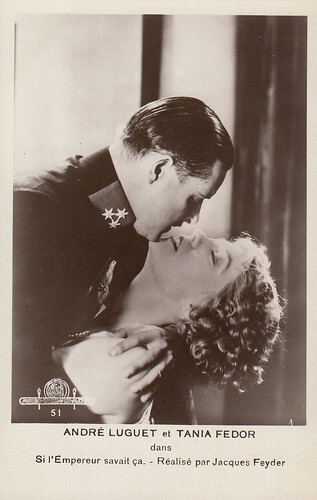
Belgian postcard by P.I.A. Belgaphot, Bruxelles, no. 51. Photo: Metro-Goldwyn-Mayer. Tania Fédor and André Luguet in Si l’empereur savait ça/If the Emperor Only Knew That (Jacques Feyder, 1930). Collection: Marlene Pilaete.
Sources: Hal Erickson (AllMovie), Pavel "argenson" Vlach (CSFD - Czech), Alexandre Carle (Les gens du Cinema - French), Wikipedia (French and English) and .

French postcard by Cinémagazine-Edition, Paris, no. 946. Photo: Metro-Goldwyn-Mayer.

French postcard by A.N., Paris, no. 570. Photo: Metro-Goldwyn-Mayer.

Belgian postcard by P.I.A. Belgaphot, Bruxelles, no. 46. Photo: Metro-Goldwyn-Mayer. Tania Fédor in Si l’empereur savait ça/His Glorious Night (Jacques Feyder, 1930). Caption: The most beautiful films are performed by the stars of Metro Goldwyn Mayer.
Clutching hands and screams in the dark
Tania Fedor was born Tatania d'Ermter in 1905 in Monte-Carlo, Monaco. She came from a Russian aristocratic family and like other Russian royalty, her family later found a permanent home in France. Tania studied acting in Paris and in 1924 she was already on the stage of the Comédie Française, France's most famous theatre. She was a Pensionnaire of the Comédie-Française from 1925 to 1930. where she acted in plays by Alexandre Dumas, Sr., Molière and Jean Racine.
In 1926, she made her film debut in L'Inconnue des six jours/The unknown of six days (René Sti, 1926). Later she performed in other theatres like Odéon and Théâtre de France. In 1930, she left the Comédie Française to join Jacques Feyder's French team in Hollywood to shoot Si l'Empereur savait ça!/If the Emperor Only Knew That (Jacques Feyder, 1930). Tania Fédor was hooked. After making another film in Hollywood, she preferred to return to France to become primarily a film actress.
One of her first sound films was Le petit café/The Little Cafe (Ludwig Berger, 1931), a French-language American Pre-Code musical film starring Maurice Chevalier , Yvonne Vallée and Fédor. The film is a foreign-language version of the film Playboy of Paris (1930), which was based on the play 'The Little Cafe' by Tristan Bernard. Multiple-language versions were standard in the years following the introduction of sound film, before dubbing became widespread. It was shot at the Joinville Studios in Paris.
Fedor played Lady Beltham in the popular sound version of Fantômas (Pál Fejös, 1932). Hal Erickson at AllMovie : "Back to his old tricks, the hooded, black-clad Fantomas goes around robbing from the rich and giving to himself, though he's not quite as homicidally inclined here as he'd been in his earlier film appearances. Jean Galland stars as the elusive "hero," while Thomy Bourdelle plays the detective who dedicates his life to bringing Fantomas to justice. Director Fejos doesn't miss a trick, running through a gamut that includes clutching hands and screams in the dark."
Based on the fairy tale 'A Thousand and One Nights', she then made the film La mille et deuxième nuit (Alexandre Volkoff, 1933), in which she starred alongside Russian actor Ivan Mozzhukhin . Abel Gance directed her as Queen Anne of Austria in Jérôme Perreau héros des barricades/The Queen and the Cardinal (Abel Gance, 1935) with George Milton and Samson Fainsilber .

Vintage card.

French postcard by Edit. Chantal, Rueil, no. 59. Photo: C.P.L.F.

French postcard by Editions Continental, no. 135/A. Photo: Continental Films.
Orgies that were famous throughout the country
Tania Fedor had another success with the Alexandre Dumas père adaptation La tour de Nesle/The Tower of Nesle (Gaston Roudès, 1937) with Jean Weber . In the 13th century, the aristocrat Marguerite de Bourgogne organised orgies that were famous throughout the country. Secretly, the suitors were murdered the day after these festivities and thrown into the Seine.
Fedor also appeared in the drama Carrefour/Crossroads (Kurt (later: Curtis) Bernhardt, 1938) starring Charles Vanel , Jules Berry and Suzy Prim . It inspired two English-language remakes, the British film Dead Man's Shoes (1940) and Hollywood's Crossroads (1942). In the early 1940s, she appeared opposite Raimu in the drama Les Inconnus dans la maison/The Strangers in the House (Henri Decoin, 1942), after the novel by the same name by Georges Simenon.
During the 1950s he played smaller parts in such films as Lucrèce Borgia/Lucretia Borgia (Christian-Jaque, 1953) starring Martine Carol and Pedro Armendáriz. The film tells the story of the Borgia family of Italy during the Renaissance. In the historical mosaic Si Versailles m'était conté/Affairs in Versailles (Sacha Guitry, 1953) she played Queen Marie Leszczyńska. Her husband Louis XV was played by Jean Marais .
In 1955, Fédor left for Canada and settled in Montréal, where she decided to work as a teacher. She opened her studio and at the same time taught at the Conservatoire du Québec in Montreal and at the National Theatre School. She continued to perform in the theatre and appeared in numerous television plays. Although she never acquired a proper Quebec accent, each of her performances on stage and in front of the camera was a great success. She also occasionally reappeared in films such as the groundbreaking drama À tout prendre/All Things Considered (Claude Jutra, 1963).
The film was a semi-autobiographical portrait of Jutra's own life, focusing on his romantic relationship with actress and model Johanne Harrelle, and his struggle to accept his own homosexuality. Both Jutra and Harrelle played themselves in the film. Notably, the film version of Jutra commits suicide at the end of the film in virtually the same manner, drowning himself in the St. Lawrence River, in which Jutra himself would eventually commit suicide in 1986 after being diagnosed with early-onset Alzheimer's. Considered a landmark film in the history of Quebec and Canadian cinema, the film won the Canadian Film Award for Best Feature Film at the 16th Canadian Film Awards.
Tania Fédor retired in 1971 and spent the last years of her life in Chez Nous des Artistes, a retirement home for ageing artists. Tania Fedor passed away in 1985 in Montreal, Canada. She was 80.

Belgian postcard by P.I.A. Belgaphot, Bruxelles, no. 49. Photo: Metro-Goldwyn-Mayer. Tania Fédor and André Luguet in Si l’empereur savait ça/If the Emperor Only Knew That (Jacques Feyder, 1930).

Belgian postcard by S.A. Cacao et Chocolat Kivou, Vilvorde. Photo: Metro-Goldwyn-Mayer.

Belgian postcard by P.I.A. Belgaphot, Bruxelles, no. 51. Photo: Metro-Goldwyn-Mayer. Tania Fédor and André Luguet in Si l’empereur savait ça/If the Emperor Only Knew That (Jacques Feyder, 1930). Collection: Marlene Pilaete.
Sources: Hal Erickson (AllMovie), Pavel "argenson" Vlach (CSFD - Czech), Alexandre Carle (Les gens du Cinema - French), Wikipedia (French and English) and .
Published on March 28, 2023 22:00
March 27, 2023
Maurice de Féraudy
French actor-director Maurice de Féraudy (1859-1932) was a notable actor of the Comédie-Française and a director and actor in silent cinema. In 1908-1909, he directed almost 40 shorts under the aegis of his short-lived company Théâtro-Films. Later, in old age, he played memorable roles in such classics as Jacques Feyder's Crainquebille/Coster Bill of Paris (1922).
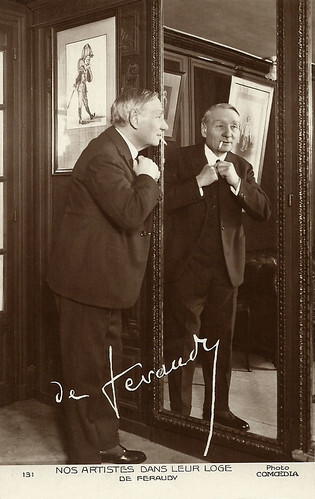
French postcard in the series Nos Artistes dans leur loge, no. 131. Photo: Comoedia.
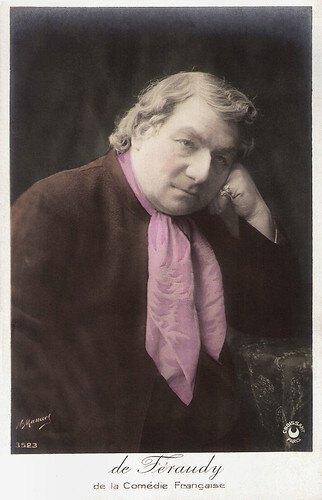
French postcard by Croissant, Paris, no. 3523. Photo Henri Manuel. Written date: 1909. Caption: De Féraudy de la Comédie Française.
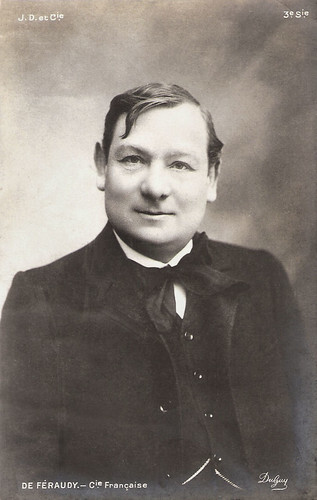
French postcard by J.D, et Cie, 3e Serie. Photo: DuGuy. Caption: De Féraudy, Comédie Française.
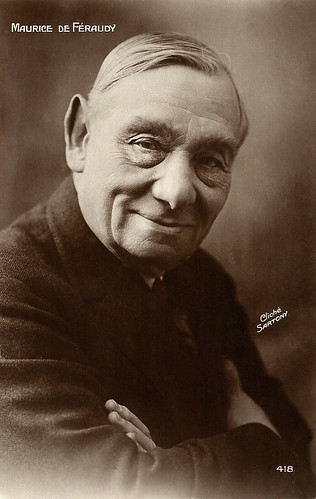
French postcard by Editions Cinémagazine, no. 418. Photo: Sartony.
A pupil of Got
Dominique Marie Maurice de Féraudy was born in Joinville-le-Pont near Paris in 1859. His father was the commander of the Ecole militaire de gymnastique at Joinville-le-Pont.
After the Conservatoire, where he was a pupil of Got, Maurice entered the Théâtre Français in 1880. In 1887, the role of the apothecary in the Molière comedy 'Monsieur de Pourceaugnac' was his breakthrough. That year, he became ‘sociétaire’ of the Comédie-Française, and in 1929 he became ‘doyen’ (dean), but he left that same year.
Maurice de Féraudy was much acclaimed as a comedian, because of his cheerful performances. The role of his life, which he performed some 1,200 times within 30 years – and had the monopoly on it – was that of Isidore Lechat in 'Les affaires sont les affaires' (Business is business) by Octave Mirbeau (1903). Between 1896 and 1905, Féraudy taught at the Conservatoire, training upcoming actors like Gabriel Signoret .
Other plays he acted in were by a.o. Henri Bataille, Henri Kistemaeckers, Sacha Guitry , Henrik Ibsen, but also classics by Molière, Honoré de Balzac and Alexandre Dumas fils . With two plays by Molière, he toured Quebec, Montreal and New York in 1922, as part of the Comedy Française.
De Féraudy also wrote numerous songs for Paulette Darty, such as the famous 'Fascination' (1901), reprised afterwards by Suzy Delair and Diane Dufresne. Translated into English, this song became an international hit after the Second World War, performed by Nat King Cole among others.
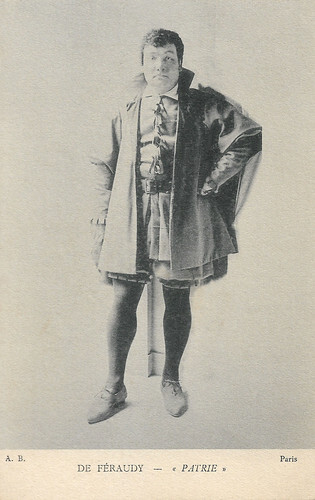
French postcard by A.B., Paris. Maurice de Féraudy in the play 'Patrie!' (1869) by Victorien Sardou.
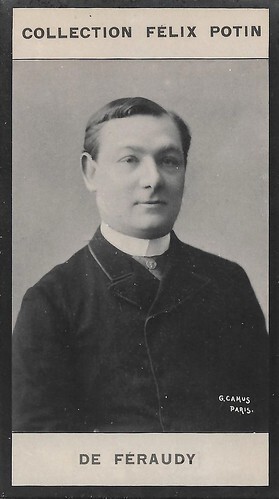
French minicard (collector's card) in the Collection Félix Potin, series 1 (c. 1900). Photo: G. Camus, Paris.
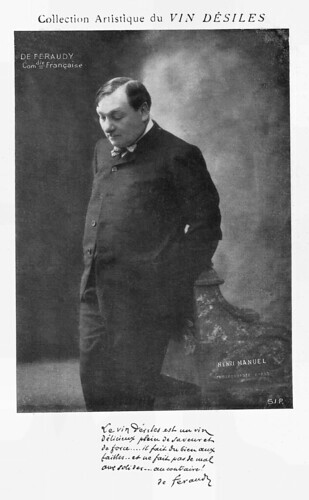
French postcard in the Collection Artistique du Vin Désiles by S.I.P. Photo: Henri Manuel. Caption: 'Vin Désiles is a delicious wine, full of taste and vigour. While it does well to the weak, it means no harm to the solid ones, on the contrary!'

French postcard in the Collection Artistique du Vin Désiles by S.I.P. Photo: Henri Manuel. Caption: 'Vin Désiles is a delicious wine, full of taste and vigour. While it does well to the weak, it means no harm to the solid ones, on the contrary!'
Memorable roles
In 1908-1909, Maurice de Féraudy debuted in the cinema. He directed almost 40 shorts under the aegis of his short-lived company Théâtro-Films. His son Jacques made his first film appearances in two of these films, Simple histoire/Simple story (1908) and Georgette (1908).
Afterwards, Féraudy directed a handful of mostly short films at Pathé and Gaumont, with actors who would later become famous, such as Albert Dieudonné , Roger Karl, Maria Falconetti and Jean Angelo . Féraudy last’s direction was the film Après lui/After him (1918) in which he had the lead himself. While most of the films he directed are forgotten now, better known are the films in which he acted.
In the 1910s Féraudy played in films at Eclair, such as Les gaités de l’escadron/The Gaieties of the Squadron (Joseph Faivre, Maurice Tourneur, 1913), La dame de Monsoreau/The lady Monsoreau (Emile Chautard, 1913), and Monsieur Lecoq (Maurice Tourneur, 1914).
In the 1920s Féraudy enjoyed the pleasure of playing memorable roles despite his high age. After supporting roles in two films with René Hervil: L’ami Fritz/In Old Alsace (1921) and Blanchette (1921), both with Léon Mathot in the lead, Féraudy had the male lead himself together with young Jean Forest in Crainquebille/Coster Bill of Paris (Jacques Feyder, 1922). In this adaptation of a novel by Anatole France, Féraudy played an ageing street vendor who has worked all his life at Les Halles in Paris. Innocently he lands in jail and loses his customers once released, thus becoming an alcoholic. A young street boy (Forest) prevents him from suicide, though, convincing him to start all over again.
Next, Féraudy played the title role in the Honoré de Balzac adaptation Le Cousin Pons/Cousin Pons (Jacques Robert, 1923), about a musician and poor art collector who is befriended by a sympathetic German ( André Nox ). The human vultures around him, such as his wealthy parvenu lawyer cousins and his landlady, realise that he possesses a valuable art collection, and try to crush poor Pons.
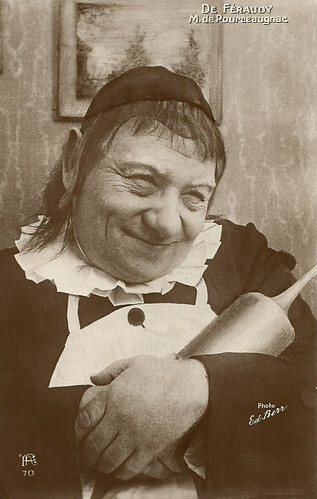
French postcard by PA, no. 70. Photo: Ed. Berr. Maurice de Féraudy as the apothecary in the Molière comedy 'Monsieur de Pourceaugnac'. This part had been his breakthrough in 1887.
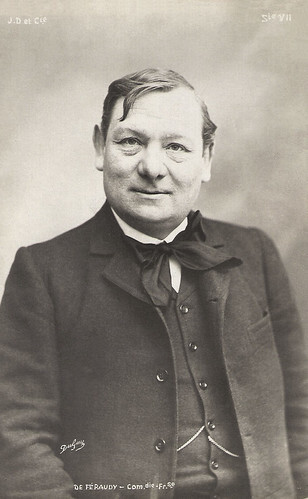
French postcard by J.D, et Cie, Serie VII. Photo: DuGuy. Caption: De Féraudy, Comédie Française.
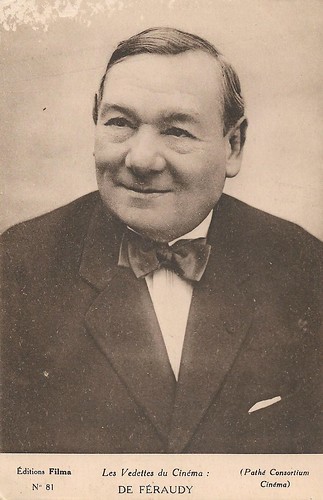
French postcard in the Les Vedettes du Cinéma series by Editions Filma, no. 81. Photo: Pathé Consortium Cinéma.
Cleared from slander
Maurice de Féraudy next played in Le secret de Polichinelle/The Secret of Polichinelle (René Hervil, 1923) about a young man who wants to marry a working-class girl ( Andrée Brabant ) against the wishes of his parents, and Le Coeur des gueux/Heart beggars (Alfred Machin, Henri Wulschleger, 1925) with Ginette Maddie.
He then appeared in the Danish film Klovne/The Clown (Anders Sandberg, 1926) with Gösta Ekman and Karina Bell , Lady Harrington (Fred Leroy-Granville, H.C. Grantham-Hayes, 1926) with Claude France and Warwick Ward , Fleur d’amour/Love Flower (Marcel Vandal, 1927) in which Féraudy had the male lead opposite Rose Mai, and the German film Die Hölle von Montmartre/The Hell of Montmartre (Willy Reiber, Franz Seitz, 1928) with Eric Barclay and Suzy Vernon .
A last memorable part was de Féraudy’s role in the tragicomedy Les Deux timides/Two Timid Souls (René Clair, 1928) in which Pierre Batcheff plays Frémissin, a timid young lawyer who loves Cécile (Vera Flory) whose father (Féraudy) suffers from the same timidity. When because of his weak defence a brutal husband is sentenced, the latter ( Jim Gérald ) uses all means to wreck the young lawyer’s own future marriage with Cécile, as he wants her for himself. Helped by his future father-in-law, Frémissin triumphs and clears his father-in-law and himself from all slander.
After one last part in the early French sound film Ça aussi! … c’est Paris/That too! This is Paris (Antoine Mourre, 1930), de Féraudy retired. He still acted on stage and was even highly successful in 'Cette vieille canaille' (That old scoundrel) in 1931-1932.
Maurice de Féraudy died in Paris in 1932 and was buried at the cemetery of Montparnasse. He was the father of Jacques de Féraudy (1886-1971), who was an actor as well.
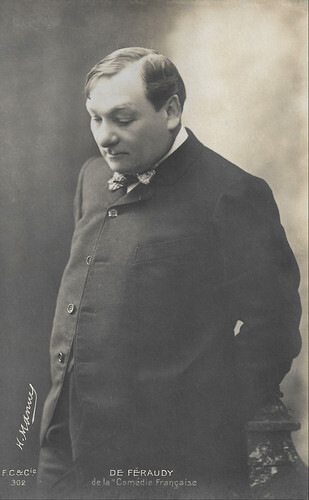
French postcard by F.C. & Cie., no. 302. Photo: Henri Manuel. Caption: Maurice de Féraudy de la Comédie Française.
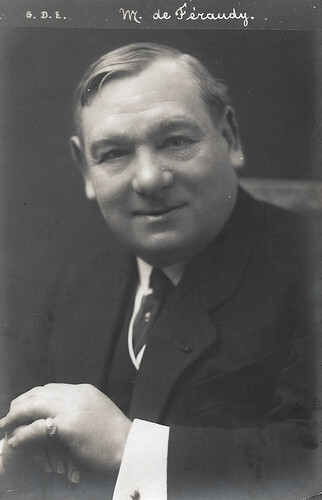
Belgian postcard by G.D.E. (G. Dupont-Emera), Bruxelles.
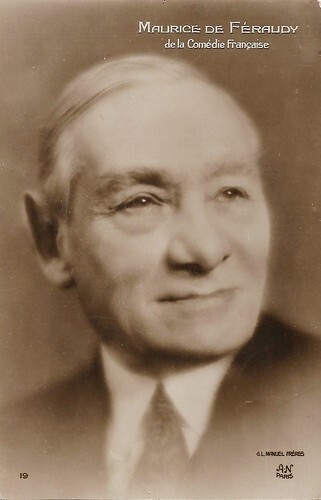
French postcard by A.N., Paris, no. 19. Photo: G.L. Manuel Frères. Caption: Maurice de Féraudy de la Comédie Française.
Sources: Ciné Ressources, dvdtoile, Le Petit Parisien, Wikipedia (French and English) and .

French postcard in the series Nos Artistes dans leur loge, no. 131. Photo: Comoedia.

French postcard by Croissant, Paris, no. 3523. Photo Henri Manuel. Written date: 1909. Caption: De Féraudy de la Comédie Française.

French postcard by J.D, et Cie, 3e Serie. Photo: DuGuy. Caption: De Féraudy, Comédie Française.

French postcard by Editions Cinémagazine, no. 418. Photo: Sartony.
A pupil of Got
Dominique Marie Maurice de Féraudy was born in Joinville-le-Pont near Paris in 1859. His father was the commander of the Ecole militaire de gymnastique at Joinville-le-Pont.
After the Conservatoire, where he was a pupil of Got, Maurice entered the Théâtre Français in 1880. In 1887, the role of the apothecary in the Molière comedy 'Monsieur de Pourceaugnac' was his breakthrough. That year, he became ‘sociétaire’ of the Comédie-Française, and in 1929 he became ‘doyen’ (dean), but he left that same year.
Maurice de Féraudy was much acclaimed as a comedian, because of his cheerful performances. The role of his life, which he performed some 1,200 times within 30 years – and had the monopoly on it – was that of Isidore Lechat in 'Les affaires sont les affaires' (Business is business) by Octave Mirbeau (1903). Between 1896 and 1905, Féraudy taught at the Conservatoire, training upcoming actors like Gabriel Signoret .
Other plays he acted in were by a.o. Henri Bataille, Henri Kistemaeckers, Sacha Guitry , Henrik Ibsen, but also classics by Molière, Honoré de Balzac and Alexandre Dumas fils . With two plays by Molière, he toured Quebec, Montreal and New York in 1922, as part of the Comedy Française.
De Féraudy also wrote numerous songs for Paulette Darty, such as the famous 'Fascination' (1901), reprised afterwards by Suzy Delair and Diane Dufresne. Translated into English, this song became an international hit after the Second World War, performed by Nat King Cole among others.

French postcard by A.B., Paris. Maurice de Féraudy in the play 'Patrie!' (1869) by Victorien Sardou.

French minicard (collector's card) in the Collection Félix Potin, series 1 (c. 1900). Photo: G. Camus, Paris.

French postcard in the Collection Artistique du Vin Désiles by S.I.P. Photo: Henri Manuel. Caption: 'Vin Désiles is a delicious wine, full of taste and vigour. While it does well to the weak, it means no harm to the solid ones, on the contrary!'

French postcard in the Collection Artistique du Vin Désiles by S.I.P. Photo: Henri Manuel. Caption: 'Vin Désiles is a delicious wine, full of taste and vigour. While it does well to the weak, it means no harm to the solid ones, on the contrary!'
Memorable roles
In 1908-1909, Maurice de Féraudy debuted in the cinema. He directed almost 40 shorts under the aegis of his short-lived company Théâtro-Films. His son Jacques made his first film appearances in two of these films, Simple histoire/Simple story (1908) and Georgette (1908).
Afterwards, Féraudy directed a handful of mostly short films at Pathé and Gaumont, with actors who would later become famous, such as Albert Dieudonné , Roger Karl, Maria Falconetti and Jean Angelo . Féraudy last’s direction was the film Après lui/After him (1918) in which he had the lead himself. While most of the films he directed are forgotten now, better known are the films in which he acted.
In the 1910s Féraudy played in films at Eclair, such as Les gaités de l’escadron/The Gaieties of the Squadron (Joseph Faivre, Maurice Tourneur, 1913), La dame de Monsoreau/The lady Monsoreau (Emile Chautard, 1913), and Monsieur Lecoq (Maurice Tourneur, 1914).
In the 1920s Féraudy enjoyed the pleasure of playing memorable roles despite his high age. After supporting roles in two films with René Hervil: L’ami Fritz/In Old Alsace (1921) and Blanchette (1921), both with Léon Mathot in the lead, Féraudy had the male lead himself together with young Jean Forest in Crainquebille/Coster Bill of Paris (Jacques Feyder, 1922). In this adaptation of a novel by Anatole France, Féraudy played an ageing street vendor who has worked all his life at Les Halles in Paris. Innocently he lands in jail and loses his customers once released, thus becoming an alcoholic. A young street boy (Forest) prevents him from suicide, though, convincing him to start all over again.
Next, Féraudy played the title role in the Honoré de Balzac adaptation Le Cousin Pons/Cousin Pons (Jacques Robert, 1923), about a musician and poor art collector who is befriended by a sympathetic German ( André Nox ). The human vultures around him, such as his wealthy parvenu lawyer cousins and his landlady, realise that he possesses a valuable art collection, and try to crush poor Pons.

French postcard by PA, no. 70. Photo: Ed. Berr. Maurice de Féraudy as the apothecary in the Molière comedy 'Monsieur de Pourceaugnac'. This part had been his breakthrough in 1887.

French postcard by J.D, et Cie, Serie VII. Photo: DuGuy. Caption: De Féraudy, Comédie Française.

French postcard in the Les Vedettes du Cinéma series by Editions Filma, no. 81. Photo: Pathé Consortium Cinéma.
Cleared from slander
Maurice de Féraudy next played in Le secret de Polichinelle/The Secret of Polichinelle (René Hervil, 1923) about a young man who wants to marry a working-class girl ( Andrée Brabant ) against the wishes of his parents, and Le Coeur des gueux/Heart beggars (Alfred Machin, Henri Wulschleger, 1925) with Ginette Maddie.
He then appeared in the Danish film Klovne/The Clown (Anders Sandberg, 1926) with Gösta Ekman and Karina Bell , Lady Harrington (Fred Leroy-Granville, H.C. Grantham-Hayes, 1926) with Claude France and Warwick Ward , Fleur d’amour/Love Flower (Marcel Vandal, 1927) in which Féraudy had the male lead opposite Rose Mai, and the German film Die Hölle von Montmartre/The Hell of Montmartre (Willy Reiber, Franz Seitz, 1928) with Eric Barclay and Suzy Vernon .
A last memorable part was de Féraudy’s role in the tragicomedy Les Deux timides/Two Timid Souls (René Clair, 1928) in which Pierre Batcheff plays Frémissin, a timid young lawyer who loves Cécile (Vera Flory) whose father (Féraudy) suffers from the same timidity. When because of his weak defence a brutal husband is sentenced, the latter ( Jim Gérald ) uses all means to wreck the young lawyer’s own future marriage with Cécile, as he wants her for himself. Helped by his future father-in-law, Frémissin triumphs and clears his father-in-law and himself from all slander.
After one last part in the early French sound film Ça aussi! … c’est Paris/That too! This is Paris (Antoine Mourre, 1930), de Féraudy retired. He still acted on stage and was even highly successful in 'Cette vieille canaille' (That old scoundrel) in 1931-1932.
Maurice de Féraudy died in Paris in 1932 and was buried at the cemetery of Montparnasse. He was the father of Jacques de Féraudy (1886-1971), who was an actor as well.

French postcard by F.C. & Cie., no. 302. Photo: Henri Manuel. Caption: Maurice de Féraudy de la Comédie Française.

Belgian postcard by G.D.E. (G. Dupont-Emera), Bruxelles.

French postcard by A.N., Paris, no. 19. Photo: G.L. Manuel Frères. Caption: Maurice de Féraudy de la Comédie Française.
Sources: Ciné Ressources, dvdtoile, Le Petit Parisien, Wikipedia (French and English) and .
Published on March 27, 2023 22:00
Paul van Yperen's Blog
- Paul van Yperen's profile
- 13 followers
Paul van Yperen isn't a Goodreads Author
(yet),
but they
do have a blog,
so here are some recent posts imported from
their feed.



